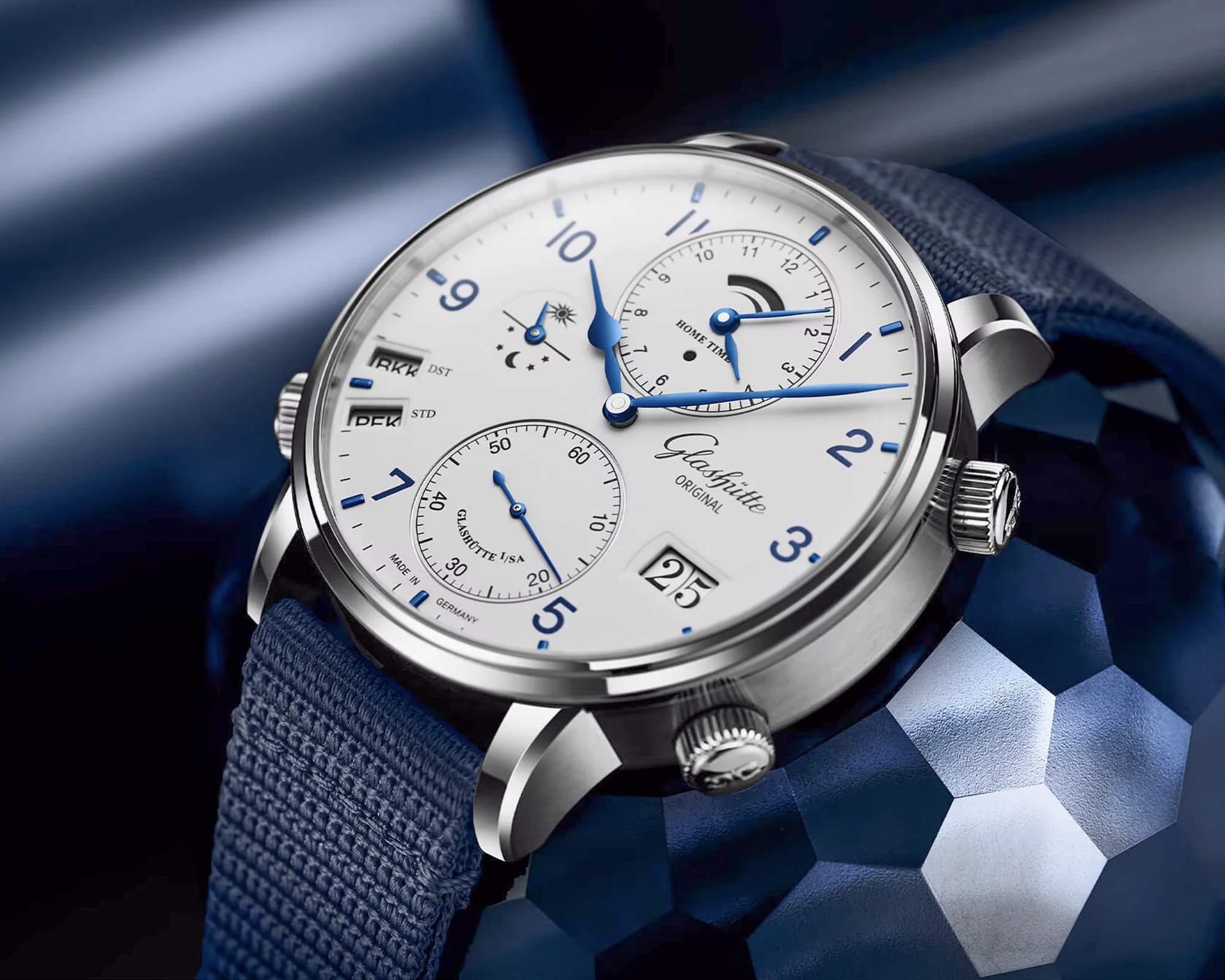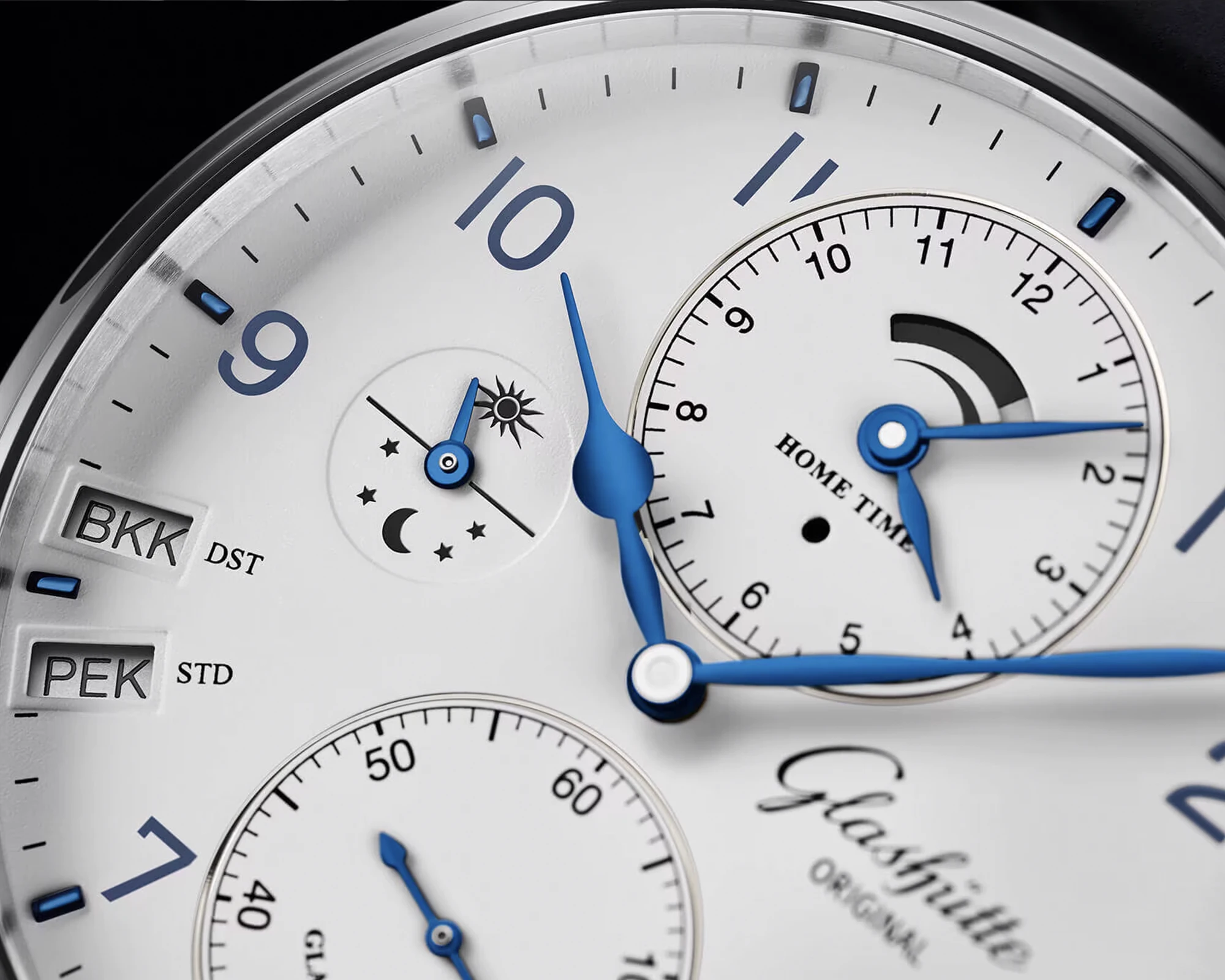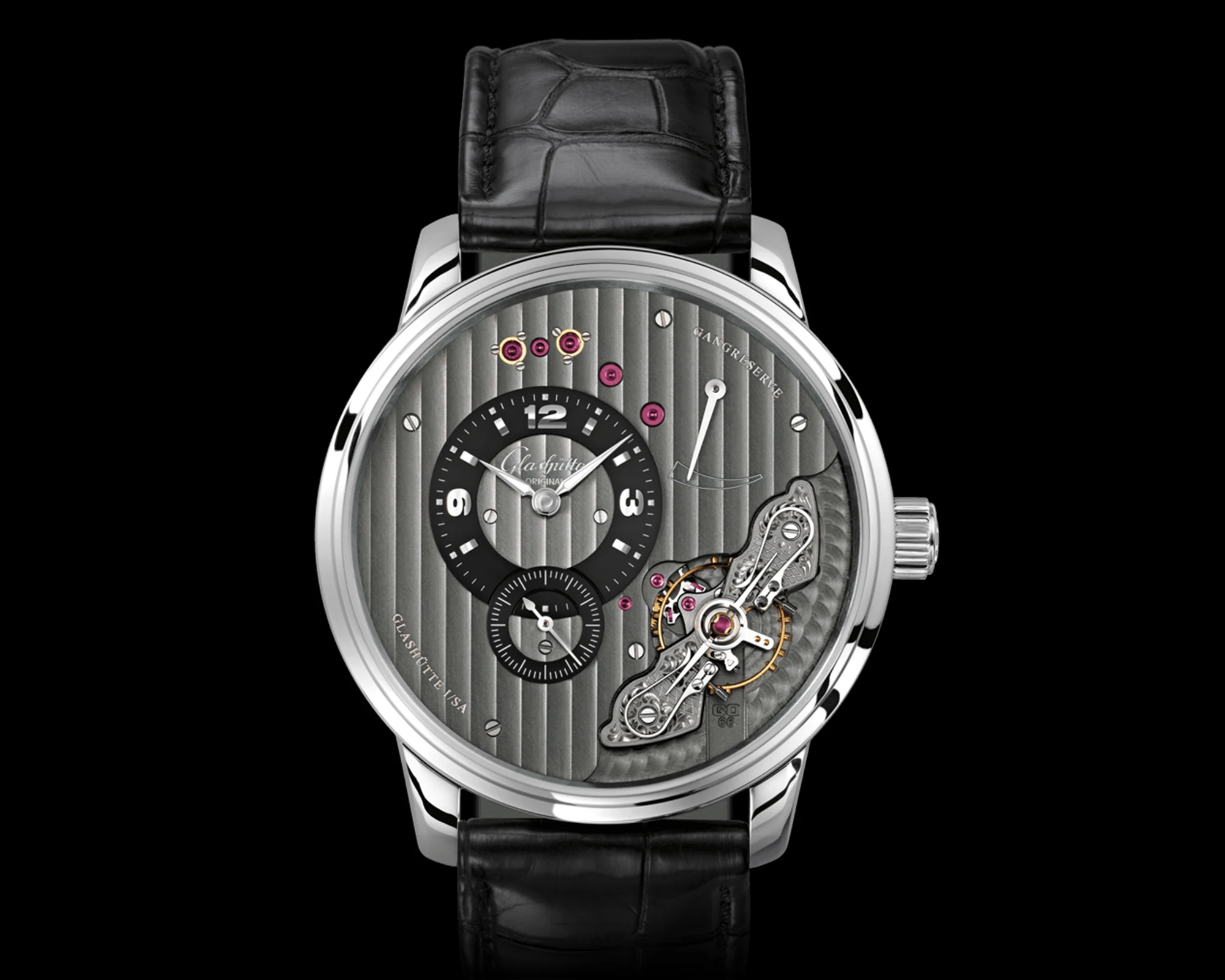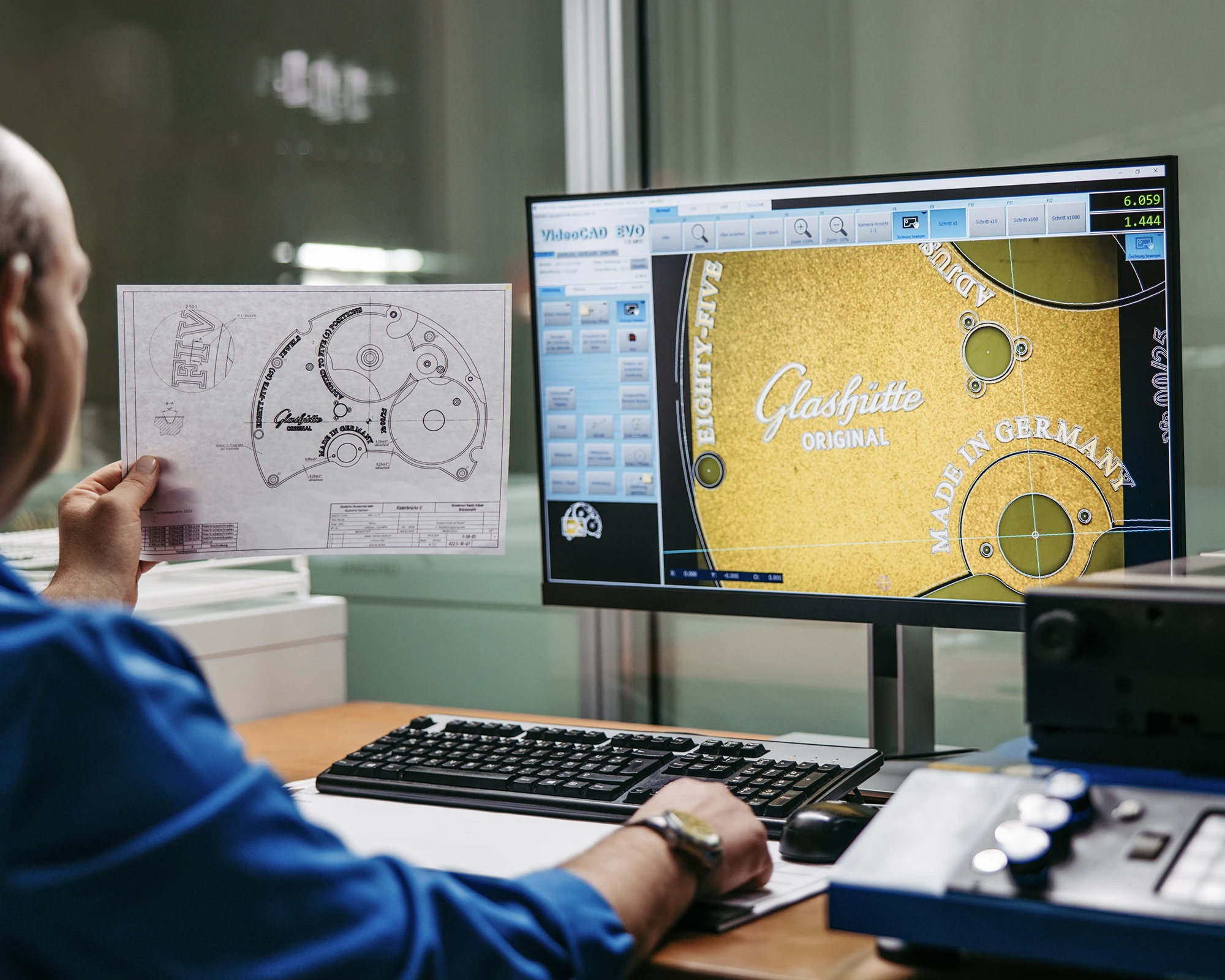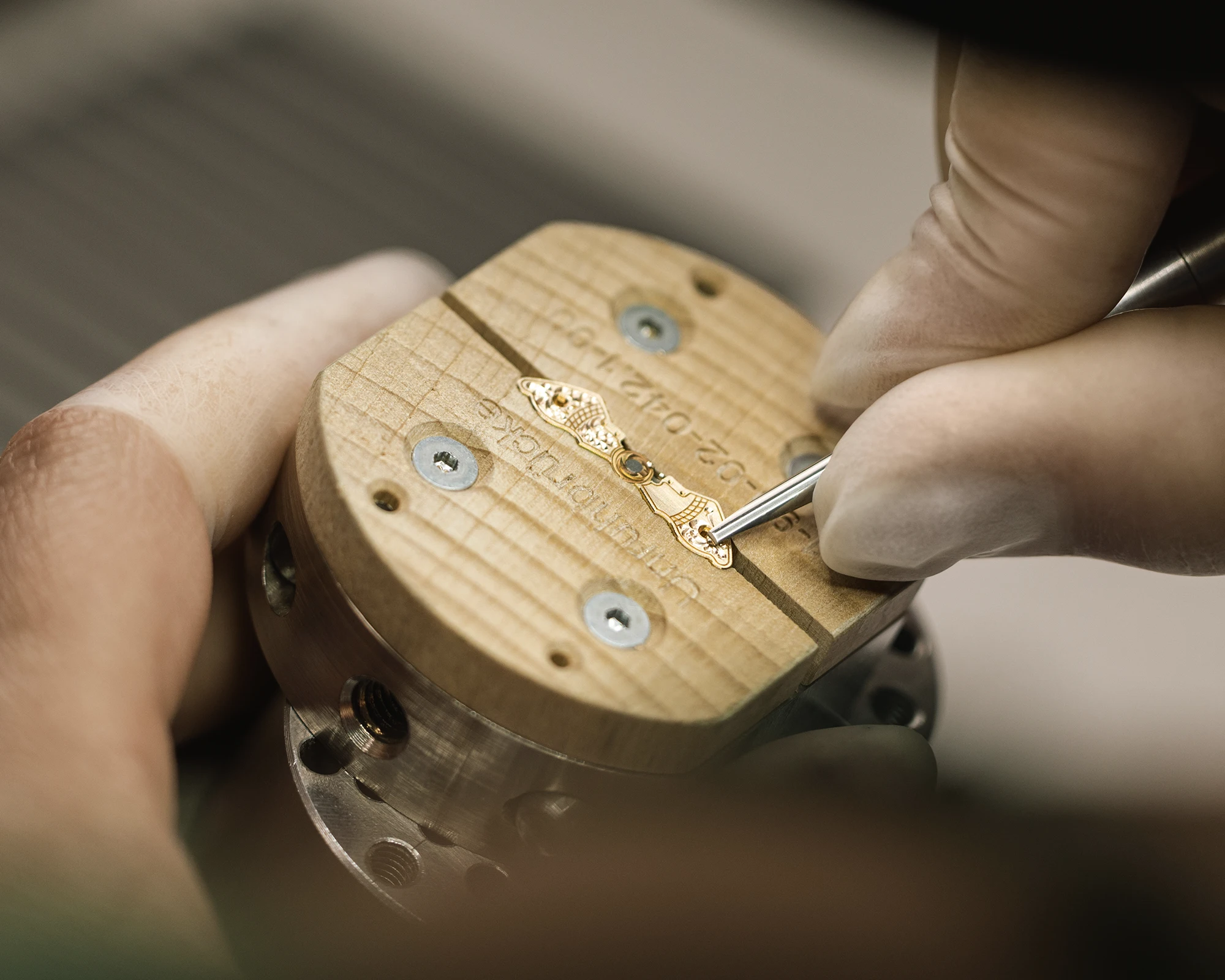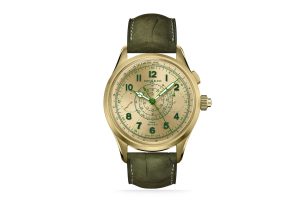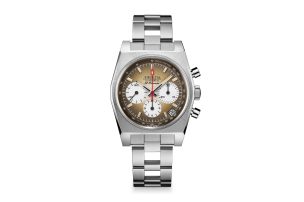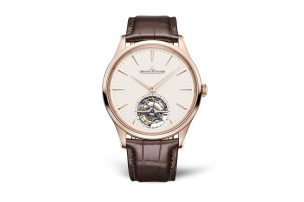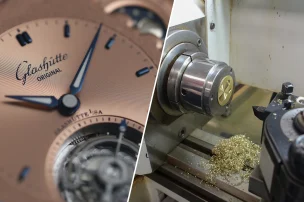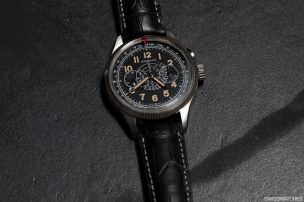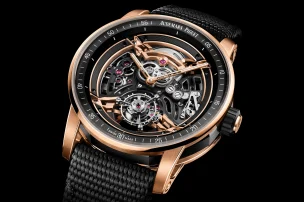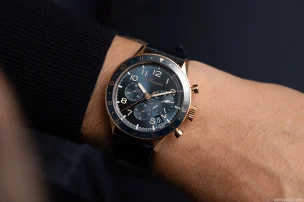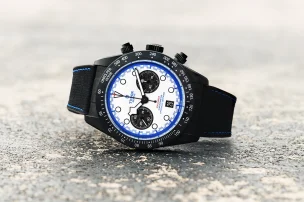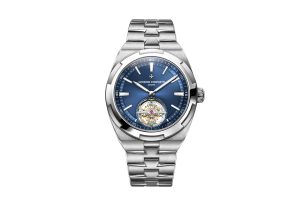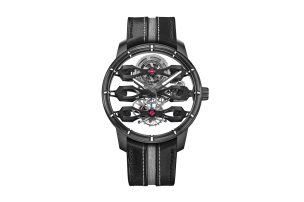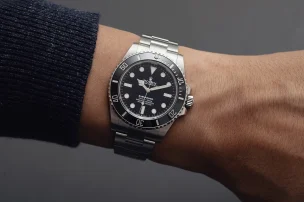

Paying a Visit to Glashütte Original: The Original German Manufacture
The German manufacture Glashütte Original has firmly earned its place alongside some of the most reputable of Swiss brands. Glashütte Original combines traditional watchmaking and craftsmanship with the almost implausible ability to adapt to new economic, political and cultural conditions.
These lines were not written by the author of this text, but by the CEO and head of the Swatch Group, Nick Hayek, himself, when he wrote a foreword to the book ‘Impressions’ in 2015, which the manufacture published to mark 170 years of watchmaking in Saxony. The words are interesting because they are not just an assertion, but rather fact.
Returning to the place where creative power in watchmaking never dies
Almost ten years have passed since then, and Glashütte Original has long since outgrown comparisons with Swiss brands, and now enjoys the greatest independence within the Swatch Group: next year, the Saxon town of Glashütte will be celebrating an incredible 180 years of fine watchmaking. The author of this article had the honour of writing a chapter in the book about marine chronometers and observation watches from Glashütte, which the Norwegian Roald Amundsen carried with him when he became the first man to conquer the South Pole. Ten years ago, the hype surrounding mechanical watches was just picking up speed. It is a return to a place where the curiosity and creativity of its people never seems to cease.
The saviour of Swiss watchmaking helps the Germans make a comeback
Looking back, great successes are always easy to explain, but what impressed me about this foreword is the fact that Nick Hayek honours his visionary father in this book, who made a decisive contribution to saving German fine watchmaking with the takeover of Glashütte Original in 2000. At the turn of the millennium, the world of mechanical watches was much smaller than it is today and Germany had long since ceased to be a hotspot for fine precision mechanics. Hayek wrote: ‘My father decided to include Glashütte Original in the Swatch Group’s family of brands because he intuitively understood the nature of the manufacture and its environment.’
A visionary named Nicolas G. Hayek
How right his father, the truly visionary Nicolas G. Hayek, was. That legendary saviour of fine Swiss watchmaking, who can somehow also be considered its new founder, or at least its new inventor. And in the case of Glashütte Original, he was proved right: today, there are still only a handful of genuine manufactures in Germany, but the most important ones with an international reputation all come from the small Saxon town, whose name this company bears. Among them are some that refer to famous people and others that produce large quantities, but there is only one Glashütte Original. This is the story of this exceptional manufacture.
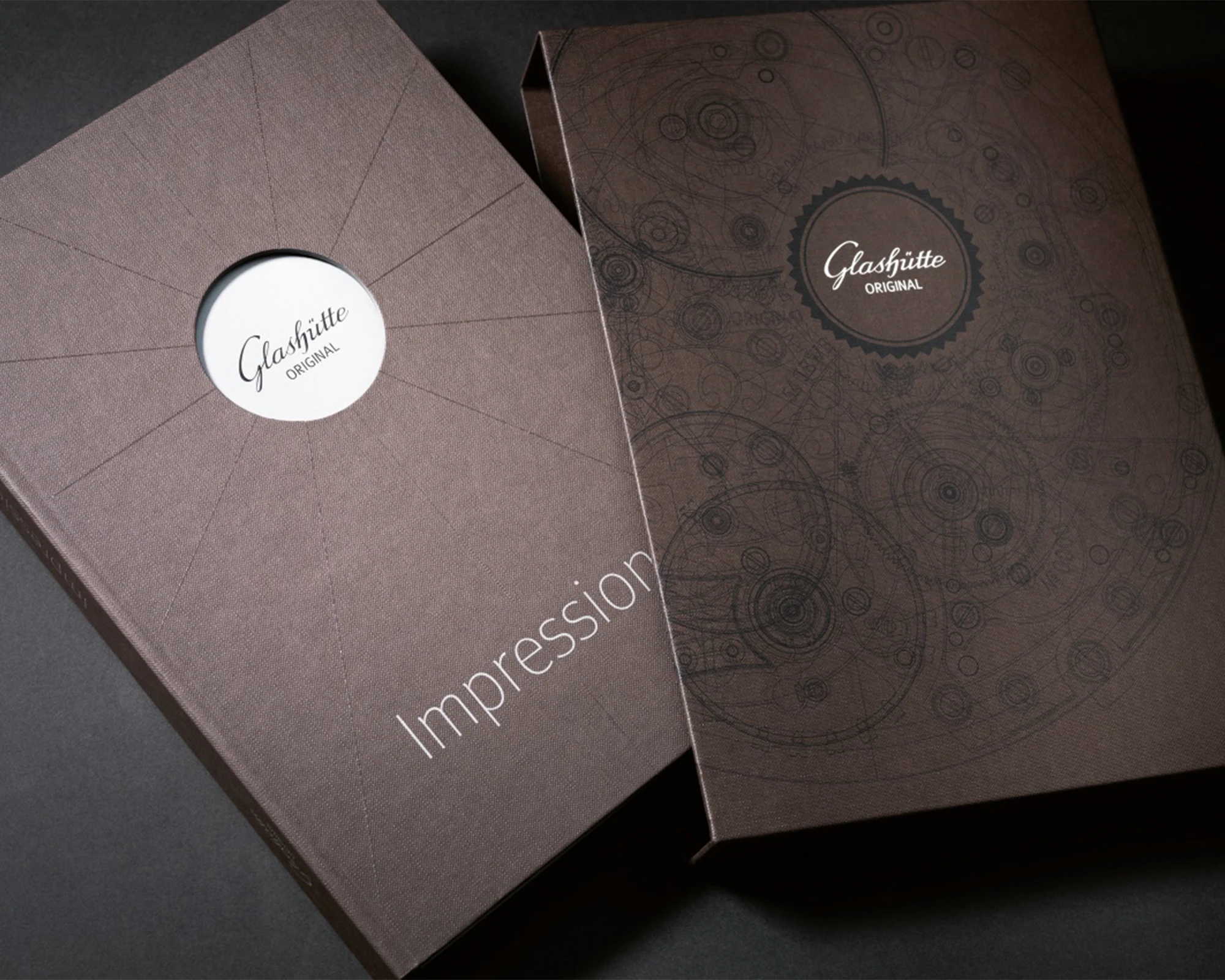
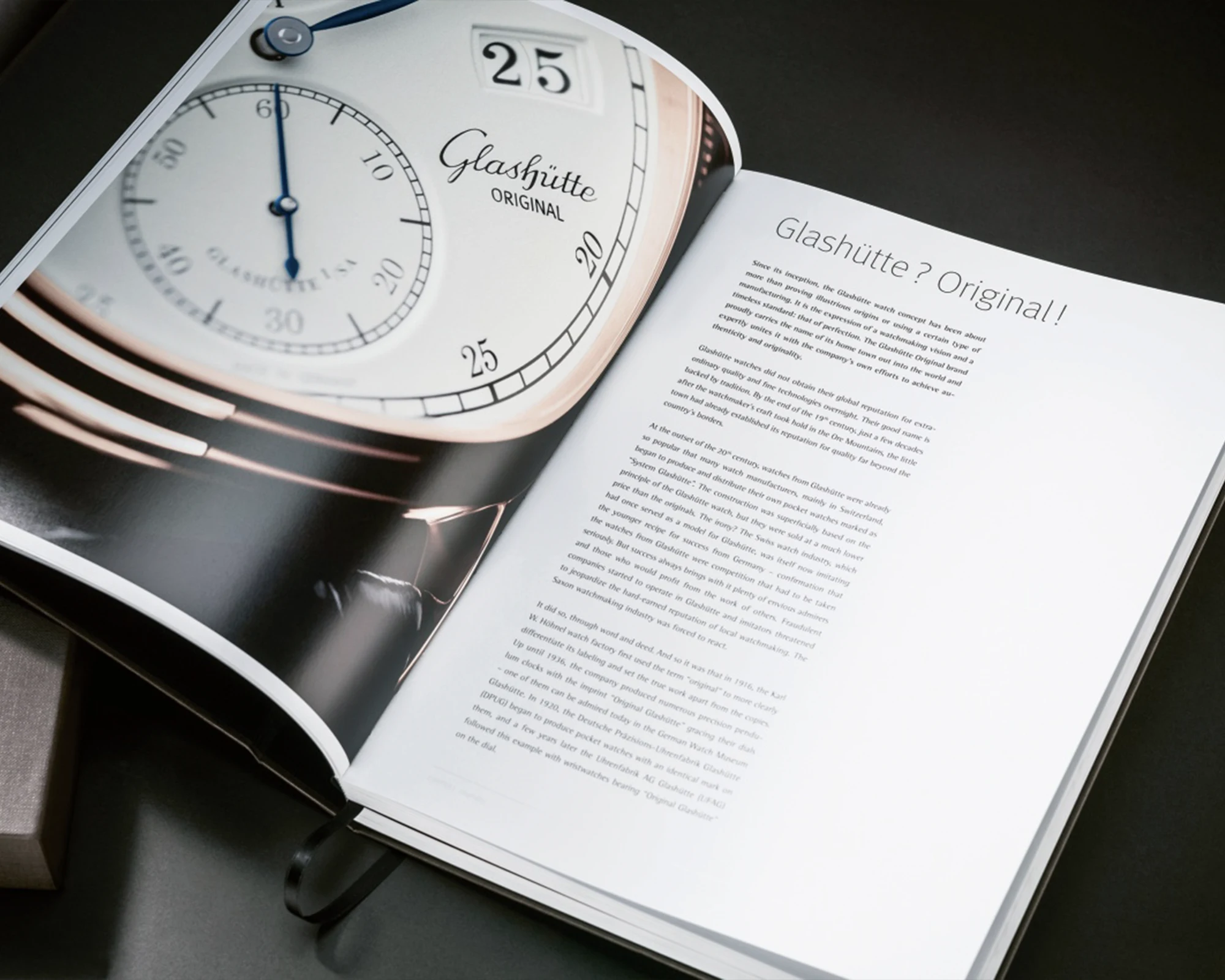
On the hour-long journey from the famous city of Dresden to the tiny Saxon town of Glashütte, which is still only known to watch collectors, I have to think about why so few companies that produce luxury watches have been consistently successful in the long term.
Between the poles of preservation and renewal
It seems so simple if you just talk to collectors and auction experts, who say that the secret recipe is to always remain true to yourself and your traditions while remaining innovative and exciting for your customers. As simple as it sounds, it seems to remain one of the greatest challenges for top manufactures in the entire luxury watch industry today. But it is precisely this tension between preservation and innovation that characterises great brands and products.
In particular, this tension describes the principle to which the two most famous houses, Rolex and Patek Philippe, have always remained true and which, over several generations, have risen to become the most stable luxury watch brands in the world.
At the end of this journey, I will have learnt one thing: Glashütte Original, the manufacture from Saxony, has taken on the legacy of all fine watchmaking in Saxony, and is in the process of becoming one of the biggest international collector’s brands. But more on that later.
A magnificent entrance hall reflects an impressive history
I enter the magnificent entrance hall in awe. Looking up into the 23-metre-high atrium, I can’t help but think of the main entrance to Patek Philippe in Geneva. The galleries here extend up to the fourth floor, where visitors can look deep into the individual production areas. This gigantic hall is not a display of watchmaking prowess or even a megalomaniacal marketing idea, but simply an architectural contemporary document of the former greatness of this manufacture from a time when mechanical wristwatches were a necessity and not a luxury. Today, sensitively restored after the flood of the century in 2002, the hall houses an exhibition of all current Glashütte Original models, around 100 references, all of which are manufactured at this historic site.


In the exclusive circle of fully integrated manufactures
Why do I emphasise this? Today, Glashütte Original belongs to the extremely exclusive circle of fully integrated manufacturers. What do we mean by this? The watch production process takes place almost entirely under this roof. The depth of production at Glashütte Original is unrivalled in Germany. From the smallest screw to the most complicated chronograph movement, from the tourbillon to the perpetual calendar, movements are manufactured, decorated and assembled by hand here at the highest level of vertical integration. Glashütte Original also specialises in the production of tools and devices in its in-house toolmaking department. This is also unrivalled in Germany. Today, the depth of production in this building includes all movement components apart from the balance spring, mainspring and jewels, including, for example, the complete production of specially blued screws as well as the manufacture of all gear wheels, the finest pinions and levers. Components such as the typical three-quarter plates are also elaborately rhodium-plated here in a dedicated electroplating department.
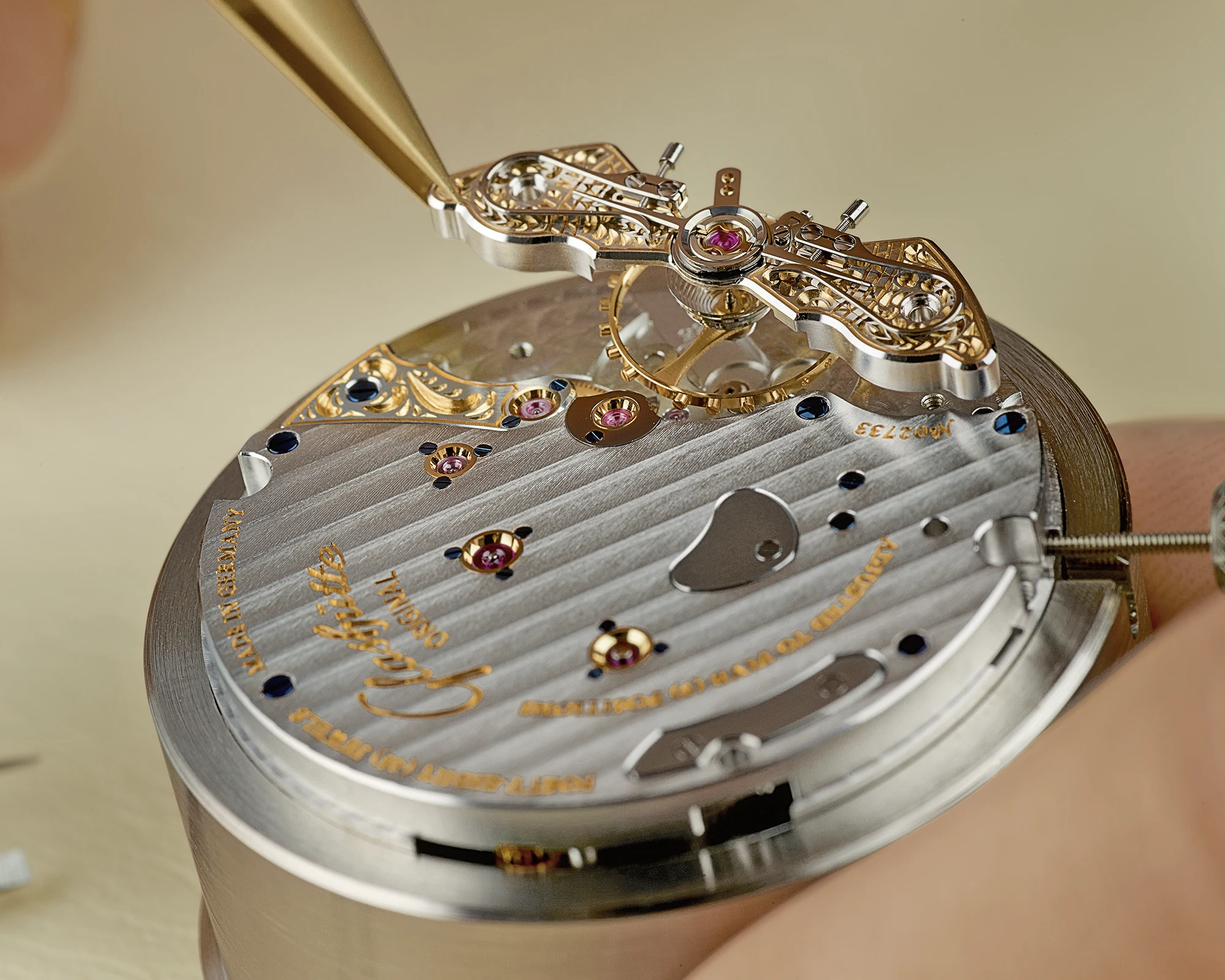
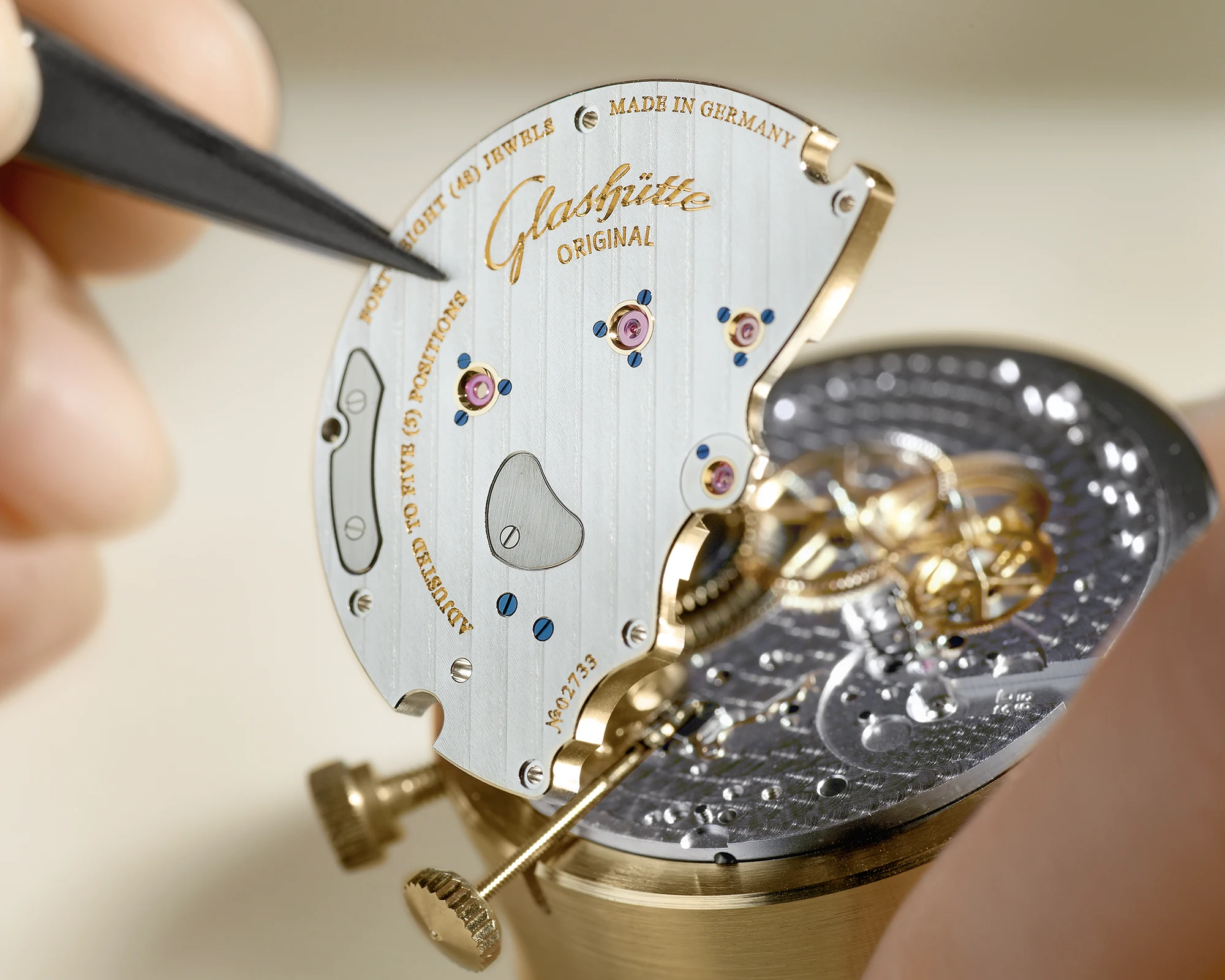
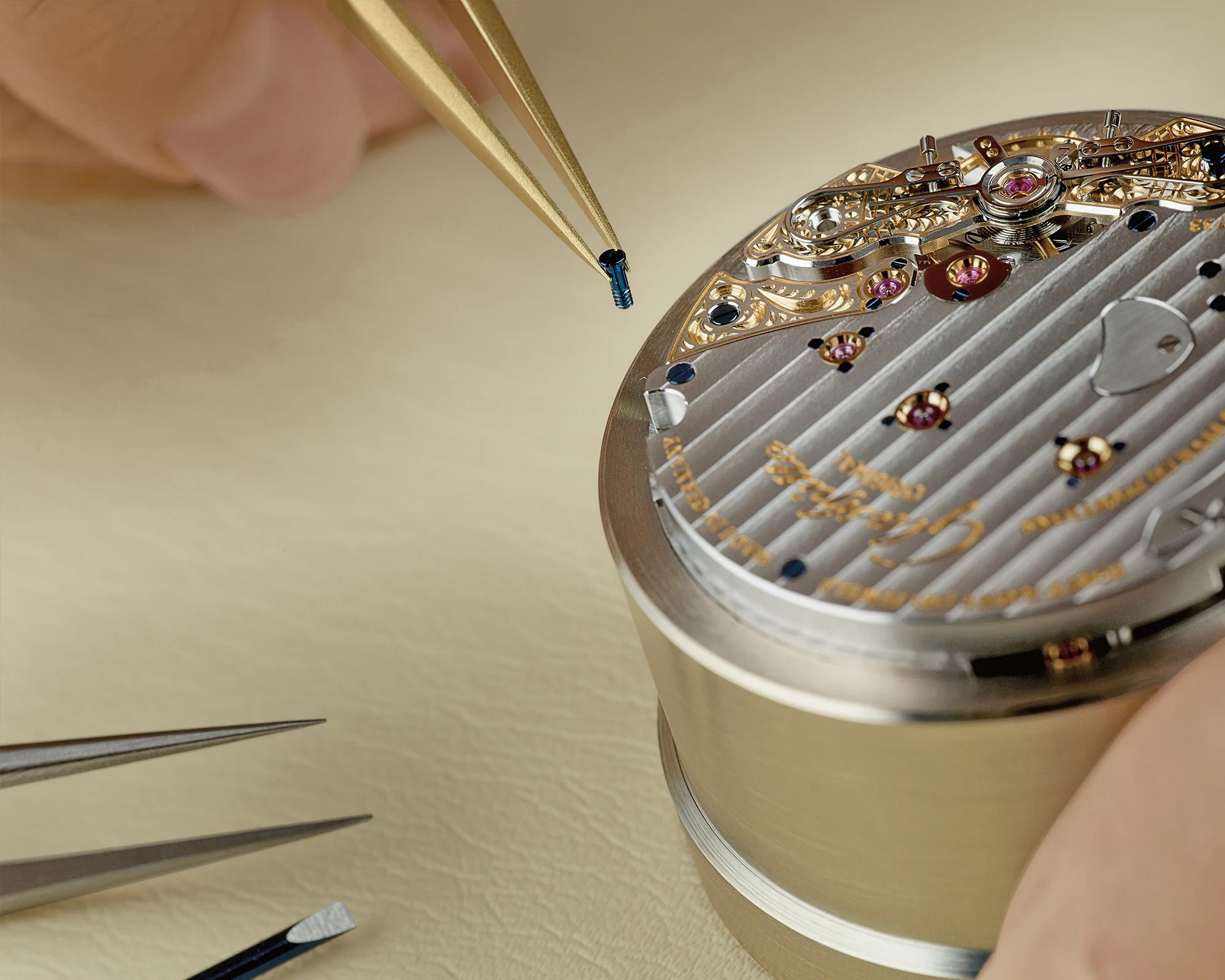
Glashütte Original even makes the dials itself
The manufacturing process, which I experience here over several hours, ranges from the development of the entire watches and of course their movements, their design, to the production and finishing of all components by hand, including the very elaborate finissage and polissage. The equally elaborate watch assembly is carried out by several dozen watchmakers, who subject all watches to extensive testing. But that’s not all: Glashütte Original has its own dial manufacture, with which it also has close historical ties. This is another speciality that only very few watch brands in the world can boast of.
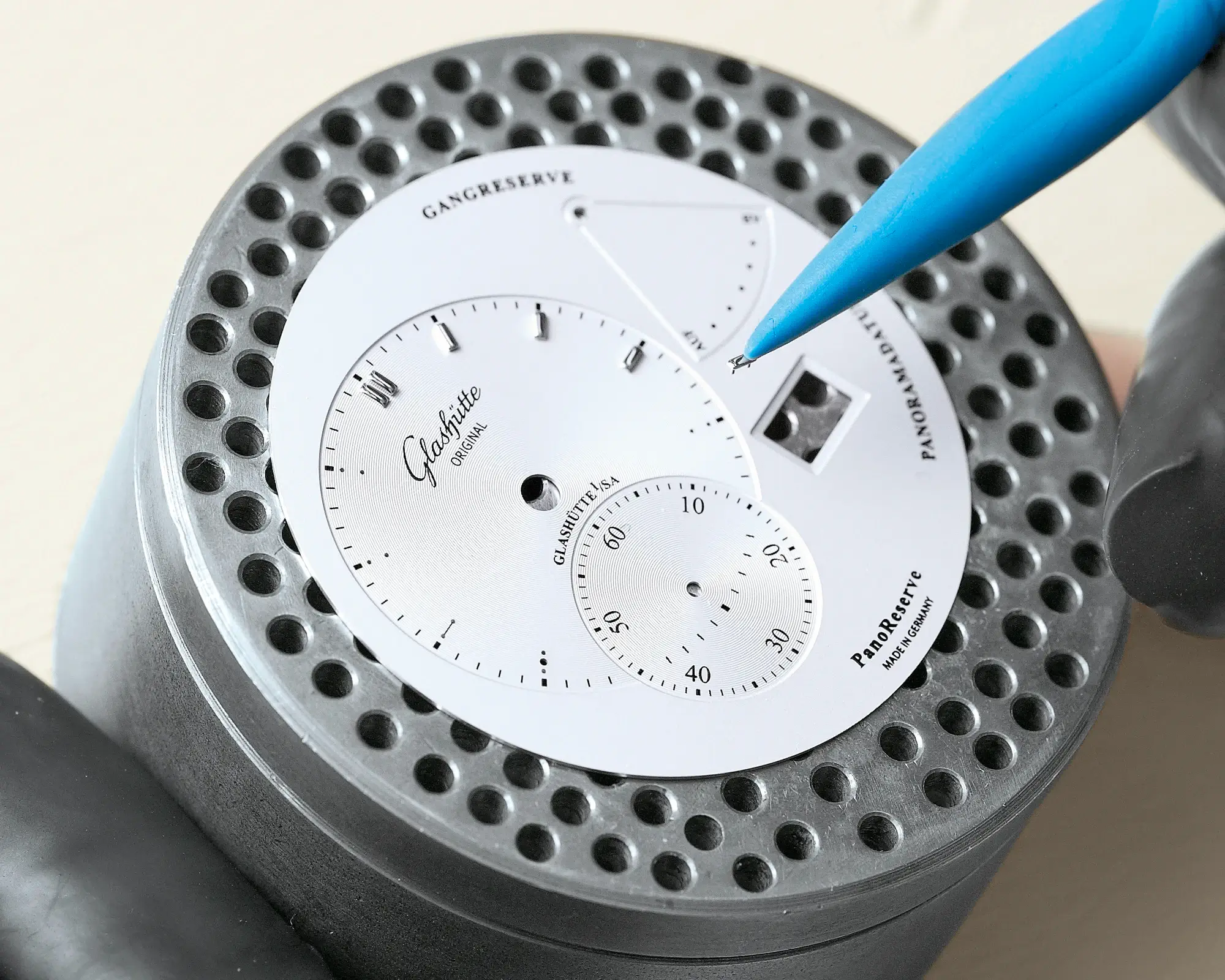
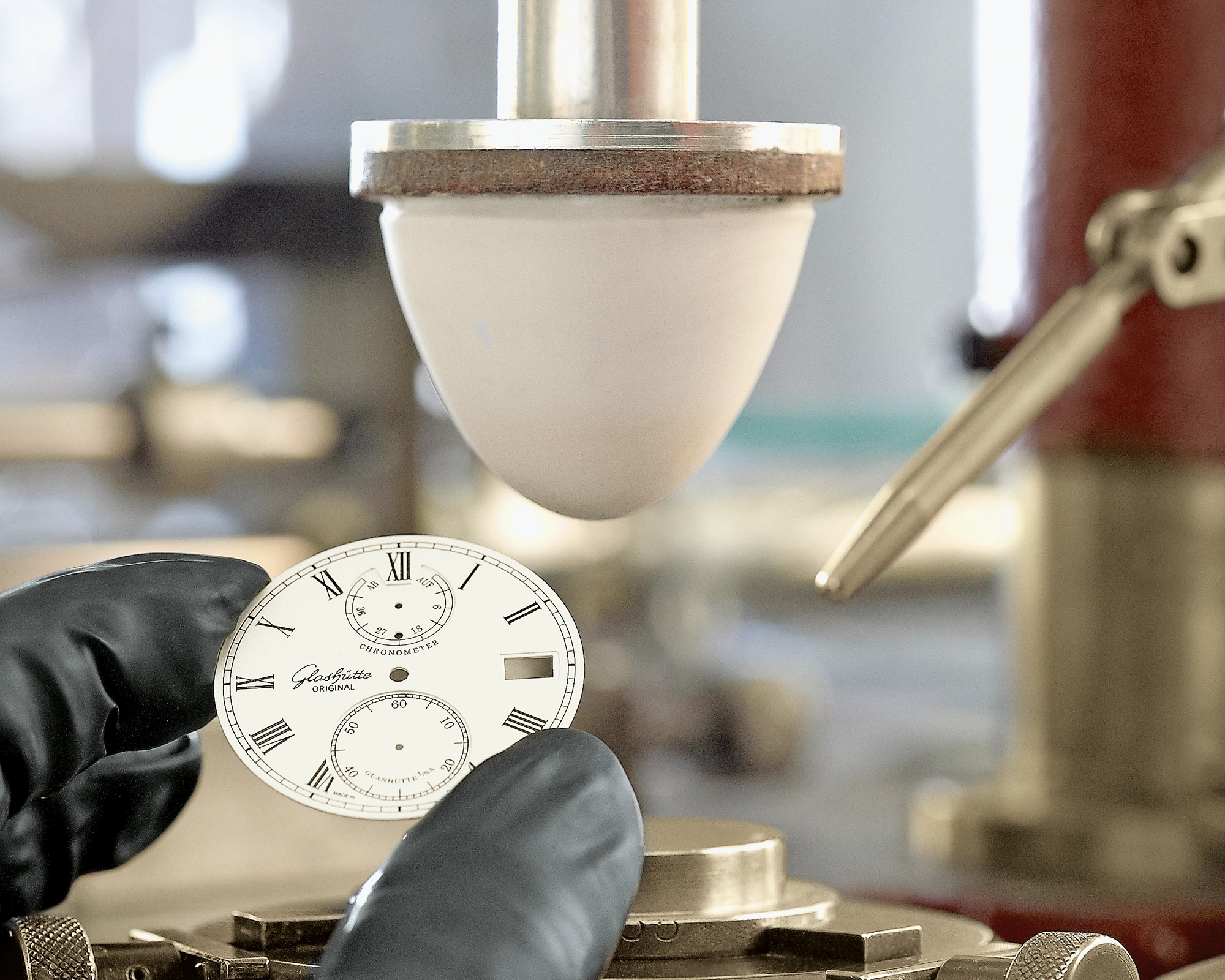
Over 95 percent in-house production
The vertical integration of this manufacture is therefore more than 95 percent. Today, several hundred employees produce several thousand watches a year, which are sold internationally via 18 of the company’s own boutiques and selected specialist retailers such as Bucherer and Wempe. Glashütte Original watches are currently available in over 40 countries around the world.
The brand as we know it celebrates its 30th anniversary
But the most astonishing thing about this company is that the Glashütte Original brand name has only existed since 1994, i.e. for 30 years. How could a manufacture in Germany build up something that took Rolex or Patek Philippe several generations? To find the answer, you have to delve, at least briefly, into the history of this particular manufacture.
The story is long – much longer than you might think
The history of Glashütte Original cannot be told quickly, as is the case with almost all large manufactures, but I will try nonetheless. Today’s Glashütte Original manufacture has, of course, not only existed since the relatively young brand name – it emerged from the former VEB Glashütter Uhrenbetrieb (abbreviated GUB), to which all watch manufacturers and suppliers were merged during the GDR era. Due to the political isolation from the world market (the GDR was behind the Iron Curtain for a long time and belonged to the Eastern Bloc under the leadership of the Soviet Union), the manufacture had to work as self-sufficiently as possible, and therefore controlled the production of all individual parts of mechanical watches with a huge machine complex – parts of these machines are still used today. Even then, the dials were manufactured in Pforzheim in West Germany in order to meet the high quality standards.
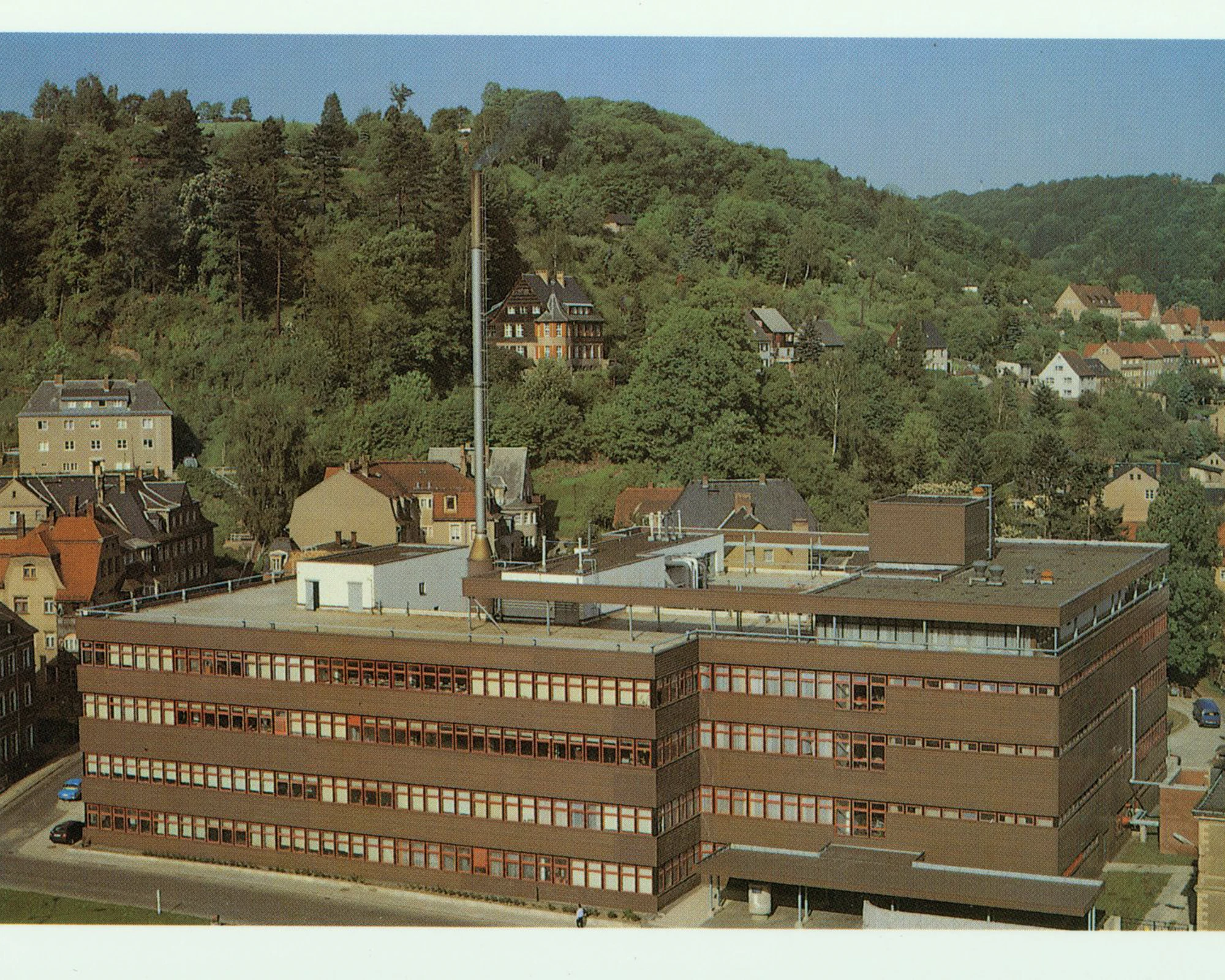
Credit © Archiv Deutsches Uhrenmuseum Glashütte
A wealth of experience amongst its employees
The necessity of the political division of Germany was turned into a virtue, and after the reunification of East and West Germany, the founding of numerous local manufactures would not have been possible without the high level of training of the former GUB employees and their wealth of experience. When Glashütter Uhrenbetrieb GmbH was entered in the commercial register on 16 October 1990, the company became the official legal successor to all former watchmaking companies and brands in Glashütte in reunified Germany, with the obligation to continue watch production on site.
1995: The first modern collection of mechanical wristwatches
It was not until 1994 that production was continued under the brand name Glashütte Original. The first modern collection of mechanical watches was launched in 1995. With the exception of the Pavonia ladies’ watch line, which is equipped with quartz calibres, the mechanical movements used are developed, designed and produced in Glashütte.
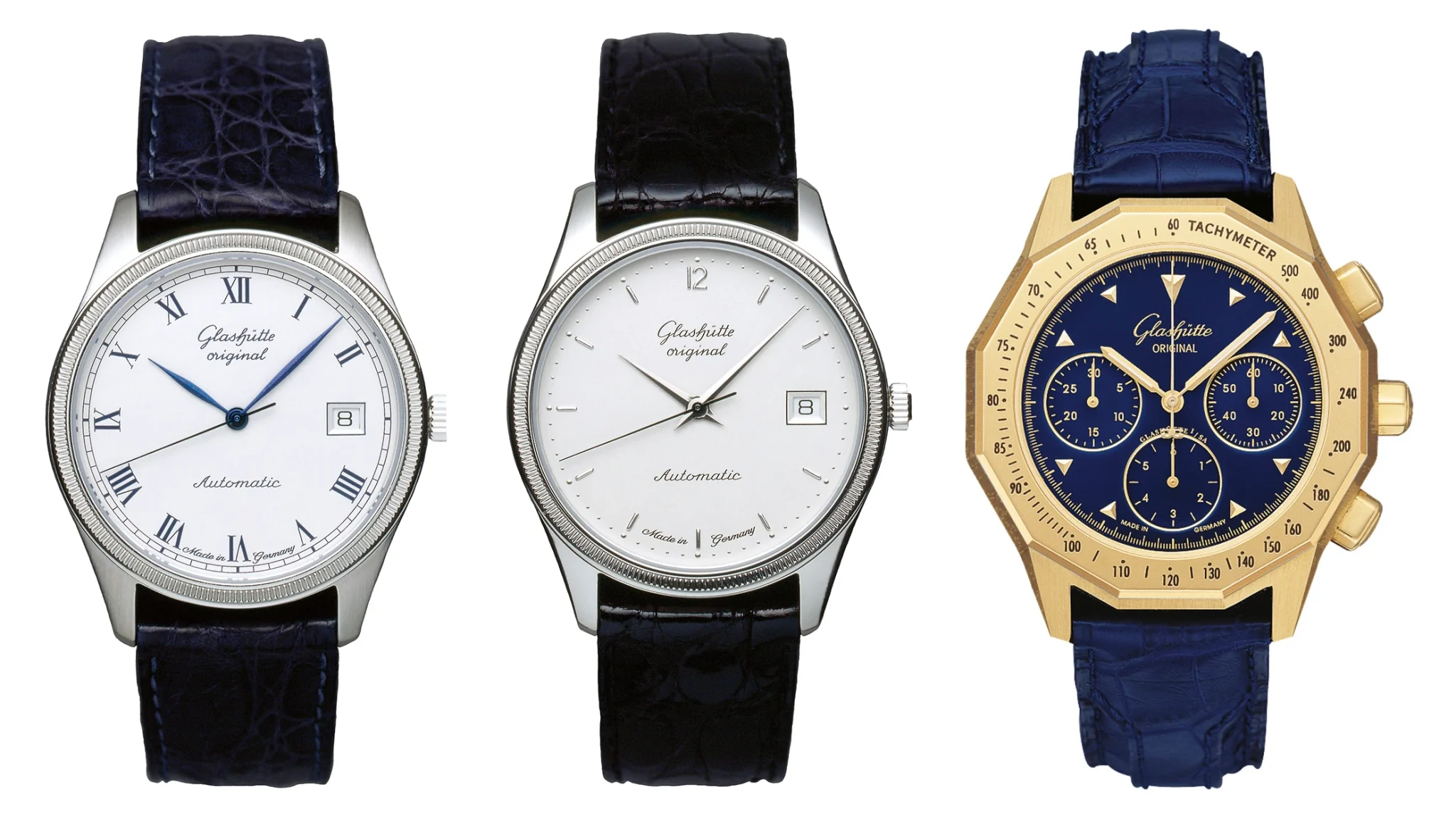
Credit © Archiv Deutsches Uhrenmuseum Glashütte
Where does the company name Glashütte Original come from?
The history of the brand name is as exciting as the manufacture itself. By the end of the 19th century, a few decades after watchmaking began in the Ore Mountains, the name of the small town had already established itself as a seal of quality far beyond the borders of Saxony and Germany.

Credit © Archiv Deutsches Uhrenmuseum Glashütte
A seal of quality to deter Swiss imitators
Ironically, it was at this time that some Swiss watch manufactures began to produce and advertise their own pocket watches labelled ‘System Glashütte’. However, the resourceful Swiss offered these – superficially similar – designs at a significantly lower price.
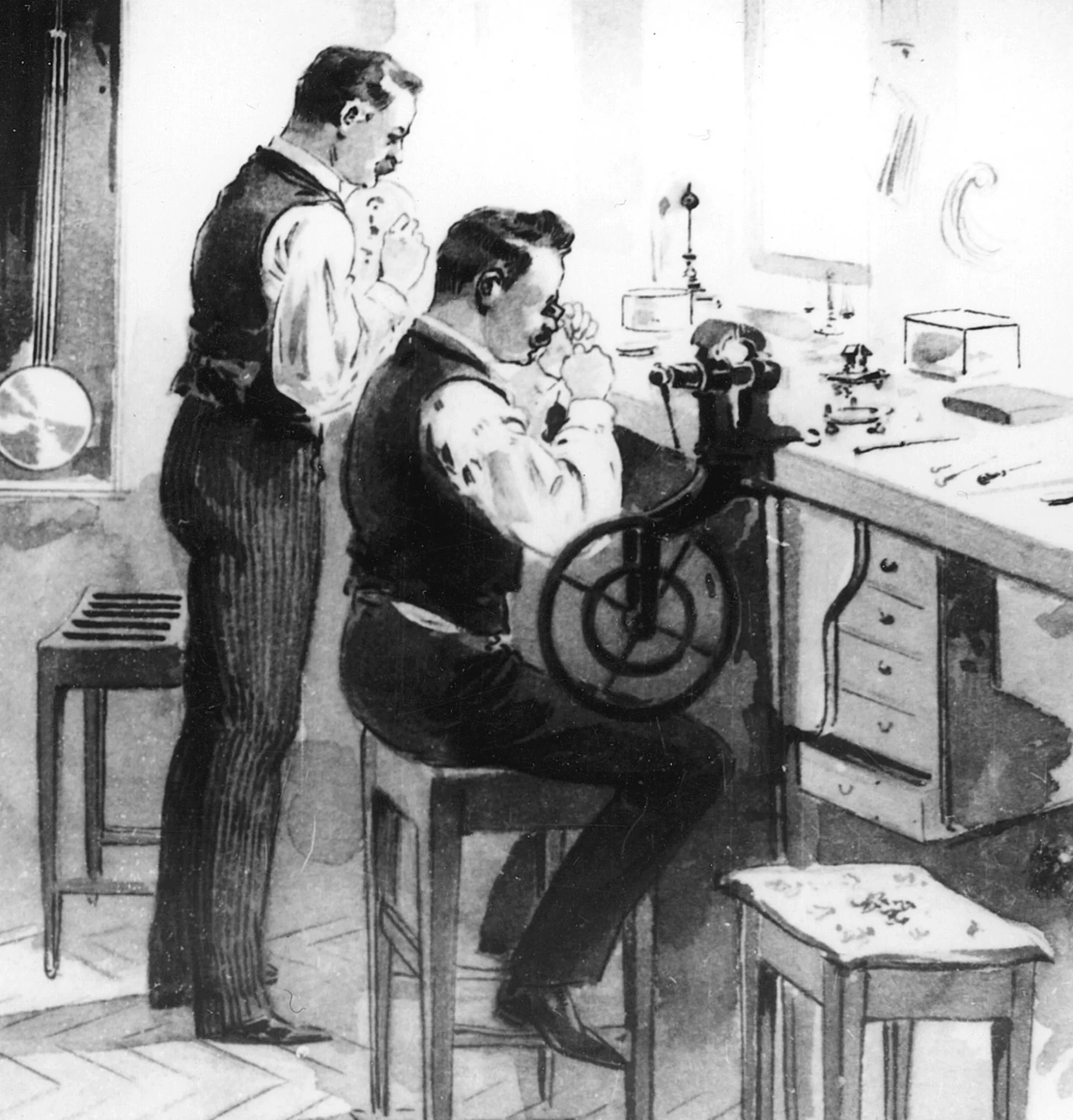
Credit © Archiv Deutsches Uhrenmuseum Glashütte
Watches from Glashütte: Serious competition for Swiss manufactures
Even then, watches from Glashütte had obviously become serious competition. The reaction of the Saxons is charming, and can be found relatively soon on watches of this provenance: in 1916, a watch manufacturer named Karl W. Höhnel used the term ‘original’ for the first time to distinguish the origin of his Glashütte watches from plagiarism. Until 1936, this company produced grandfather clocks with the words ‘Original Glashütte’ on the dial.
‘Original Glashütte’ becomes Glashütte Original
In 1920, the ‘Deutsche Präzisions-Uhrenfabrik Glashütte’ also produced pocket watches with the same label, followed a few years later by Uhrenfabrik AG Glashütte (a merger of various manufactures under the abbreviation UFAG), which produced wristwatches labelled ‘Original Glashütte’ for the first time. This term is retained until around the 1970s. With reunification, the former seal of quality becomes the official company name.
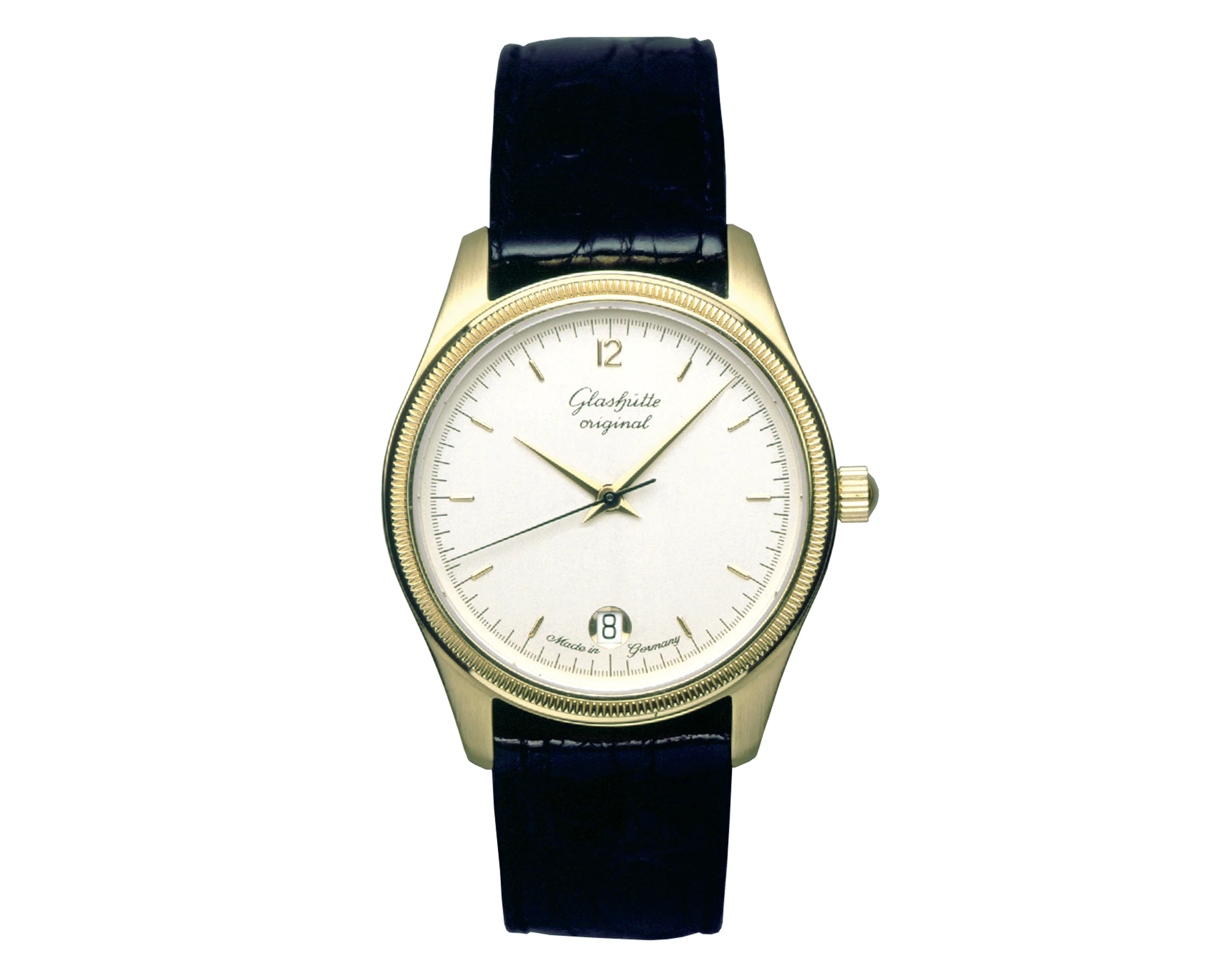
Credit © Archiv Deutsches Uhrenmuseum Glashütte
A watch museum donated by the Swatch Group
To learn more about the truly moving history of watchmaking in Glashütte, you should really make the effort to visit the watch museum a few minutes’ walk from the Glashütte Original manufacture, which was donated by none other than Glashütte Original under the leadership of the Swatch Group and the city. Incidentally, the same building still houses the company’s own watchmaking school, one of the most important in the country.
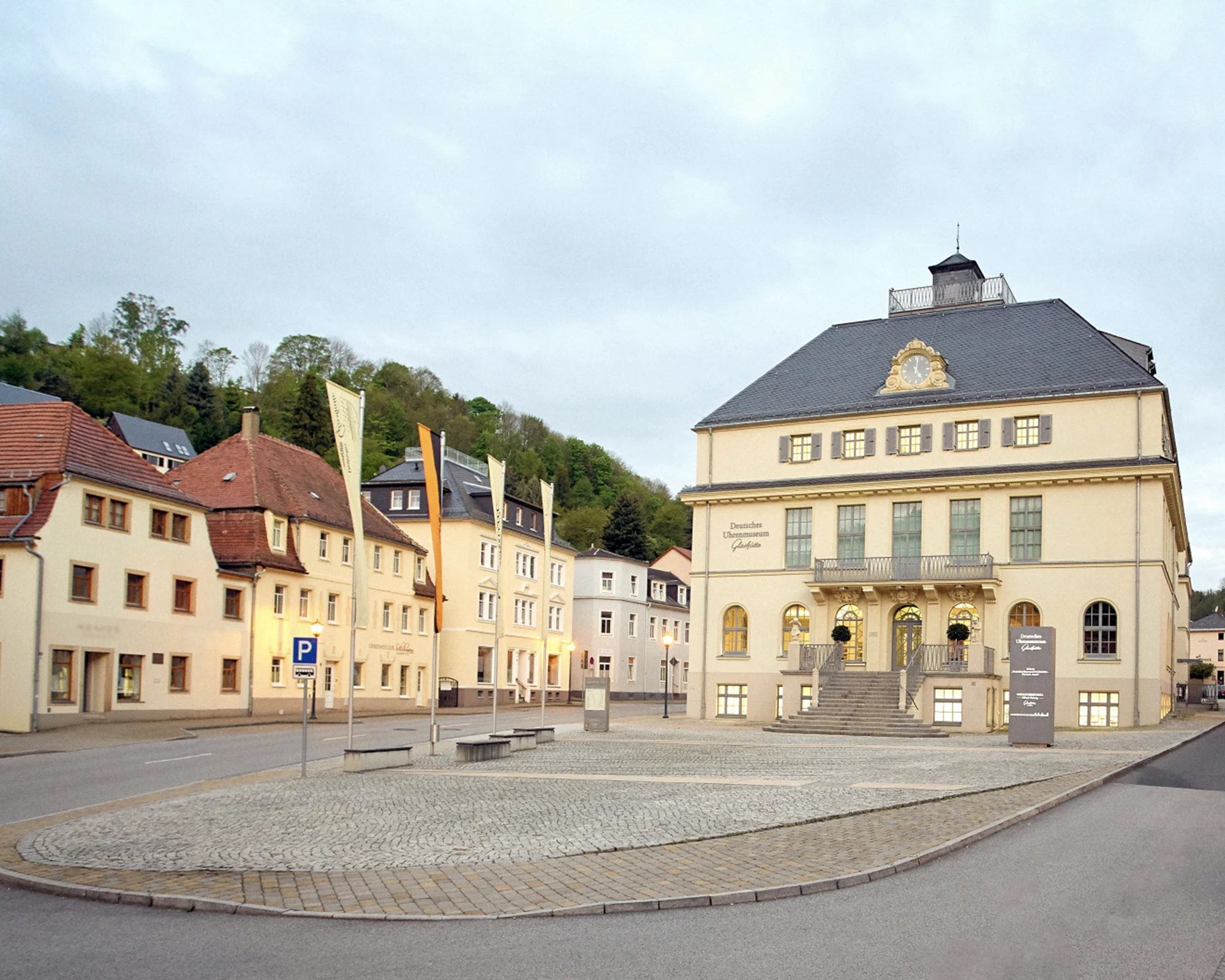
Credit © Archiv Deutsches Uhrenmuseum Glashütte
How did watchmaking come to the Ore Mountains?
Let’s turn the clock back 179 years: in May 1845, the Saxon state government granted the Dresden watchmaker Ferdinand Adolph Lange a loan to set up a watchmaking school. He had been commissioned by the court clockmaker Gutkaes to set it up. At that time, the Ore Mountains and the Müglitz Valley in particular were in dire straits, the silver ore deposits had dried up, companies were trying to set up shop and people were starving. It would take years before a core of skilled labourers would be available to master this challenging undertaking, but gradually more and more master watchmakers and merchants settled in the small town of Glashütte.
With the founding of the German Watchmaking School in 1878, Glashütte achieves an important milestone in becoming the most important centre of the German watchmaking industry. Within a few decades, precision pocket watches earn Glashütte a worldwide reputation. It is not until the First World War and the slowly ensuing triumph of the mechanical wristwatch that Glashütte comes under pressure, as it had missed out on industrial series production. The race to catch up and the subsequent armaments production come to an abrupt end with the bombing – on the last day of the Second World War, 8 May 1945, of all days.
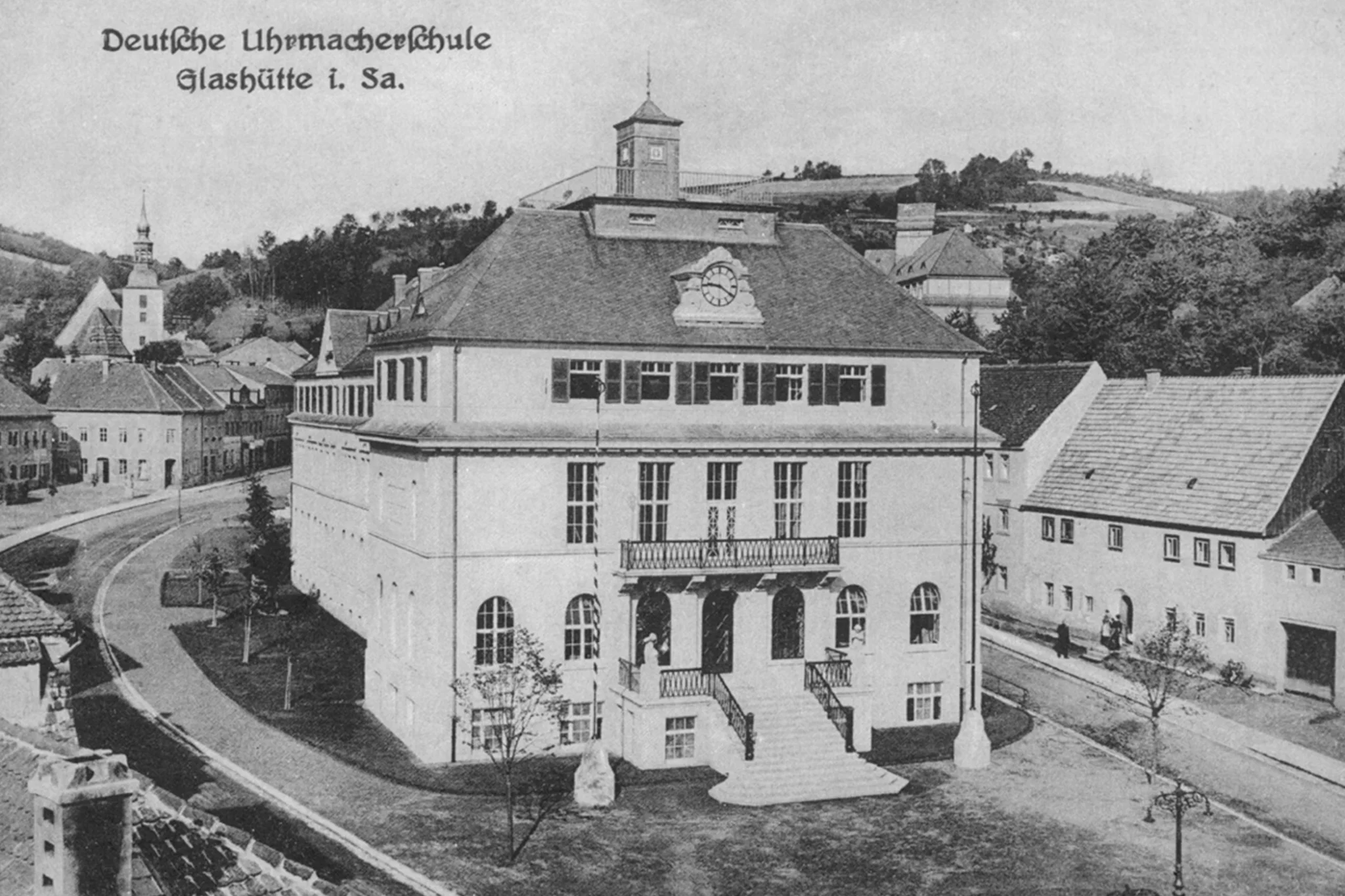
Credit © Archiv Deutsches Uhrenmuseum Glashütte
After 100 years, it could have been over
After 100 years of success, it could all have been over again. This time, the continuation of the Glashütte watchmaking tradition is severely jeopardised by destruction, but also by the dismantling of numerous production facilities by the Russian occupying forces. But as Nick Hayek wrote in his foreword to the book mentioned at the beginning? His father had already correctly assessed the toughness of the Glashütte people: people in Glashütte don’t give up so easily. By the end of 1946, the first movements were being produced again. The changed economic order in the socialist part of Germany led to the nationalisation of all local watchmaking companies and to their merger in 1951, creating the state-owned company mentioned above, VEB Glashütter Uhrenbetriebe.
The watchmakers in East Germany are very inventive
In times of need, the watchmakers in Glashütte literally become inventive: the isolation from the European and Western watch market spurs them on time and again to develop new and independent solutions in precision mechanics. The isolation caused by the Iron Curtain had one decisive advantage: while the quartz crisis in the 1970s destroyed almost the entire traditional mechanical watch industry in the western part of Germany and in Switzerland, people in the East held on to it. On the one hand, watches were important sources of foreign currency (watches from Glashütte were sold by West German mail order companies under names such as ‘Meisteranker’). All these ups and downs are reflected in the corridors you walk through at Glashütte Original.
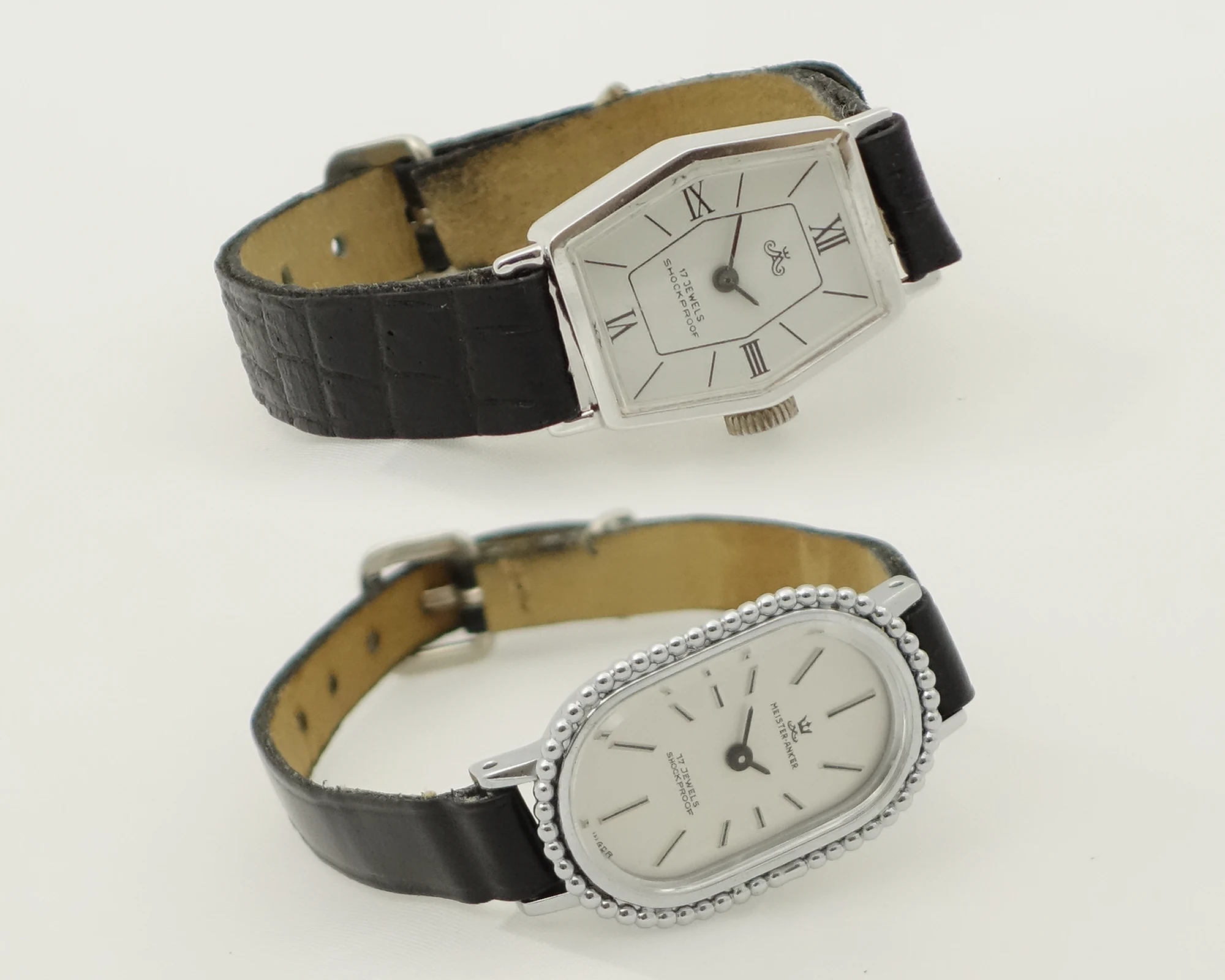
Credit © Archiv Deutsches Uhrenmuseum Glashütte
How did Glashütte become the mecca German watchmaking once more?
After reunification, a company set up to privatise state-owned companies in the GDR, the so-called Treuhandanstalt, takes over the management. In 1994, the company is sold with a workforce of only around 70 people. By comparison: during the GDR era, around 2,500 people had worked here. That’s why nobody on site is surprised by the large entrance hall – it was simply a huge operation. The new, temporary owners don’t get everything right, but they do get one thing right: they position the company in the area of the global comeback of luxury watchmaking that is currently taking place. Since then, apart from the Pavonina ladies’ watch line with quartz movements, the company has only produced mechanical watches under the name Glashütte Original.
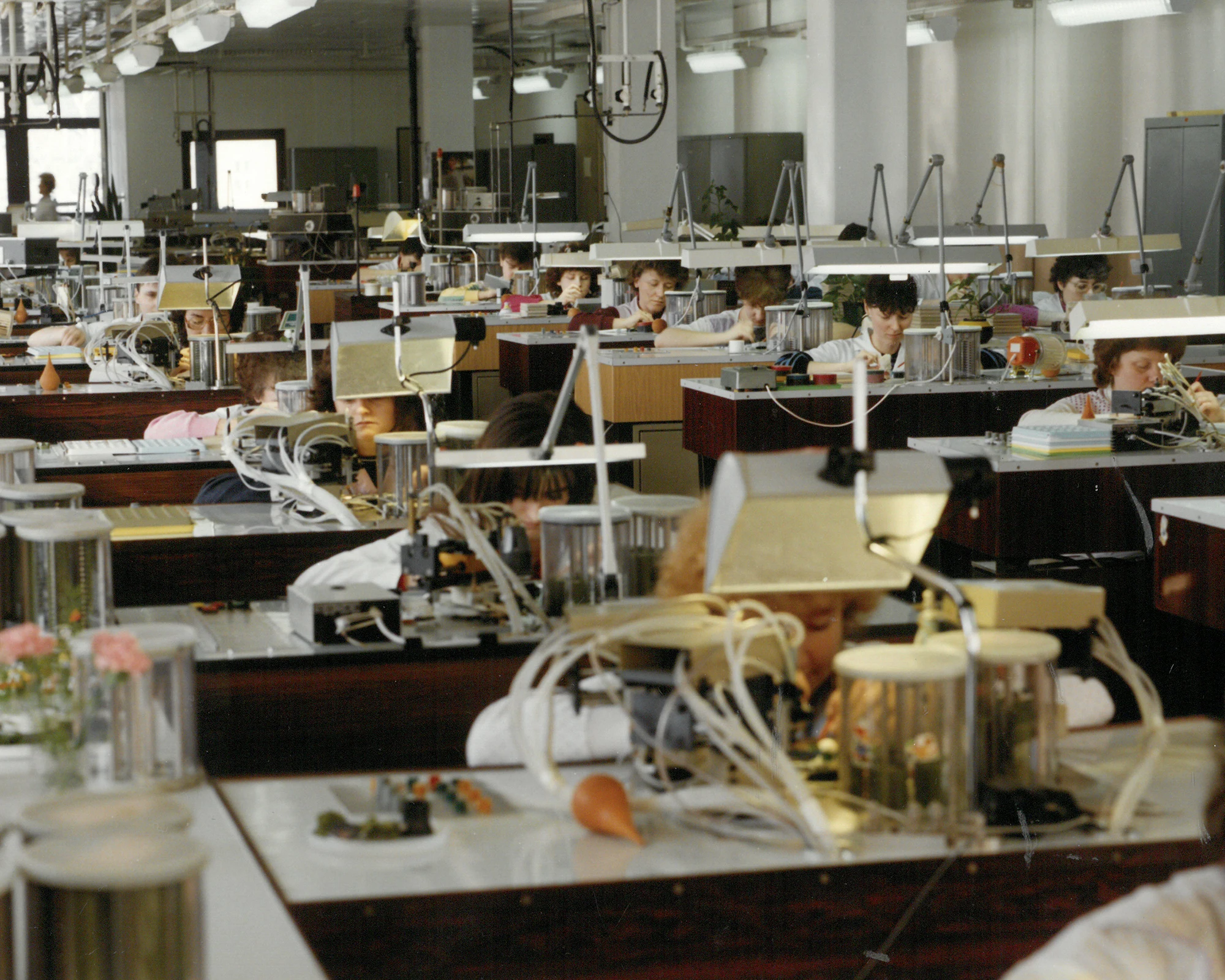
Credit © Archiv Deutsches Uhrenmuseum Glashütte
Suddenly back on a par with Swiss manufactures
The existing, extremely high level of vertical integration, watchmaking expertise and concentration on constructive competence in the construction of movements quickly secured the company an international reputation. This process of specialisation and development of in-house mechanical movements is also taking place in Switzerland, where standard calibres are gradually being replaced by manufactures. Despite an eventful history that is probably unparalleled in the watch industry, Glashütte Original suddenly found itself on a par with the biggest names in haute horlogerie.
Major investments are necessary: the parent company takes over
When the Swatch Group under Hayek Senior took over the company in 2000, considerable investment was nevertheless required. The manufacture building was gigantic and had to be renovated. From July 2002 to August 2003, under the project management of Hayek Engineering, the never really completed series production facility of the GDR was transformed into a very spacious, light-flooded manufacture. Almost unthinkable today, the conversion was carried out while production continued.
Opening of boutiques around the world
Under the leadership of the Swatch Group, boutiques are opened around the world for the first time and internationalisation is taken seriously. The process lasted a good decade, perhaps most significantly in 2012, when a flagship store was opened in the immediate vicinity of the rebuilt Frauenkirche in Dresden.

The comeback of the watchmaking school in Glashütte
Parallel to the need to raise awareness of Glashütte Original products, the Swatch Group recognised the greatest challenge facing the watch industry today long before others do. As early as 2001, watchmaking students and toolmakers were being trained at the newly re-established ‘Alfred Helwig’ watchmaking school. In 2013, the number of apprentices per year was doubled from 12 to 24, of which around four apprentices per year learn the profession of toolmaker. Because in the end, it is people who deliver outstanding products. For the sake of completeness, I will mention two historical names that are associated with Glashütte Original and are still reflected in the modern products.
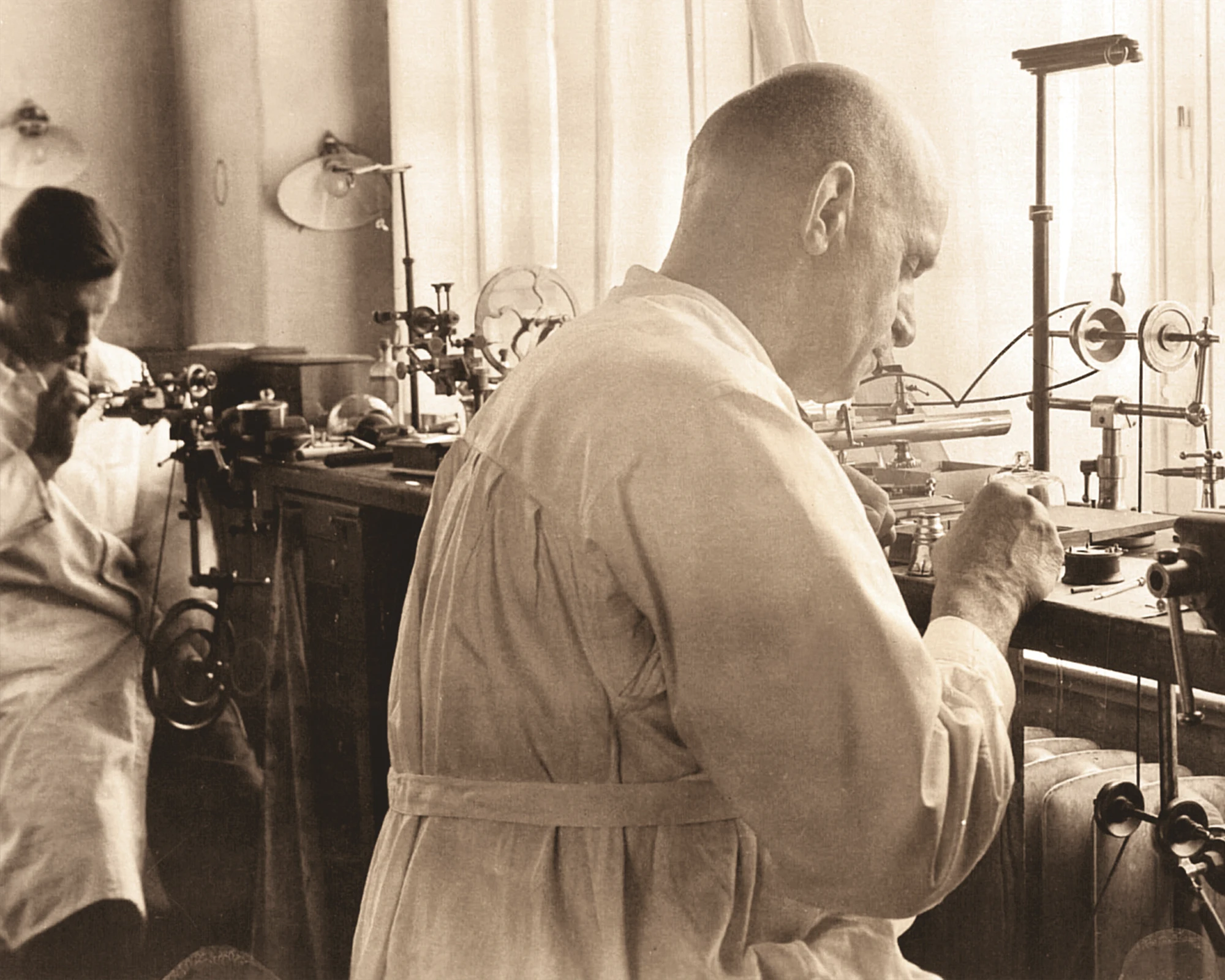
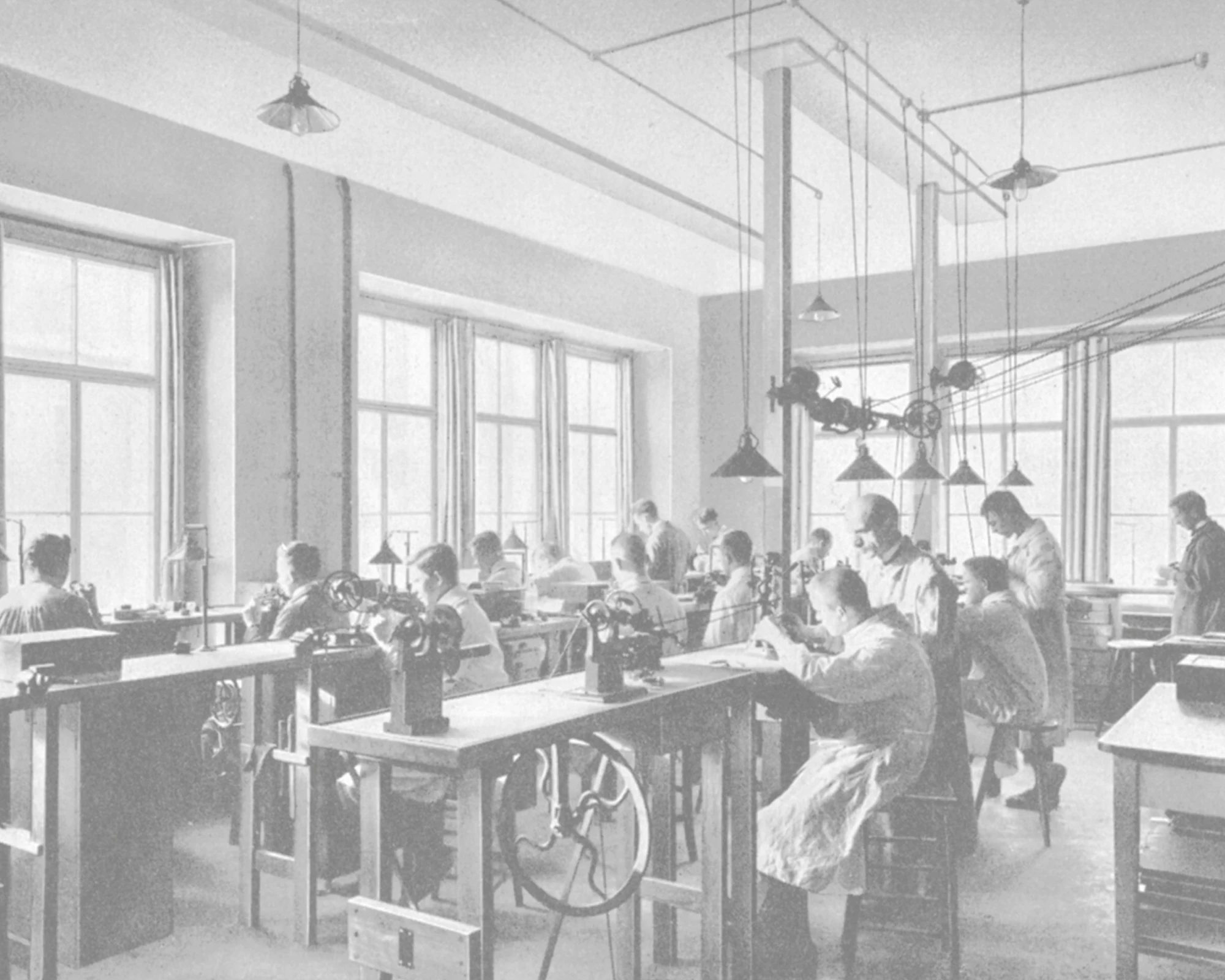
Credit © Archiv Deutsches Uhrenmuseum Glashütte
Which historically significant figures in German watchmaking are associated with Glashütte Original?
Watchmaking in Glashütte had several founding fathers. Thanks to their passion, skill and business acumen, master watchmakers such as Julius Assmann, Moritz Grossmann, Ferdinand Adolph Lange and Adolf Schneider realised the dream of an independent watchmaking industry in Saxony and established the fame of the Glashütte name.
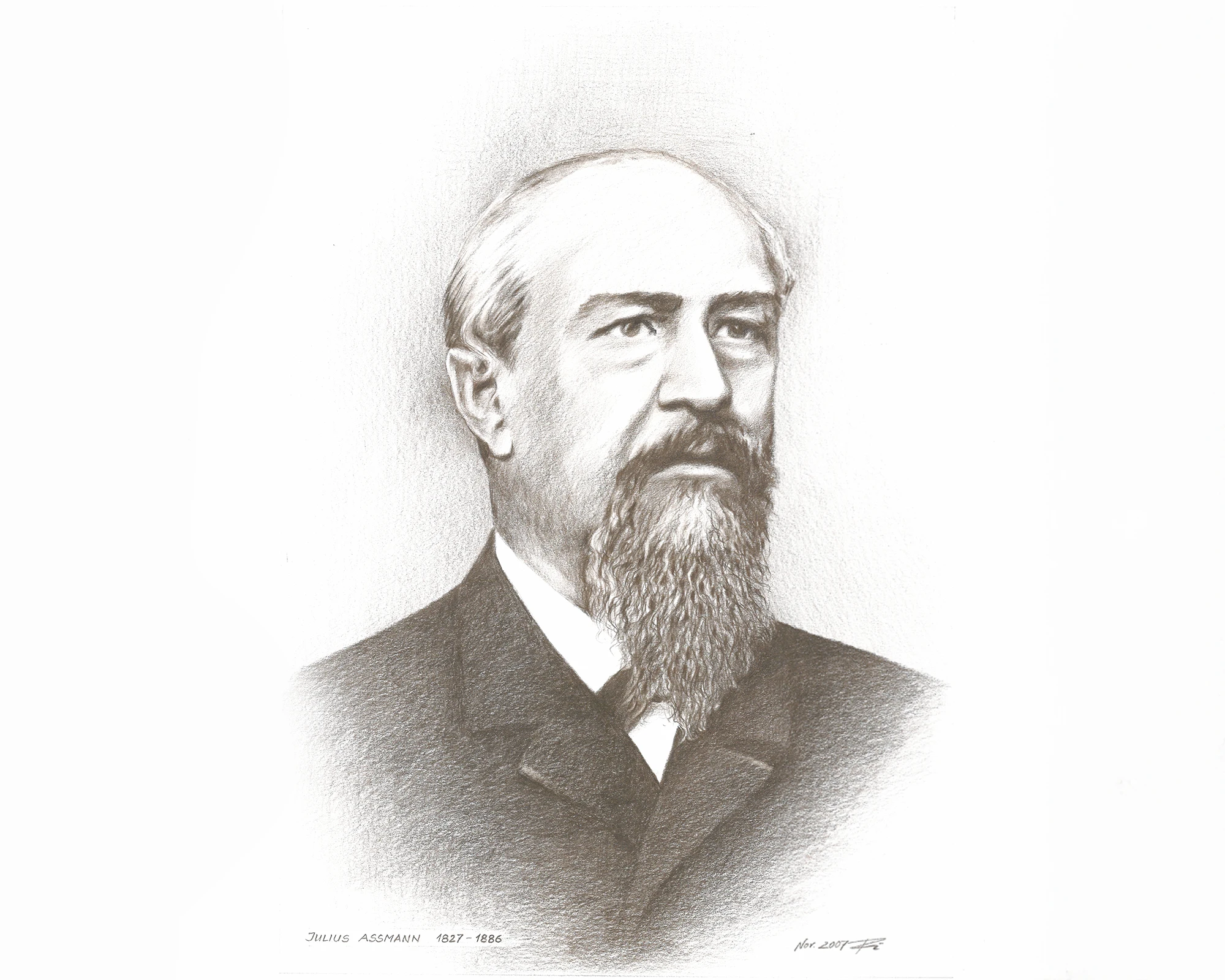
Credit © Archiv Deutsches Uhrenmuseum Glashütte
Two special names are associated with Glashütte Original today
One of these pioneers of precision engineering, Ludwig Strasser, holds a special position. Today, Strasser is often only known for his famous pendulum clocks, but Strasser was a mathematician, theorist, designer, watchmaker and teacher. For 37 years of his life, the professor put his skills at the service of the German watchmaking school, which he was to head for 32 years. In the early years of Glashütte watchmaking, his name was highly regarded internationally. In 1875, together with Gustav Rohde, he founded the company Strasser & Rohde, which became particularly famous for the manufacture of precision pendulum clocks. He was awarded the title of professor in 1902 for his outstanding achievements.
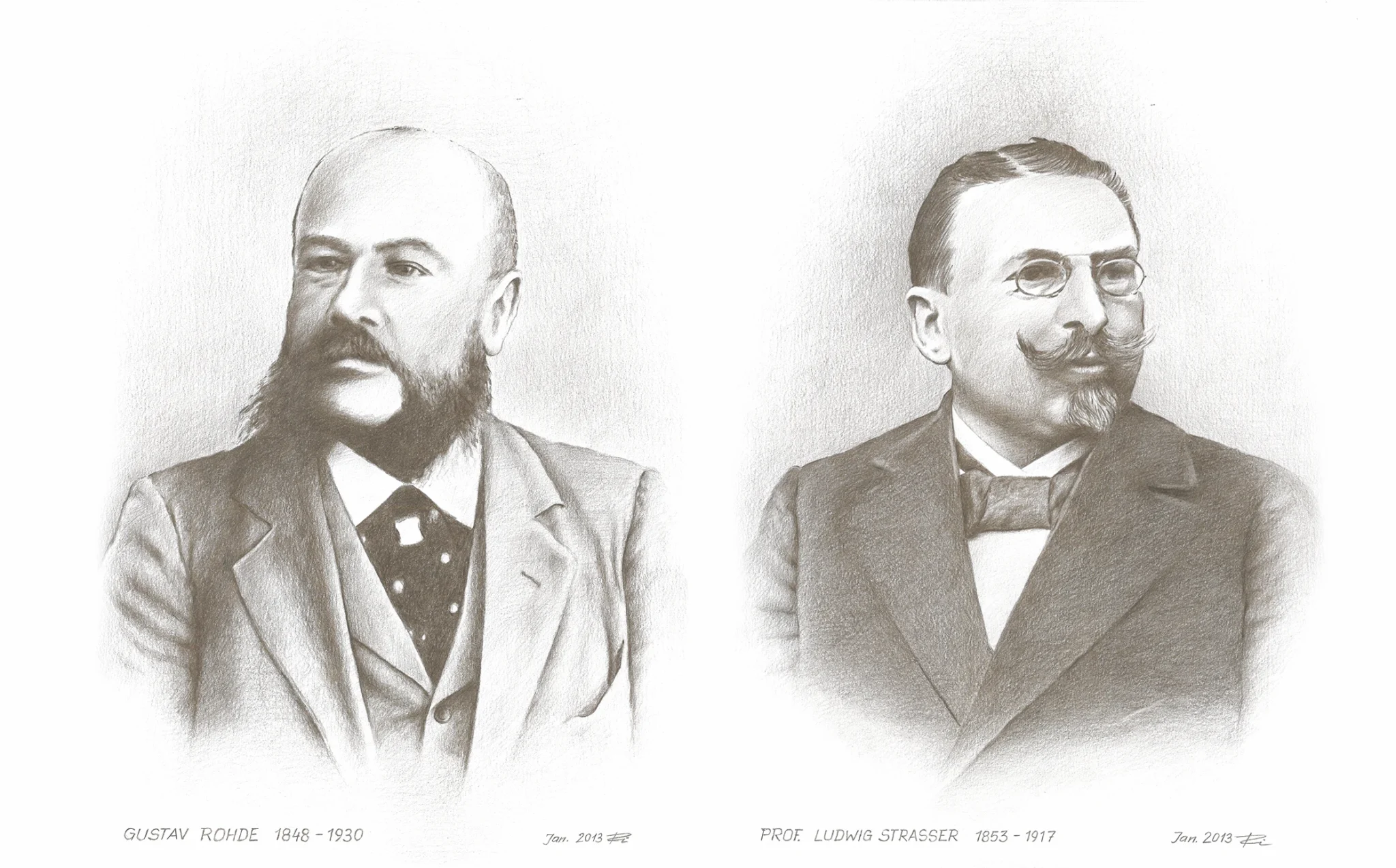
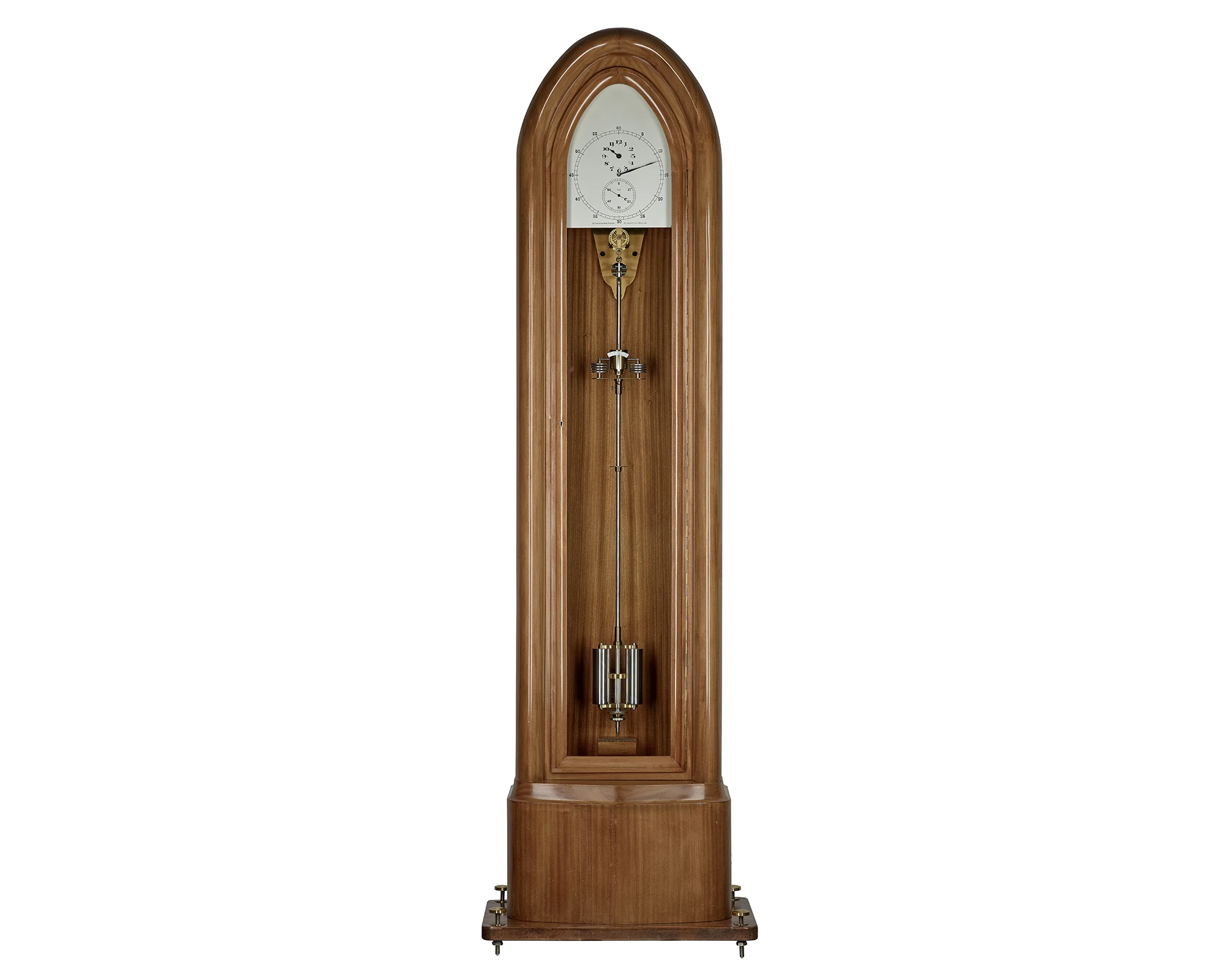
Credit © Archiv Deutsches Uhrenmuseum Glashütte / René Gaens
A revolutionary invention
Strasser’s most important and revolutionary invention is probably the ‘free spring detent escapement with constant force’. It is also to his credit that he championed the manufacture of marine chronometers as another important mainstay for the young Glashütte watch industry and helped to develop it: the Empire and colonialism were all about international competition. The Germans were determined to reduce their dependence on the (still) superior products from England. The company received numerous awards for its precision clocks and measuring instruments at world exhibitions and national trade fairs. Glashütte Original, which holds all the rights to the Strasser & Rohde name, honoured the lifetime achievements of the two pioneers of precision engineering in 2009 with the special Strasser & Rohde Regulator model.
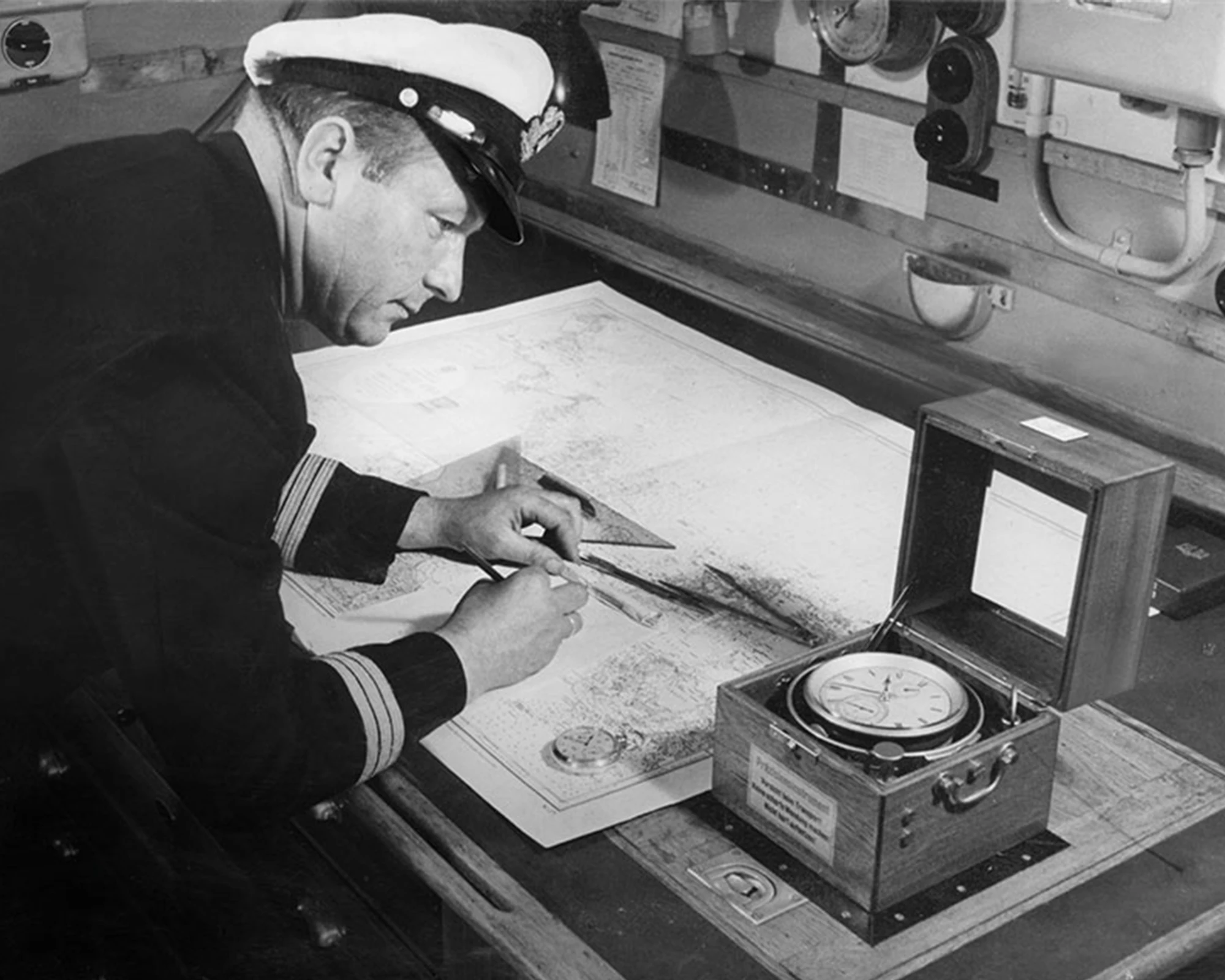
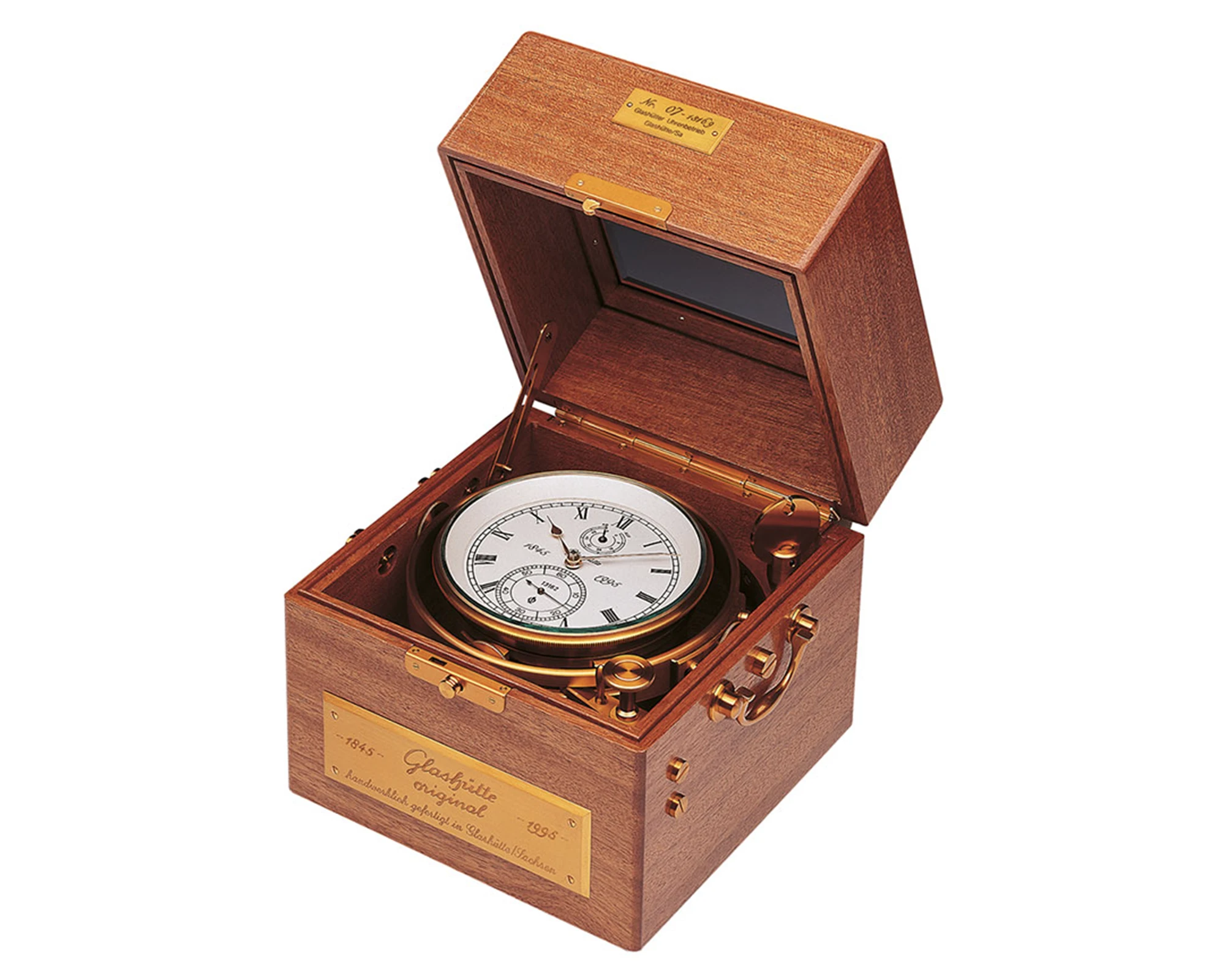
Credit © Archiv Deutsches Uhrenmuseum Glashütte
One of the greatest German watchmakers: Alfred Helwig
A second important protagonist of the early years, to whom Glashütte Original holds all rights, is Alfred Helwig. He is rightly regarded as one of the greatest German watchmakers and certainly one of the best teachers at the Glashütte watchmaking school, which has been named after him since its re-founding in 2002.
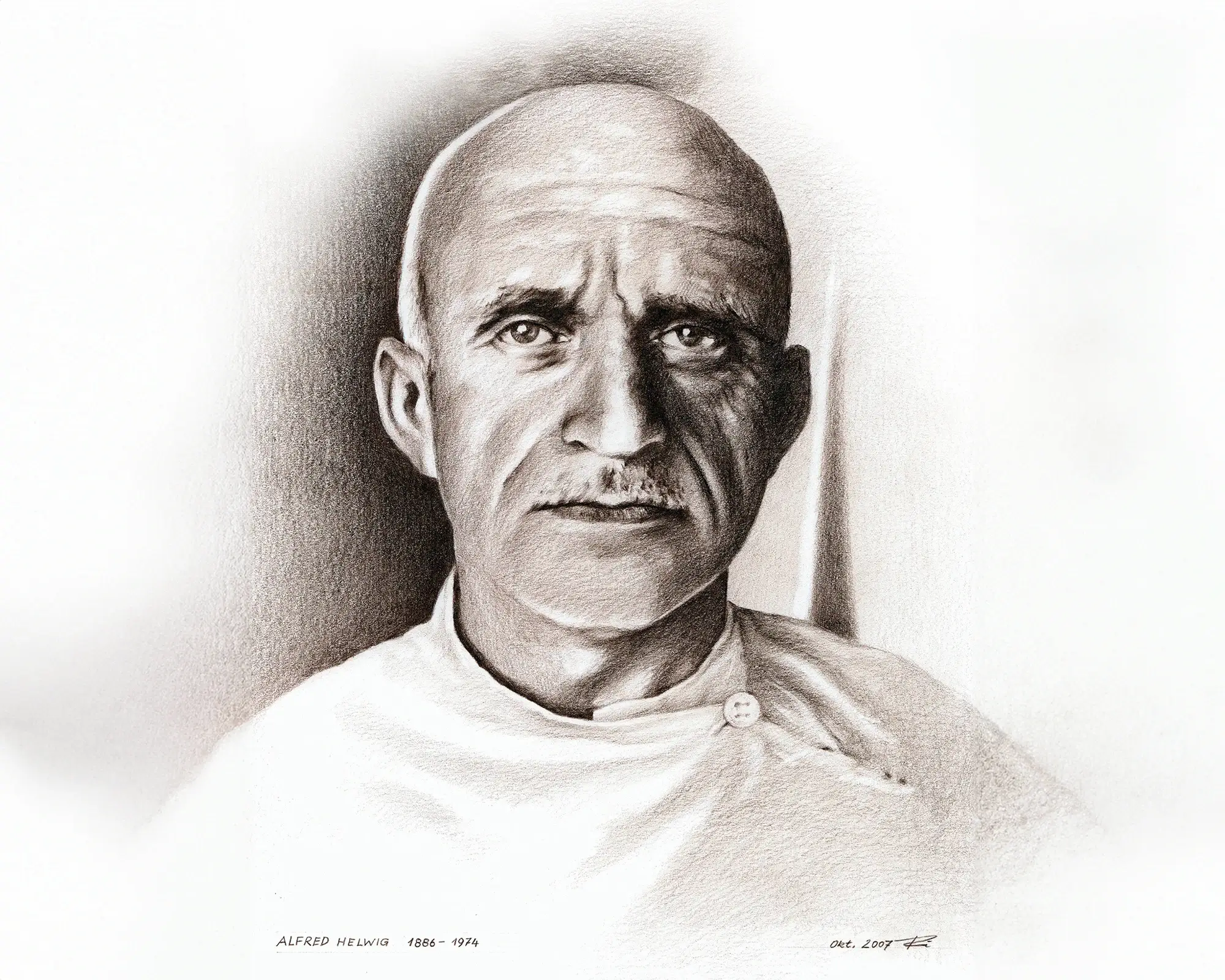
Credit © Archiv Deutsches Uhrenmuseum Glashütte
To this day, Helwig’s name stands for his talent for not only designing watches to the highest level of artistic perfection, but also developing them technically. After years of travelling, he registered his own workshop in Glashütte in 1911. At the same time, he began teaching at the watchmaking school, which he was to do for a total of 41 years. In order to increase the accuracy of portable watches, he studied Abraham Louis Breguet’s most famous invention today, the tourbillon. Herwig planned nothing less than to improve this mechanism to compensate for the effects of gravity on the rate of mechanical movements.
The world’s first flying tourbillon
He developed the world’s first ‘flying’ tourbillon, supported on one side only by two bearings with a small distance between them, which guide the wheel arbour. For the first time, the pivotal bogie and escapement did not require an upper cock. The unobstructed view of the tourbillon is called ‘flying’ because it appears to float. As this construction requires less material and is therefore lighter, it is less sluggish and thus achieved the best rate results for portable precision watches in Helwig’s time. Helwig’s masterpiece at his master’s examination in 1922 was thus a flying tourbillon and perhaps the decisive icing on the cake for precision watchmaking from Saxony, which was now, for the first time, on a par with the founding father of modern mechanics, Abraham Louis Breguet.
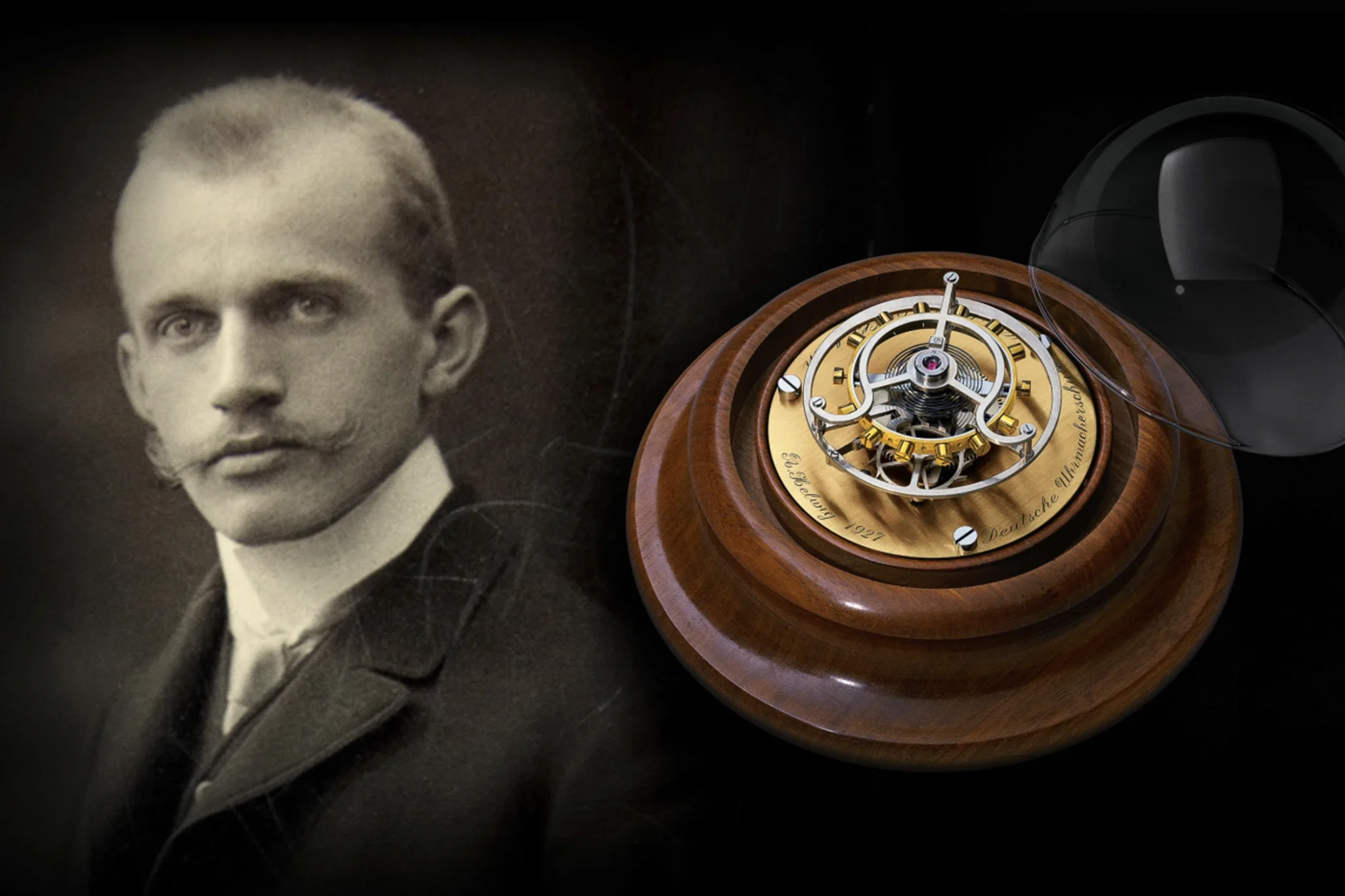
Credit © Archiv Deutsches Uhrenmuseum Glashütte
Tourbillons, an integral part of Glashütte Original watches
Today, flying tourbillons are often used in the best mechanical wristwatches, mainly due to their superior aesthetics. Since its comeback in 1995, Glashütte Original has repeatedly honoured the master watchmaker with limited editions of tourbillon watches, all of them flying, of course. But naturally, this mechanism is part of the brand’s standard repertoire in almost every collection. Let’s take a closer look at the watches and movements from Glashütte Original.
The five important collections from Glashütte Original
In the large glass-roofed atrium, I get to know the enormous diversity of Glashütte Original. I am very impressed. The current range comprises around 100 references. The product range of the German manufacture is much broader than that of many other local manufacturers in Saxony, but also other brands from Germany, and is more comparable to the rich variety of products offered by large houses from Switzerland, which is of course due to its impressively long history. Glashütte Original is not simply a watch company from Glashütte, but at the time of its rebirth, it brought together all the local manufactures under one roof. This is what makes this company so exciting for collectors, even if there is no watch under the brand name with Glashütte Original on the dial before 1994. But with a history of 30 years since it was founded, the company is now establishing genuine classics for future generations. And the company is constantly working to ensure that these classics remain recognisable and do not constantly change.
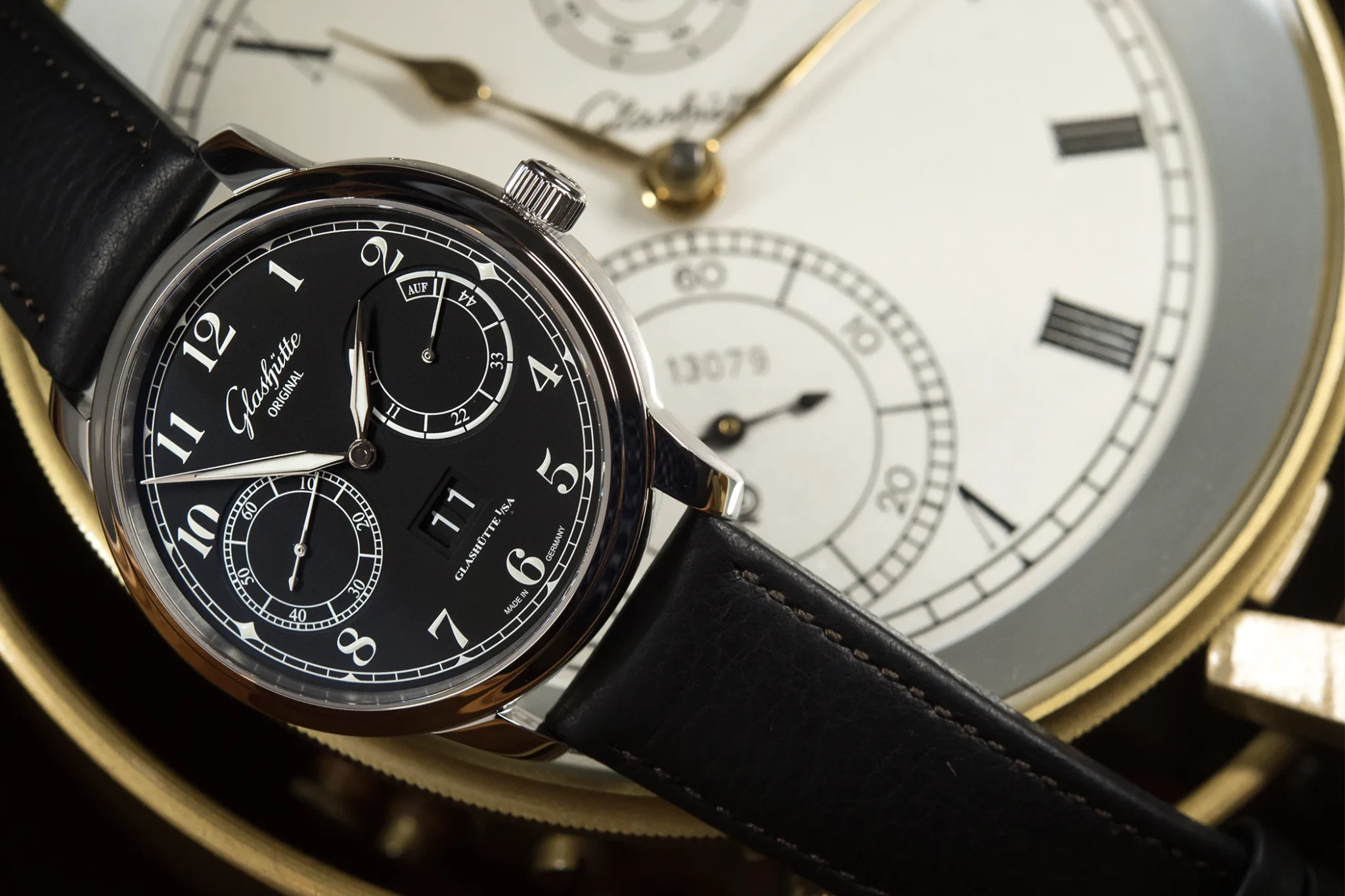
From classically elegant to sporty and robust – mechanical watches for every taste
Watch fans can choose from five collections. We will start with the Senator, the classic Glashütte Original. Secondly, we should mention the unmistakable “Pano” series, whose name is derived from the distinctive, patented Panorama Date.
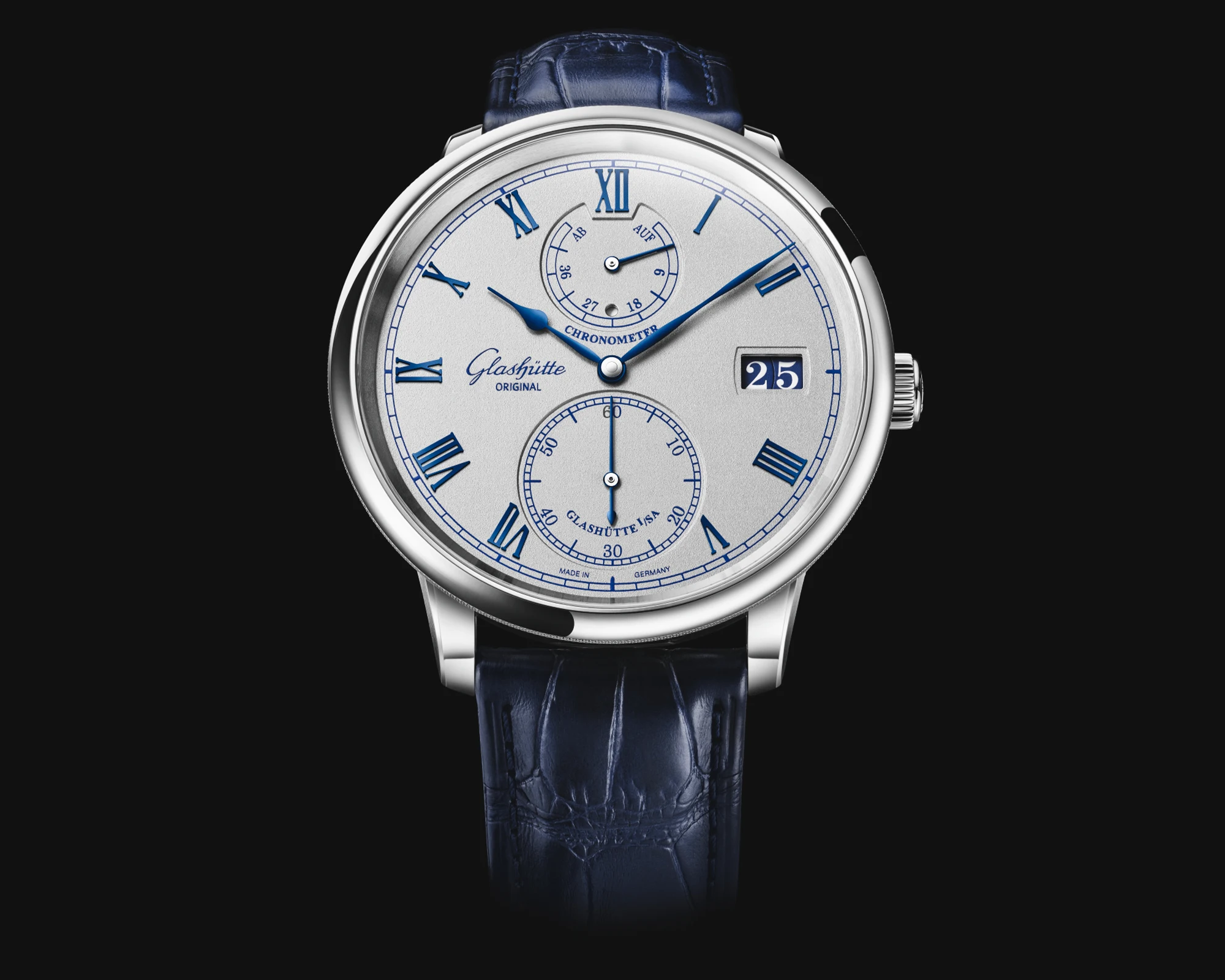
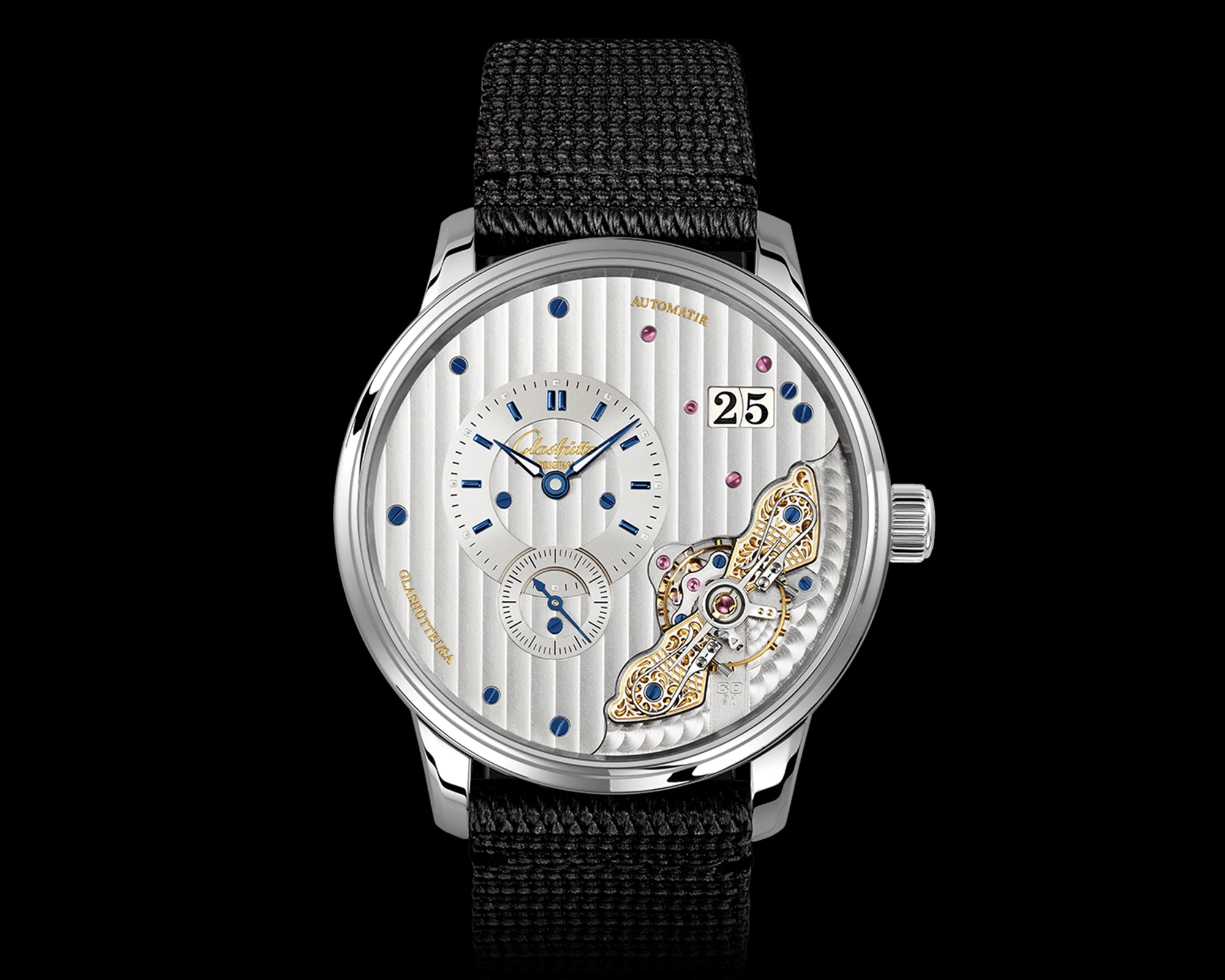
Then we come to the Vintage series. With the so-called Sixties and Seventies, Glashütte Original has two very unusual model lines in the otherwise very classic manufacture. These models celebrate style-defining decades of the past century in their very own way, away from the Swiss mainstream.
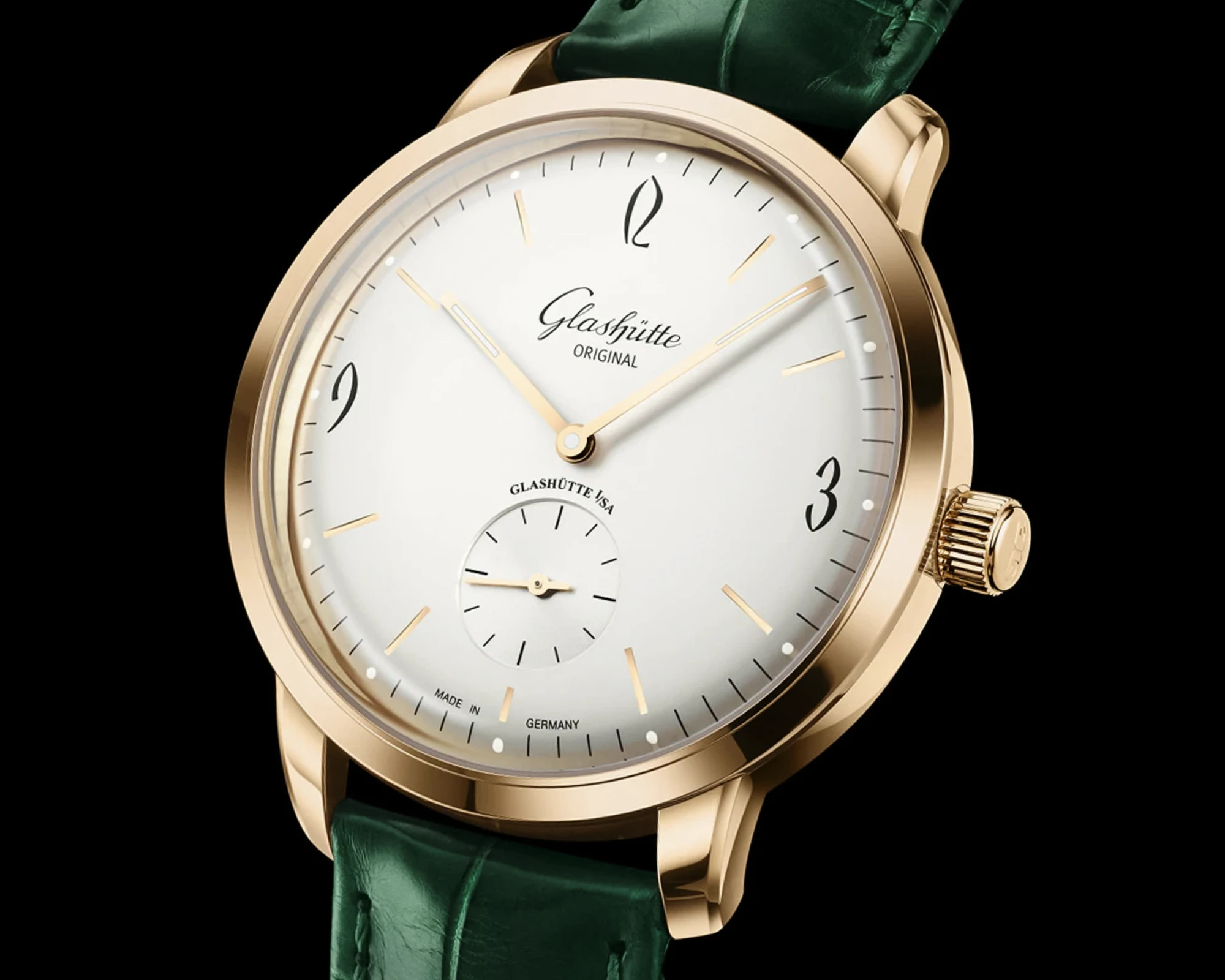
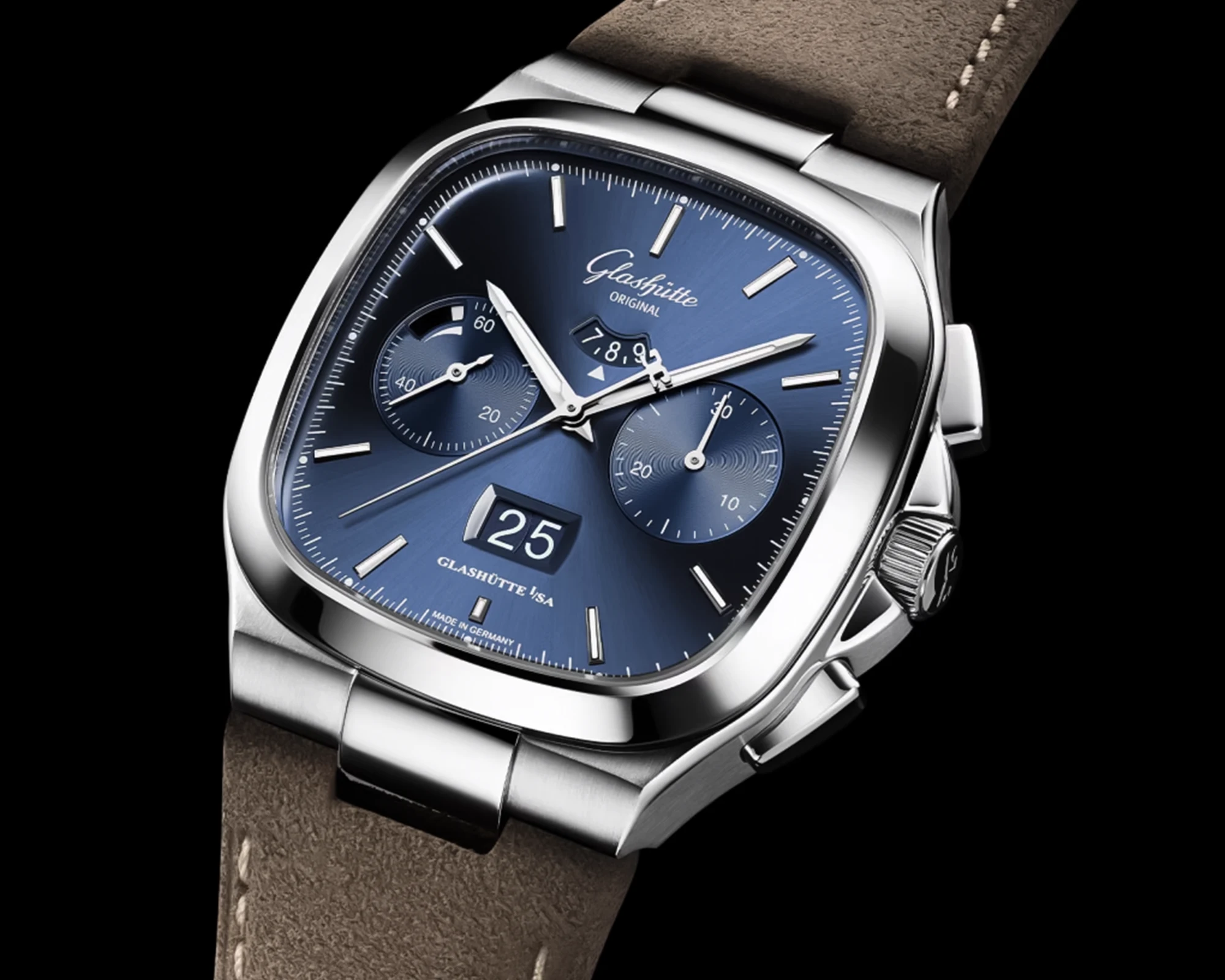
The most recent line at Glashütte Original is called Spezialist, and is aimed at a new, active target group with instrument and sports watches. With the SeaQ, Glashütte Original is currently tapping into completely new customer segments, building on the long tradition of particularly robust models.
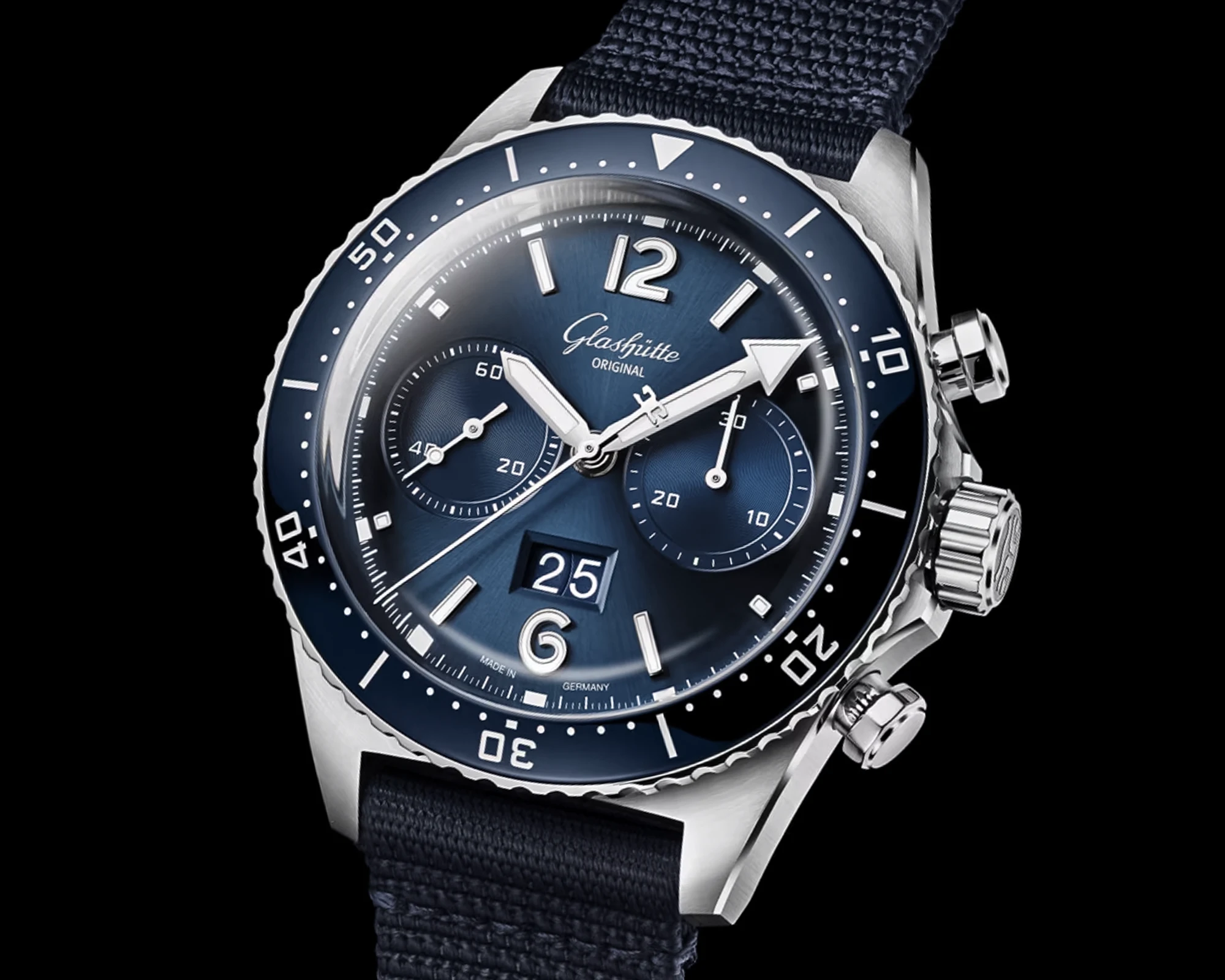
Last but not least: the very successful ladies’ collection with the Lady Serenade, the PanoMatic Luna and, most recently, the Serenade Luna, for which Glashütte Original, unlike much larger manufactures, has relied exclusively on fine mechanics since its resurrection, just as it does for its men’s watches.
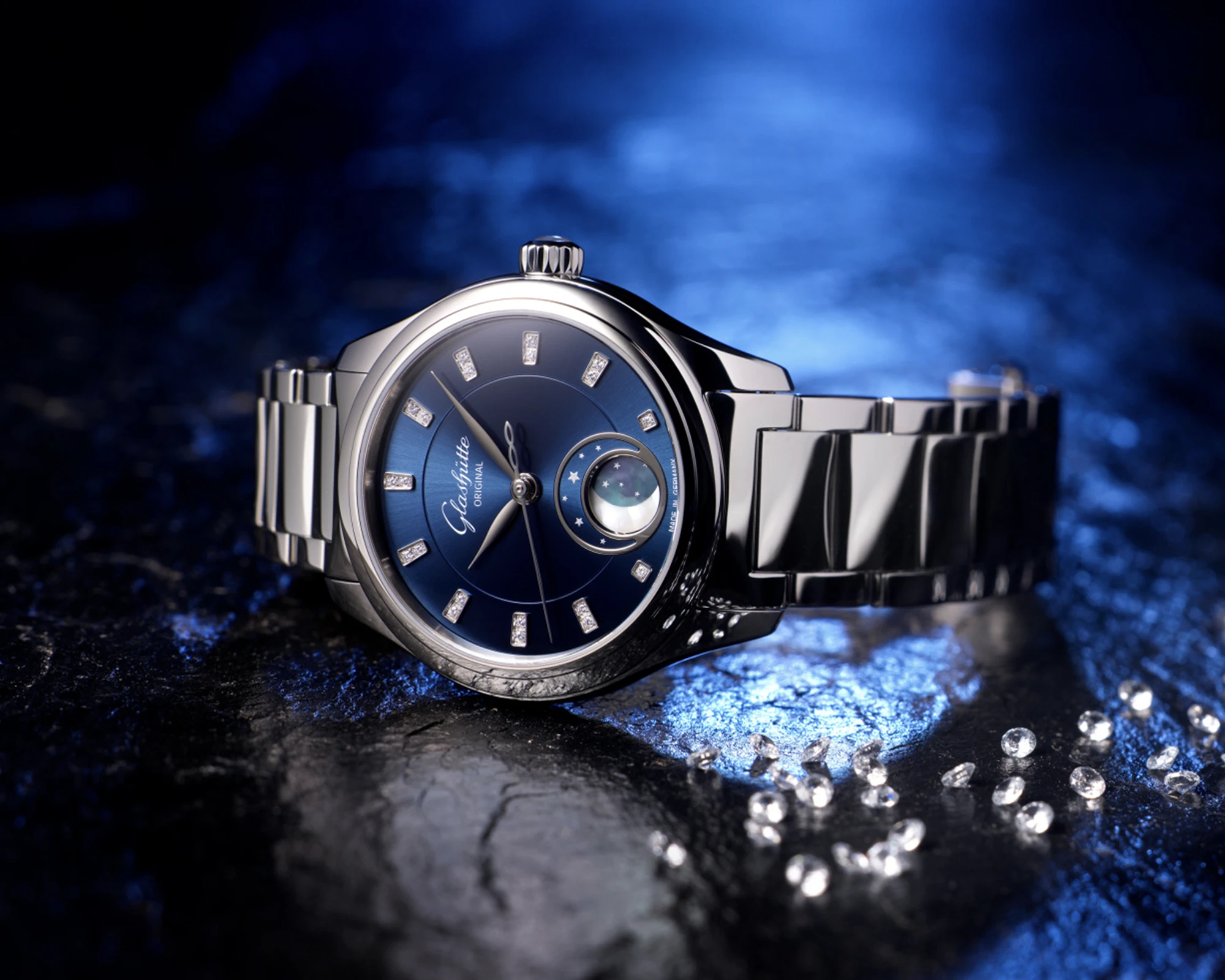
What makes Glashütte Original movements so special?
To be able to experience the art of watchmaking at Glashütte Original at all, the most important feature and indeed on almost all Glashütte Original models is a transparent sapphire crystal caseback: this allows you to admire the traditional Glashütte three-quarter plate with its characteristic gold châtons, the striking swan-neck fine adjustment or other intricately decorated movement parts such as the hand-engraved balance bridges and cocks. Why almost? The only exception is the SeaQ sports model, which, apart from the gold version, has a screw-down steel back just like its historical predecessor.
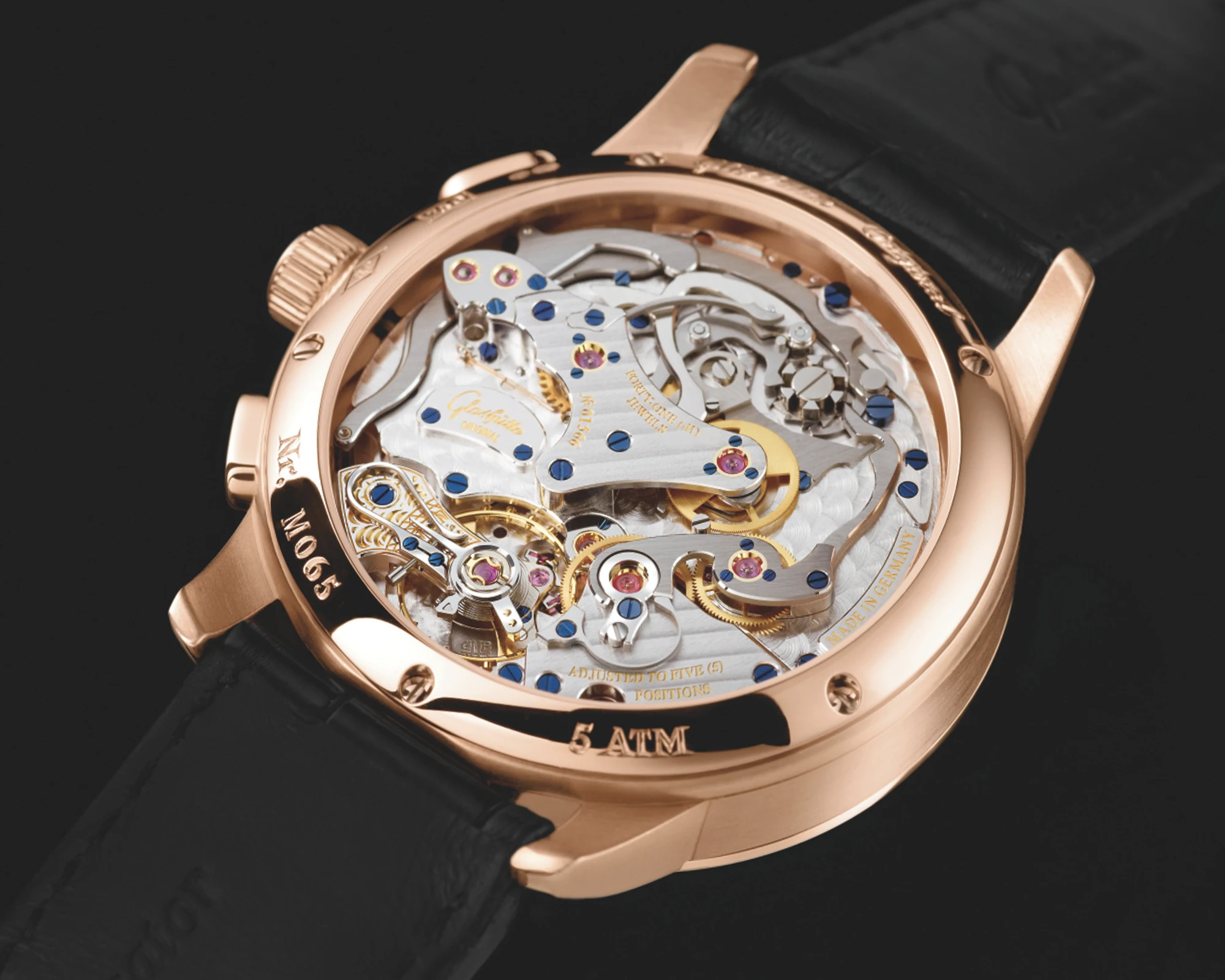
The Glashütte three-quarter plate
The tradition of the three-quarter plate goes back to the beginnings of watchmaking in Glashütte in 1845. One of the advantages over the Swiss design with several individual bridges is the significantly greater stability. The Glashütte stripe finish is a very fine decoration for the non-functional surfaces. All non-visible surfaces of Glashütte Original watches are also refined and finished by hand with perlage.

Screw-down gold châtons
Screw-down gold châtons are a mere visual delight today, but were introduced in the 18th century to correct the play in the bearings and to make it easier for the watchmaker to replace the sensitive jewels in the event of breakage. Today, the main aim is to preserve the craftsmanship, skill, and unique appearance of the watch without diminishing its original function.
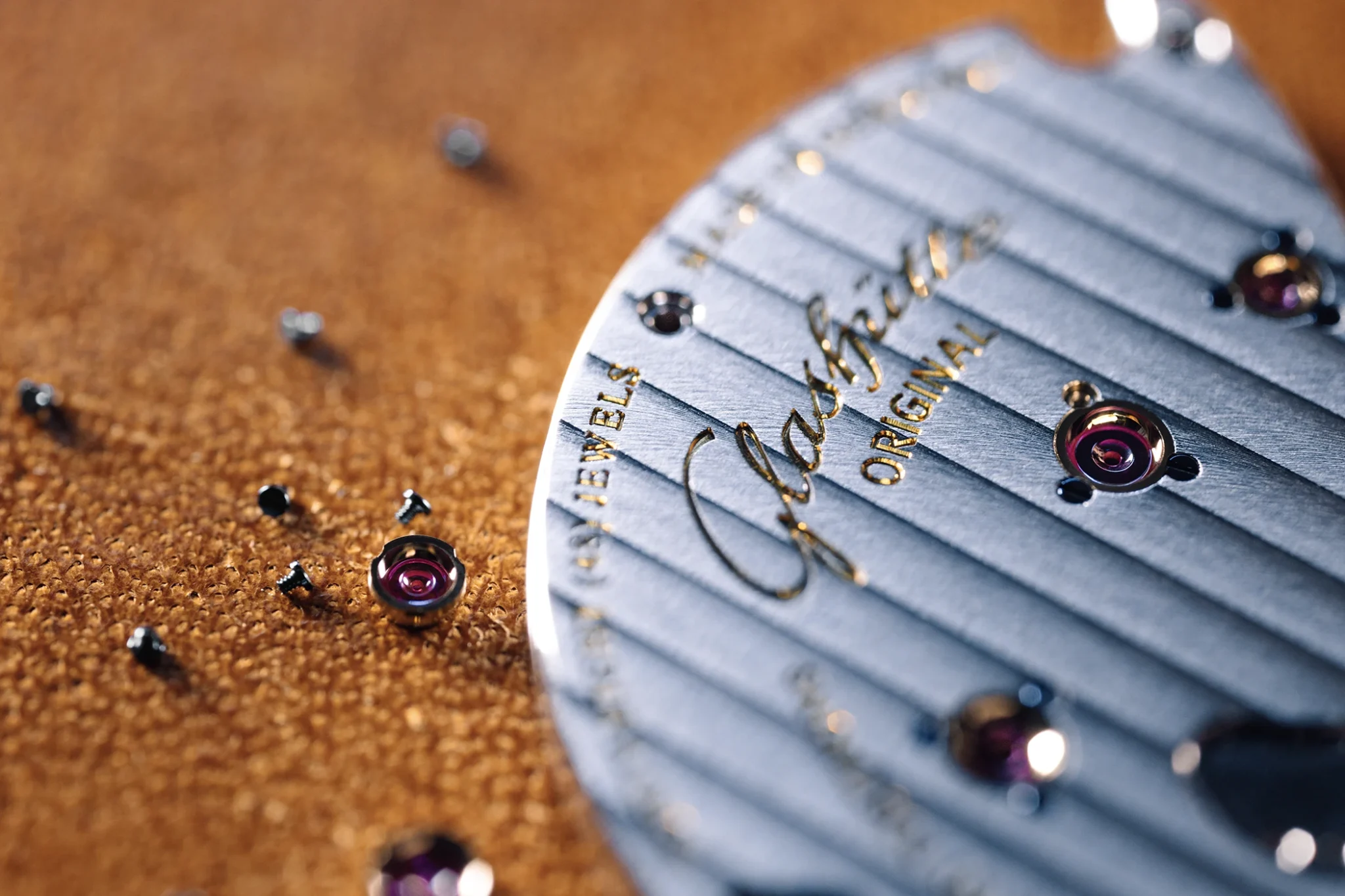
Only from Glashütte Original: The duplex swan-neck fine adjustment
While collectors are often familiar with the term swan-neck fine adjustment, which involves adjusting the so-called regulator arm, the duplex swan-neck fine adjustment is a genuine Glashütte Original specialty: it is used to adjust the anchor drop and thus ensure that the watch ticks particularly evenly. Glashütte Original also relies on a traditional construction method for the heart of the watch, the balance: 22 tiny gold screws fit into the balance rim of the traditional screw balance, which is used in all watches, even if the balance spring is now increasingly made of silicon.
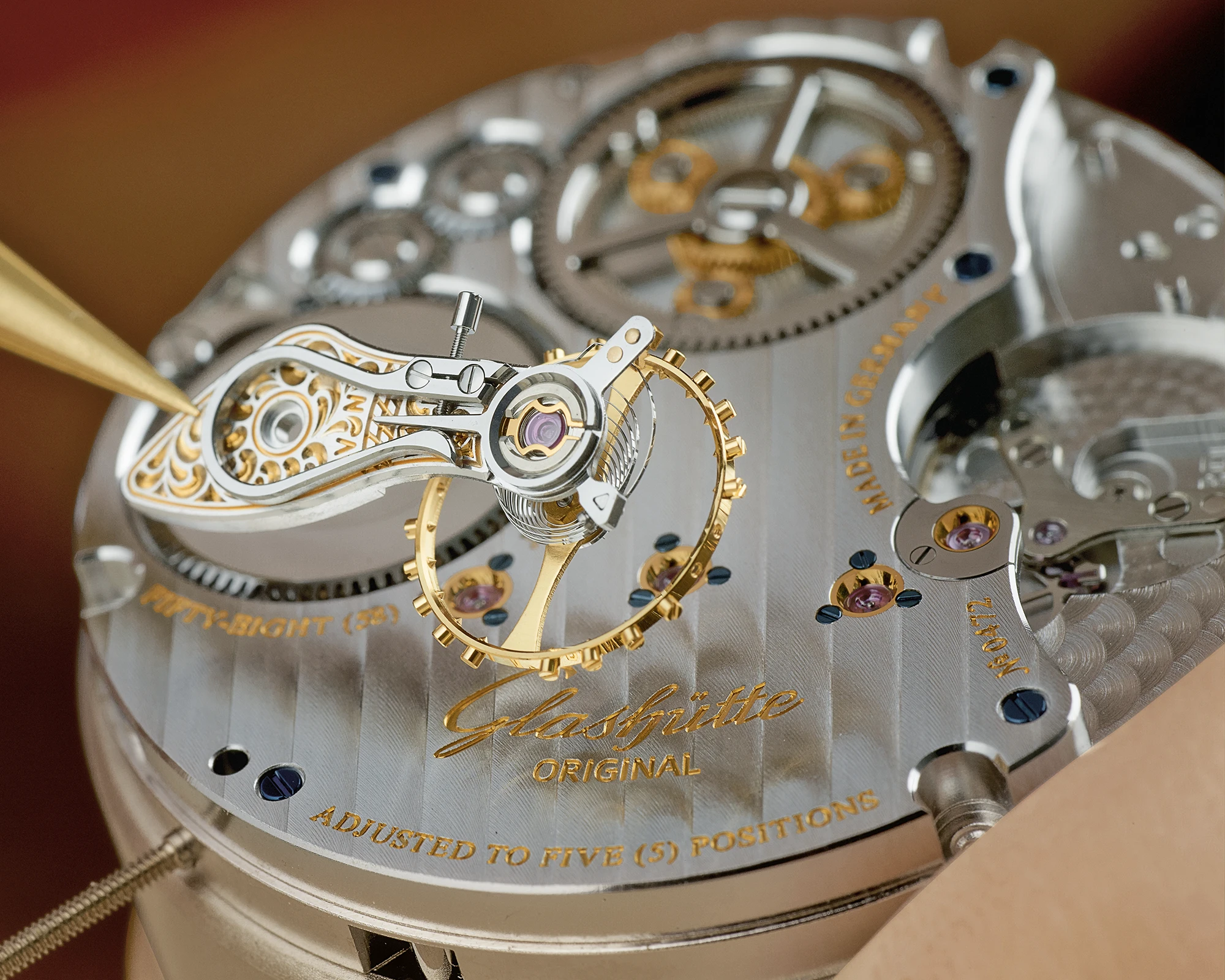
Classic watchmaking at its best: The Senator collection
The Senator series with (almost all) central time display describes classic watchmaking artistry in its purest form at Glashütte Original, but also shows how innovative the manufacture really is when it comes to the design and development of exceptional movements. One milestone in the history of the model was the Chronograph Calibre 37, which was introduced in 2014 and celebrated its premiere in the Senator Chronograph with Panorama Date. It closed a gap in the range of Glashütte Original calibres with automatic winding, panorama large date display and switching wheel control. It has over 450 individual parts. These calibres are currently being successively equipped with silicon hairsprings in order to significantly improve the good rate values.
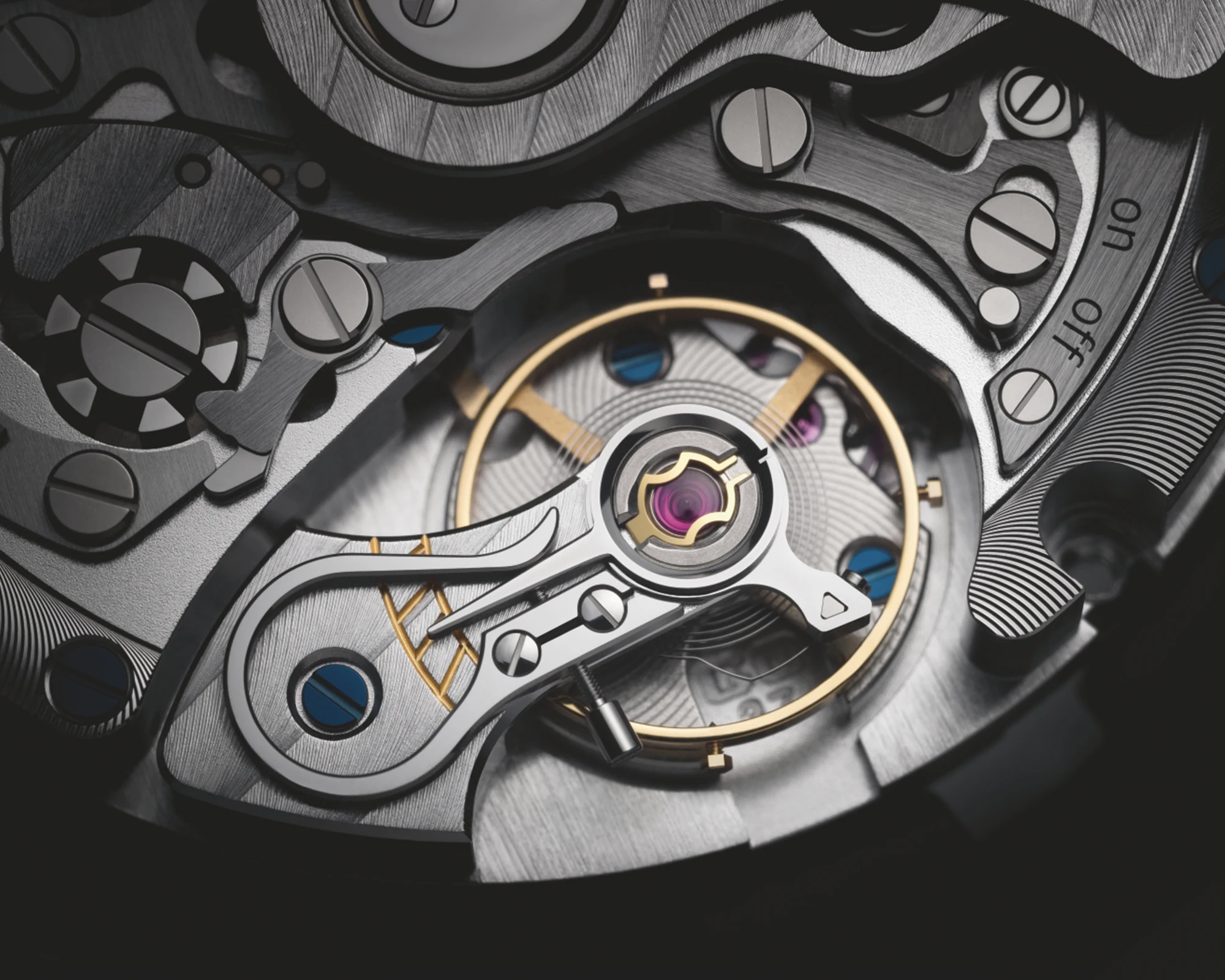
A name becomes a programme: Senator Excellence
Two years later, another milestone followed: under the name Excellence, Glashütte Original introduced its very own quality standard in the Senator series for the first time in 2016 with the completely newly developed Calibre 36. Now, such standards are not always helpful for end customers, as they sometimes tend to cause confusion, but here, too, Glashütte Original is on a par with the very big houses: these maisons can and must set themselves apart from the mass of standard mechanical movements and quality seals. This is exactly what the Excellence series does.
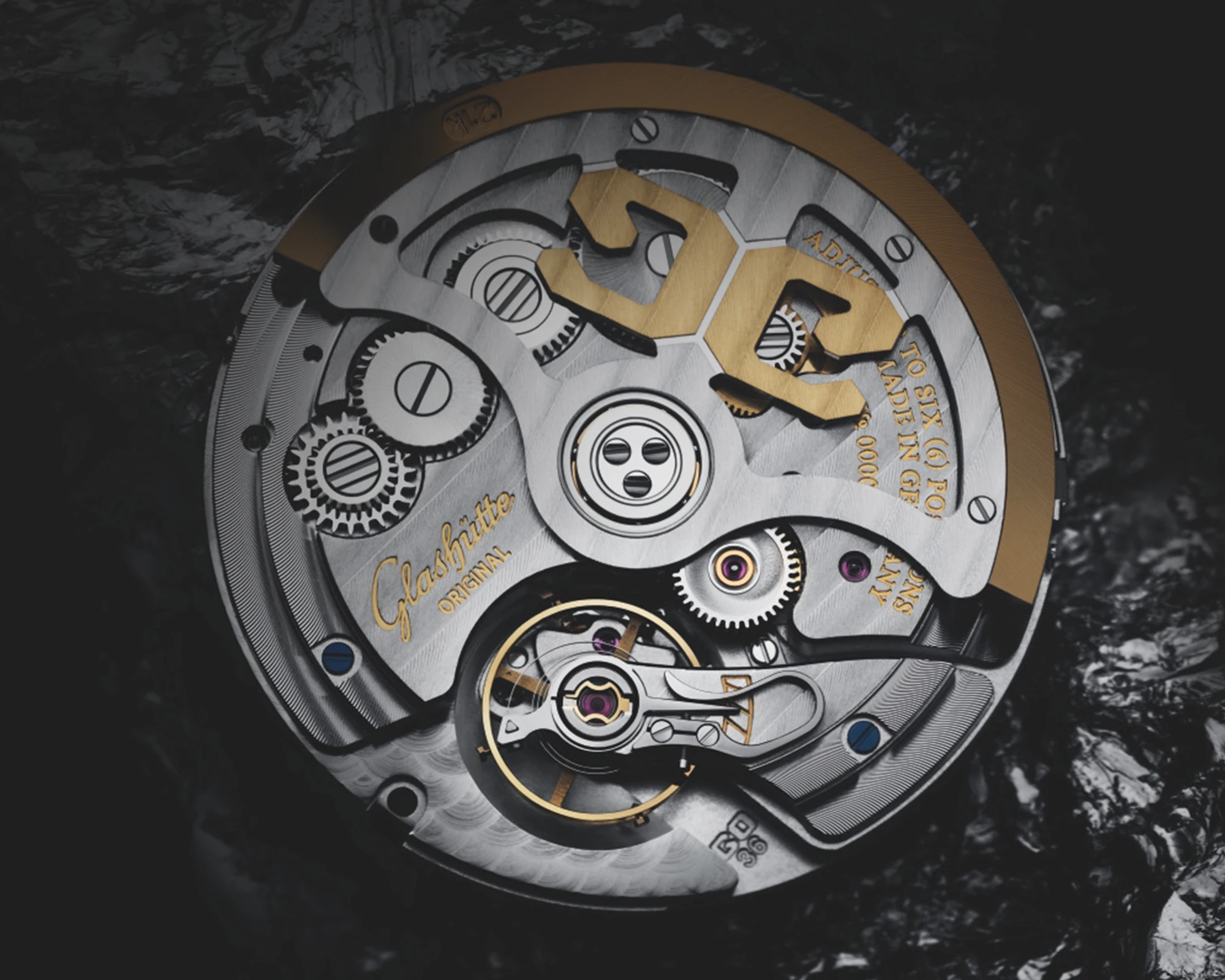
100-hour power reserve
At the heart of this special designation for watches and movements is the Calibre 36, whose silicon balance spring now stands for outstanding rate values and guarantees a running time of 100 hours. Each of these watches is put through its paces over 24 days during production, exceeding the standards of the German Chronometer Testing Institute by testing in six positions and simulating the everyday wear of the entire watch on the wrist. The highlight of this series is the Senator Excellence with perpetual calendar, which has been part of the collection since 2017. The exceptional movement is also used in the Senator Excellence (caliber 36-01), the Senator Excellence Panorama Date (36-03) and the Senator Excellence Panorama Date Moon Phase (36-24).
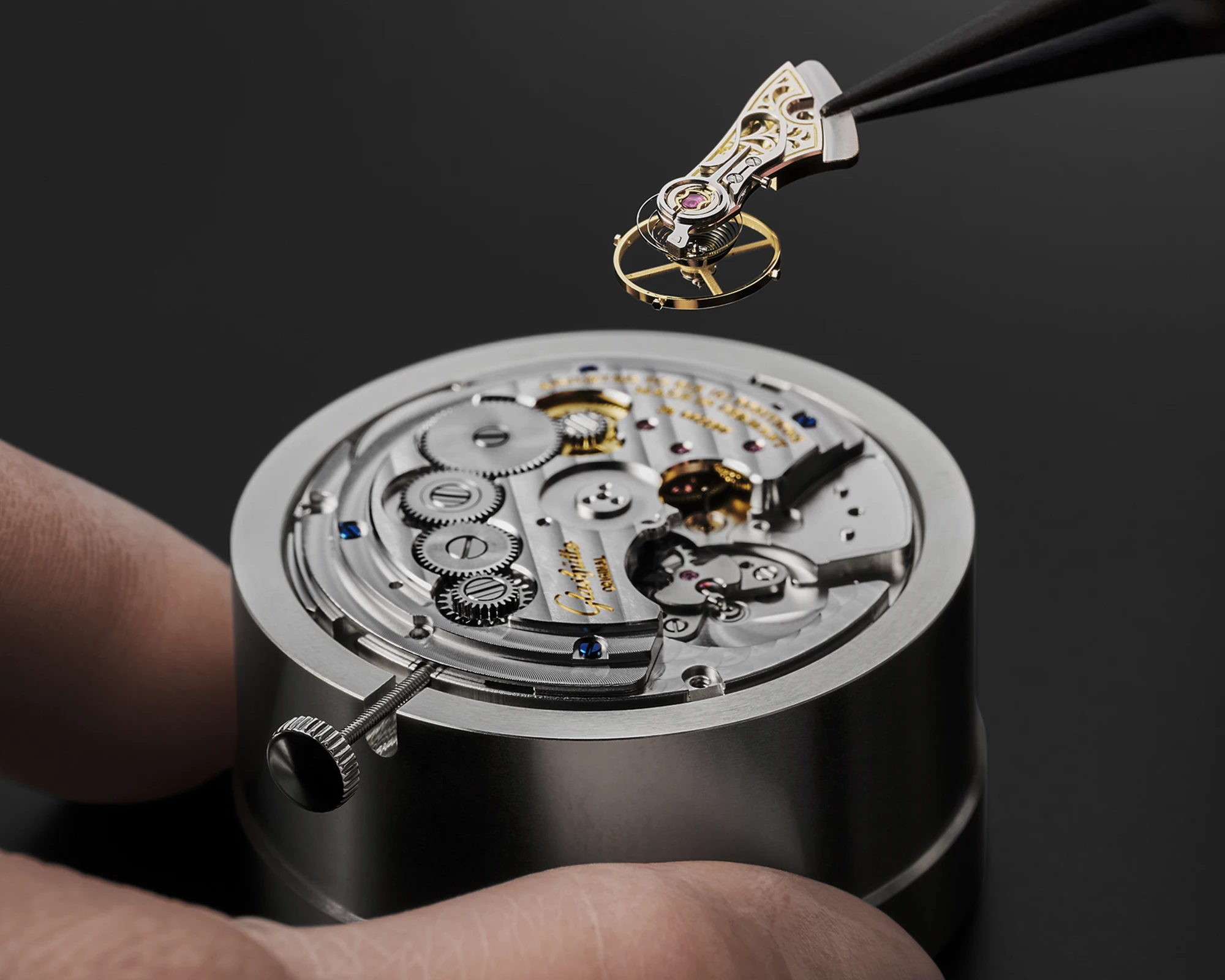
Senator Chronometer: A great legacy, elegantly implemented
Caliber 58 has a special place within the Senator series. The Senator Chronometer (58-08) is firmly part of Glashütte Original’s heritage and makes reference to the company’s ship chronometers, which have been manufactured for decades. In 2019, Glashütte celebrated the tenth anniversary of the Senator Chronometer with the Caliber 58, which since then has also featured a stop-seconds mechanism with a unique minute detent, in which not only does the second hand jump to zero when the crown is pulled, but the minute hand also moves to the nearest minute index in order to set the time perfectly: A genuine world first made by Glashütte Original.
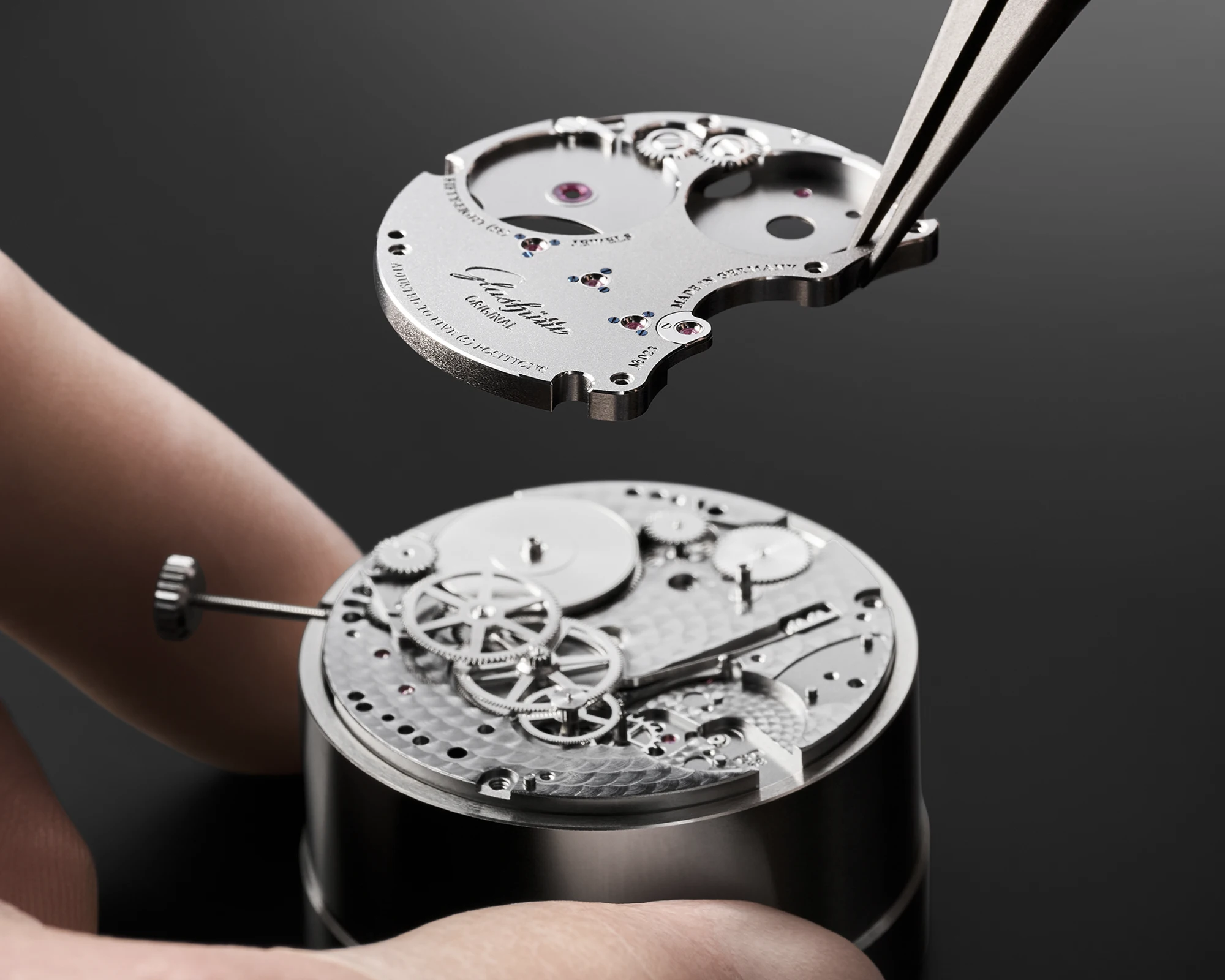
The rarest model in the Senator series
Probably the rarest model in the Senator series is the Senator Chronometer Tourbillon (58-06) and the only watch in this series with an off-centre time display at 12 o’clock. The patented flyback tourbillon is an exciting technical innovation of which Glashütte Original is justifiably proud, because the flying tourbillon invented by Alfred Helwig has even been improved with regard to its suitability for everyday use.
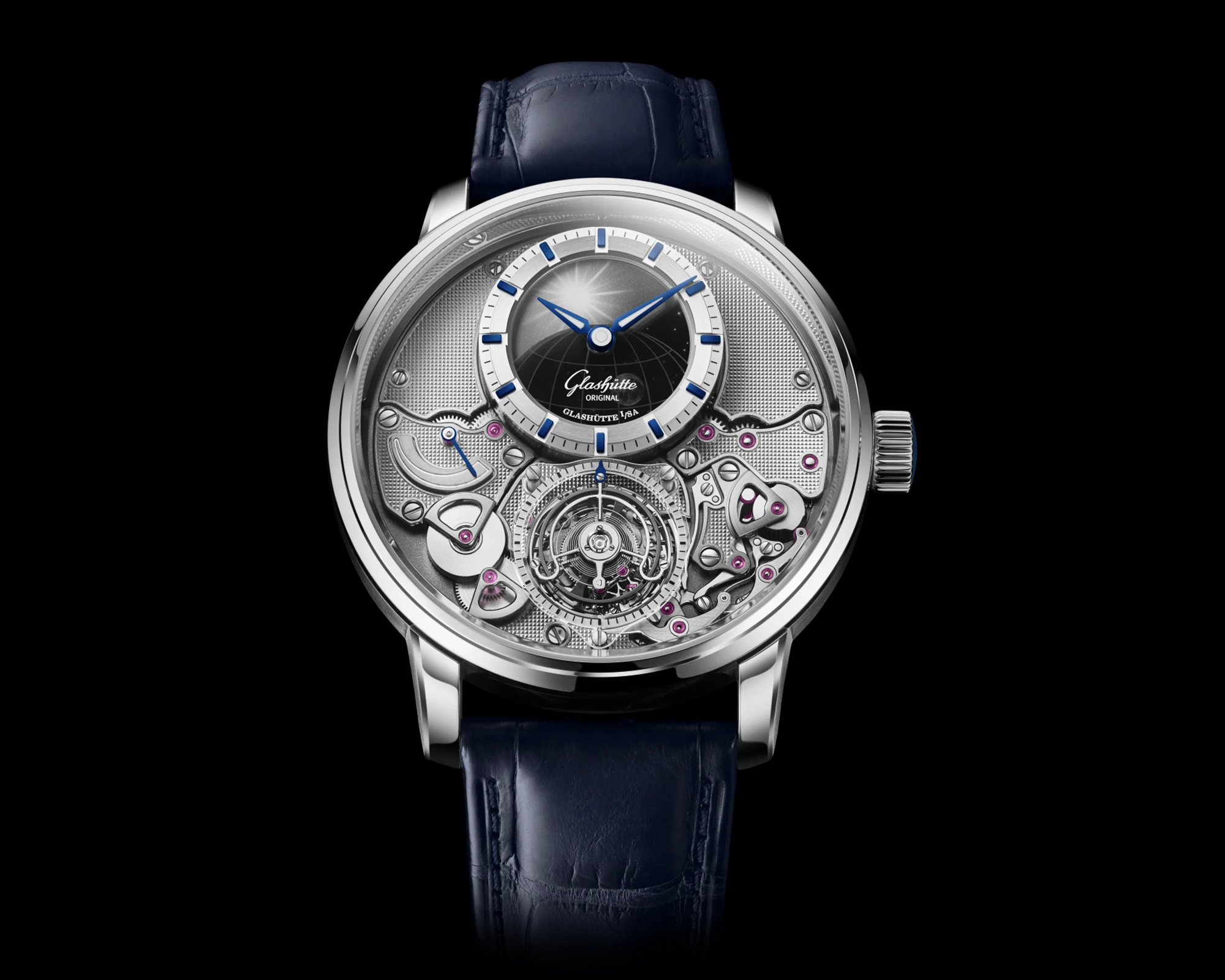
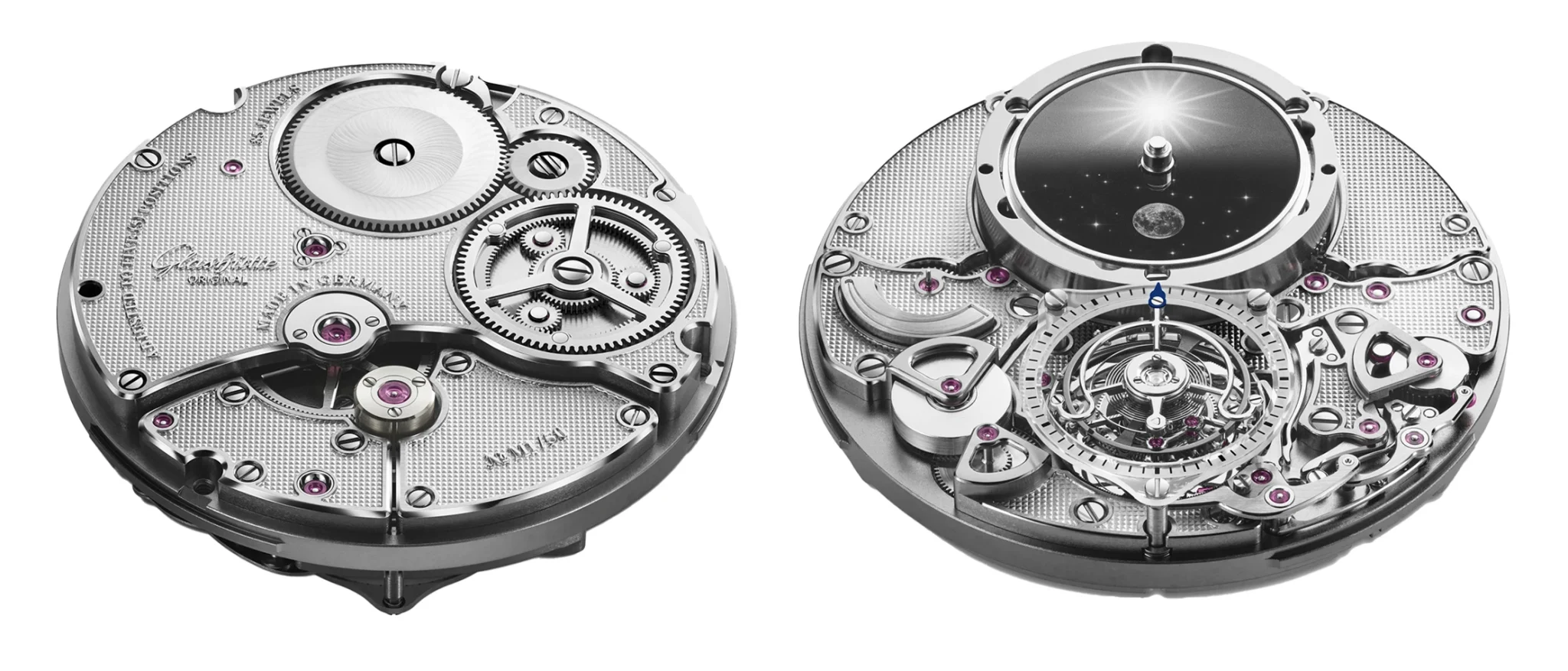
Two patents for a tourbillon with stop seconds
The editions of the Senator Chronometer Tourbillon in platinum, as recently presented in 2023, which are coveted among collectors, date back to a first model in 2019 and are very limited. Two patents have been registered for its complex design, which was the first to feature a flying tourbillon with a stop-seconds, zero position and minute detent: this allows the minutes and seconds hands to be set synchronously, with the rotating cage stopping instantly when the winding crown is pulled. As the second hand is positioned on the pivoted bogie, it stops at the same time.
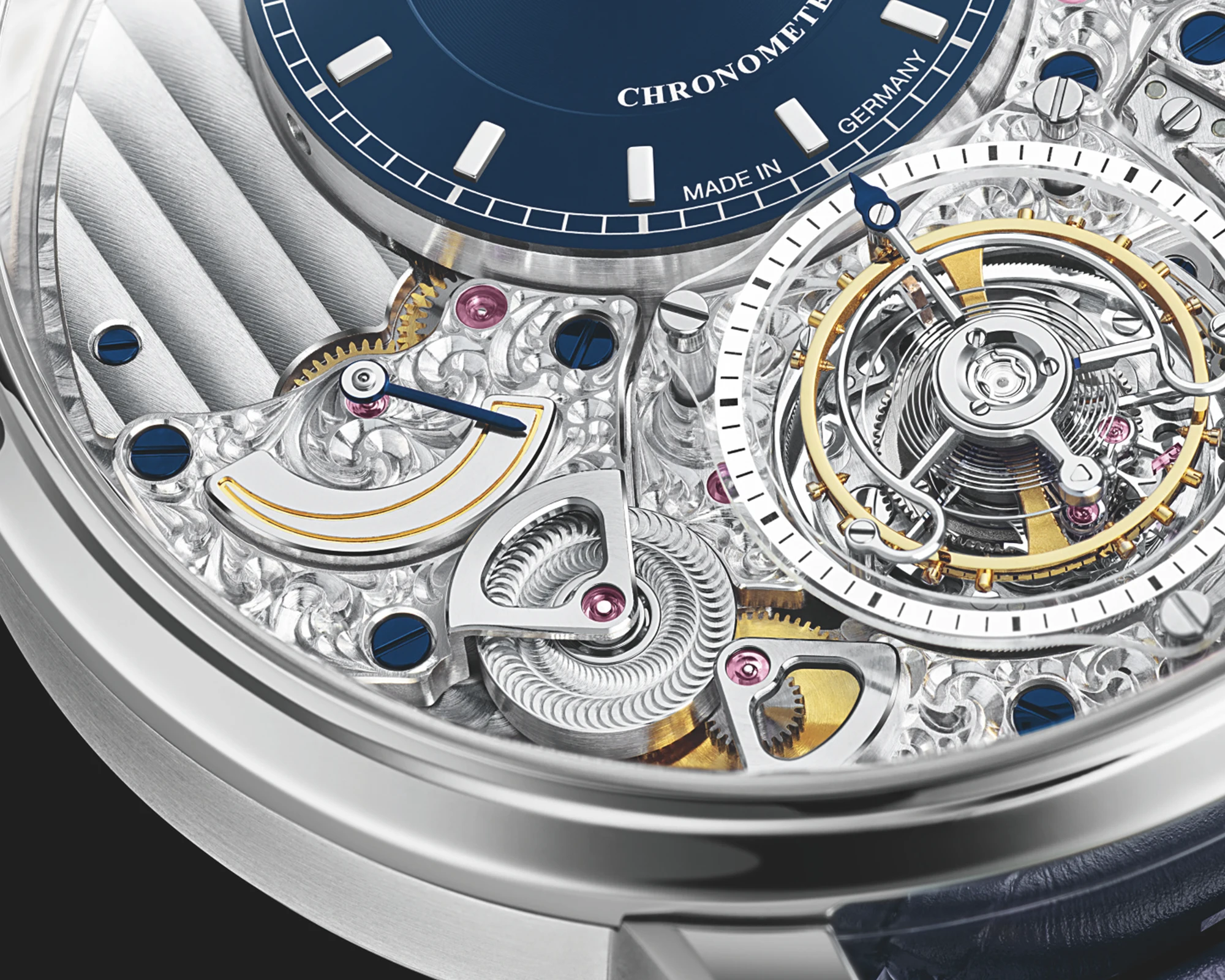
A laser engraving for the platinum model of the Senator Chronometer Tourbillon Limited Edition
The latest platinum model in the series with a silicon balance spring and 70-hour power reserve has just been unveiled. It makes this watch, limited to 50 pieces, even more precise. The top of the movement is completely finished with a filigree laser engraving, which was of course created in-house. The clous-de-paris pattern, which is thus removed layer by layer, enhances the three-dimensional appearance of the movement and gives the watch a modern look. The diameters of the Senator collections range between 40 and 42 millimetres except for two other outstanding models, the Senator Observer, which goes back to the famous observation watches, and of course the unique Senator Cosmopolite.
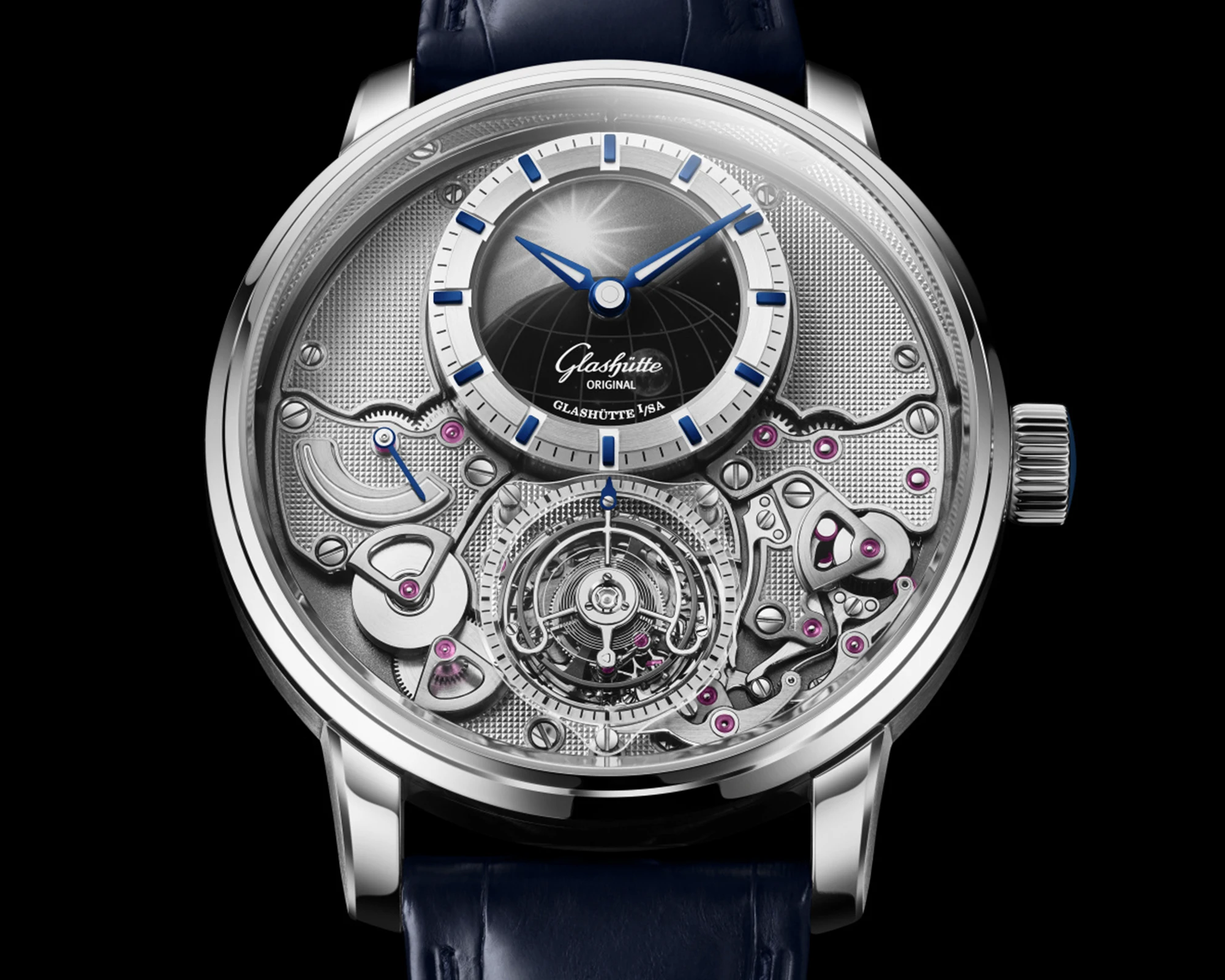
At home all over the world
The “Grande Cosmopolite Tourbillon”, launched in 2012 and still one of the most complicated wristwatches ever produced in Germany, is considered a milestone at Glashütte Original. The movement, with a perpetual calendar that can be set forwards and backwards as well as a tourbillon mechanism, also featured a time zone display of all 37 global zone times at the time. Work on this platinum watch with a diameter of around 48 millimetres began around five years before its official presentation at Baselworld, the world’s most important watch fair at the time.
A hand-wound calibre with 500 parts and a spring cover
The hand-wound calibre 89-01 with over 500 components can be admired through the sapphire crystal case back when the classic spring cover on the back is opened. On the front, the watch breaks with tradition in the form of two viewing windows, which for the first time depicted all 37 time zones in the world at the time, including those with half and quarter hour offsets and the differences between summer and winter time. As these time zones are often subject to political interests and could change over time, the engineers at Glashütte Original designed the city ring on which this movement is based in such a way that it is interchangeable.
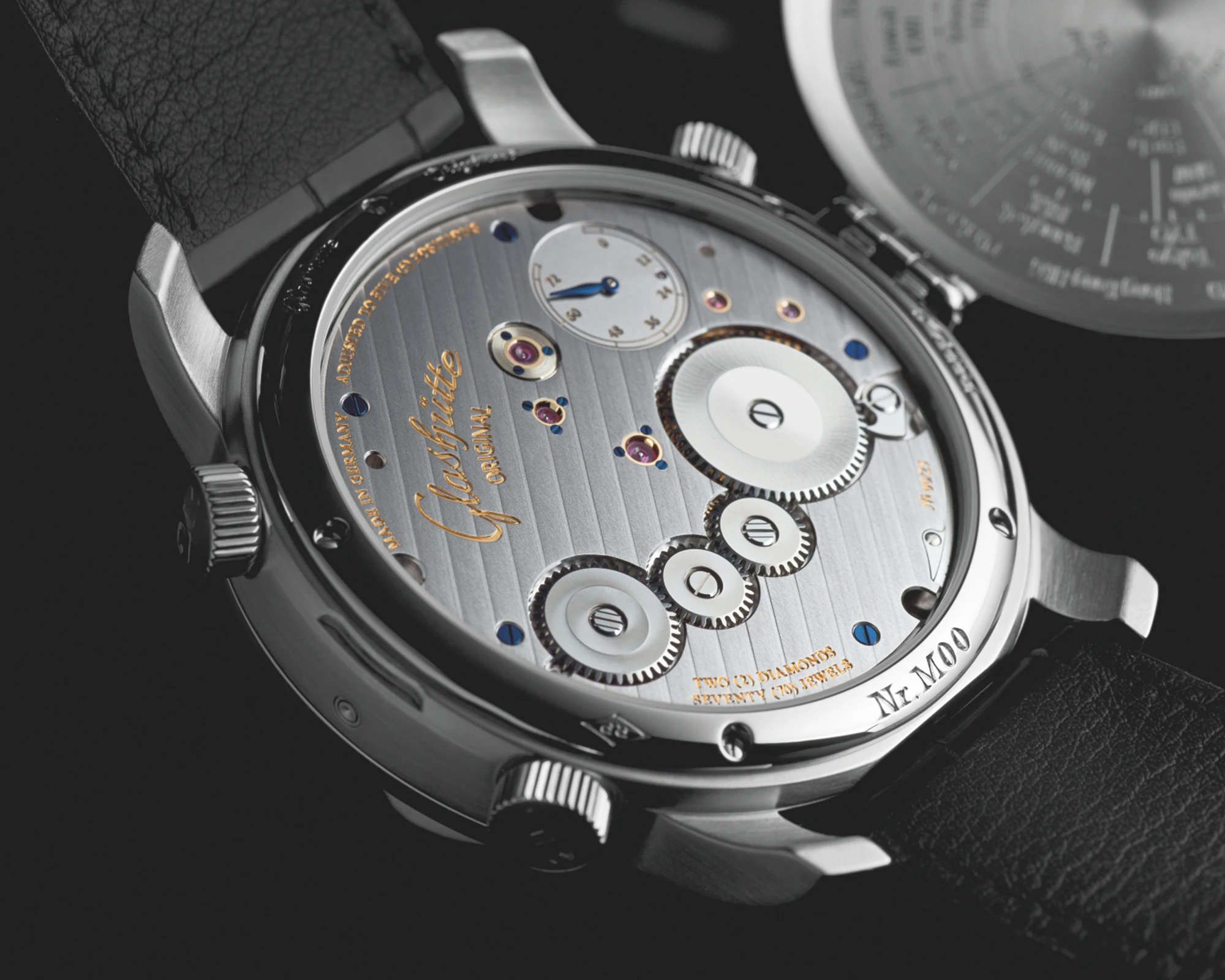
The IATA codes of the city names are engraved in the spring cover
Glashütte Original registered four patents for the watch. Incidentally, the IATA codes of the airports are linked to city names in the jumping lid of the watch so that each time zone can be correctly assigned.
In series production since 2015: The Senator Cosmopolite
In 2015, the Senator Cosmopolite was launched as a series watch of this exceptional model, which initially displayed all 37 time zones (now 35) using the IATA codes of well-known airports, albeit without the perpetual calendar and flying tourbillon functions, but with small seconds, day, night and power reserve indicators and a stylish panorama date. Which brings us to the second collection, the Pano line.
A modern classic from Glashütte: the Panorama Date
As always, it is the technical details that lead to the international breakthrough of special watches and make them stick in people’s minds. The large date known as the Panorama Date is not only extremely practical, it also makes the new models from Glashütte Original instantly recognizable as mechanical watches. The designers succeeded in placing both date disks on the same level, so that for the first time it was possible to dispense with the concealing central bar.
A German watch face?
The Pano collection can be recognized above all by the off-centre design of the dial with a time display at 10 o’clock and small seconds at 7 o’clock. Internationally, this dial layout has even established itself among collectors as the “German watch face”, so unusual was it when it was launched. These watches are probably the first thing that collectors think of when they think of Glashütte Original.
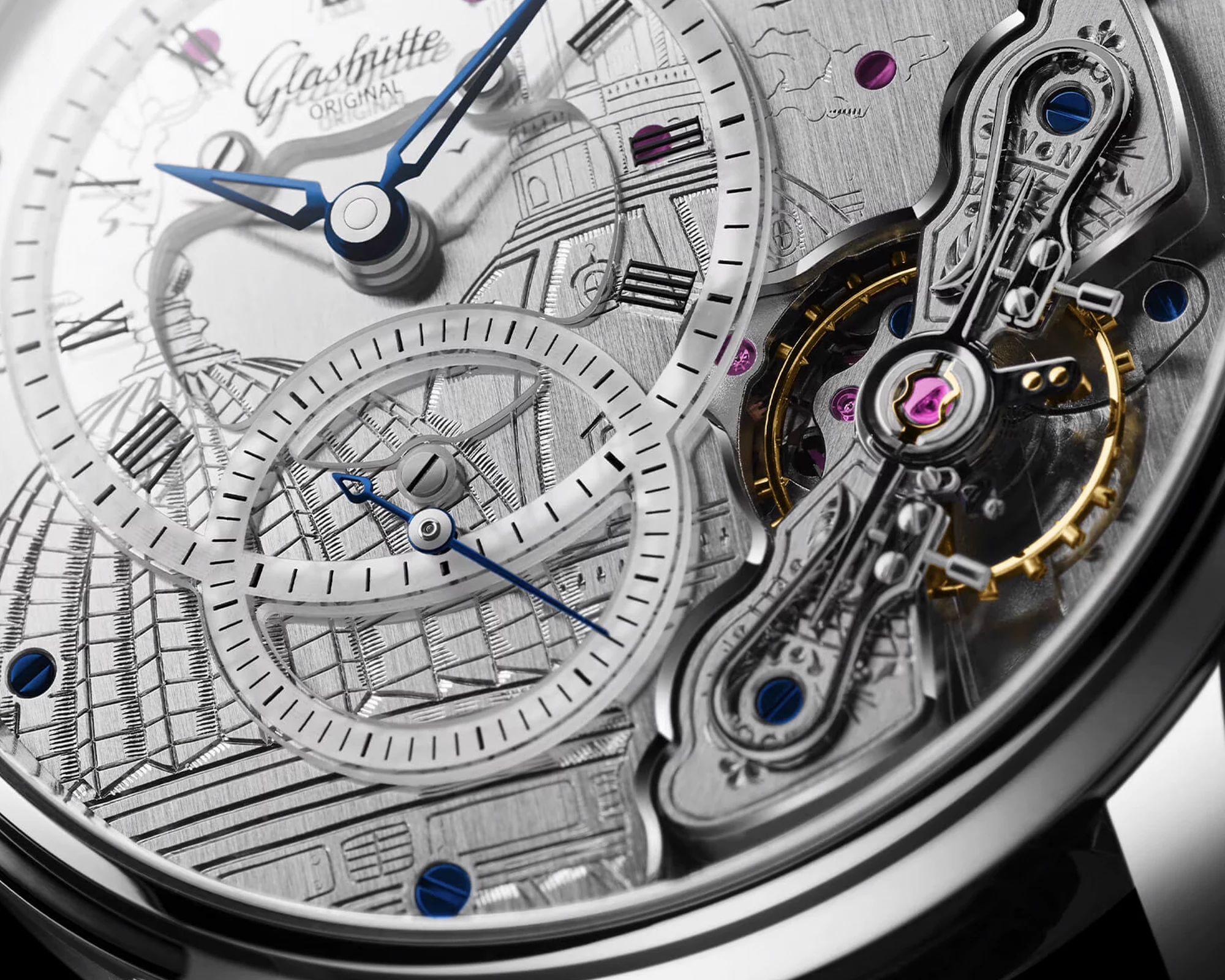
A successful model for over 20 years
The PanoMaticLunar and the PanoReserve in a slightly larger 40-millimetre case form the core of the Pano edition, which was redesigned in 2012. The famous Panorama Date, which gives the watch line its name, is located at 4 o’clock, while the moon phase is at 2 o’clock. The movement: Calibre 90-02 with automatic winding, three-quarter plate with Glashütte stripe finish and hand-engraved balance bridge with duplex swan-neck fine adjustment, all of which can be admired through the sapphire crystal case back. No one is surprised that this watch has just celebrated its 20th anniversary with the PanoMaticLunar, whose movements are among the most beautiful Glashütte Original has to offer.
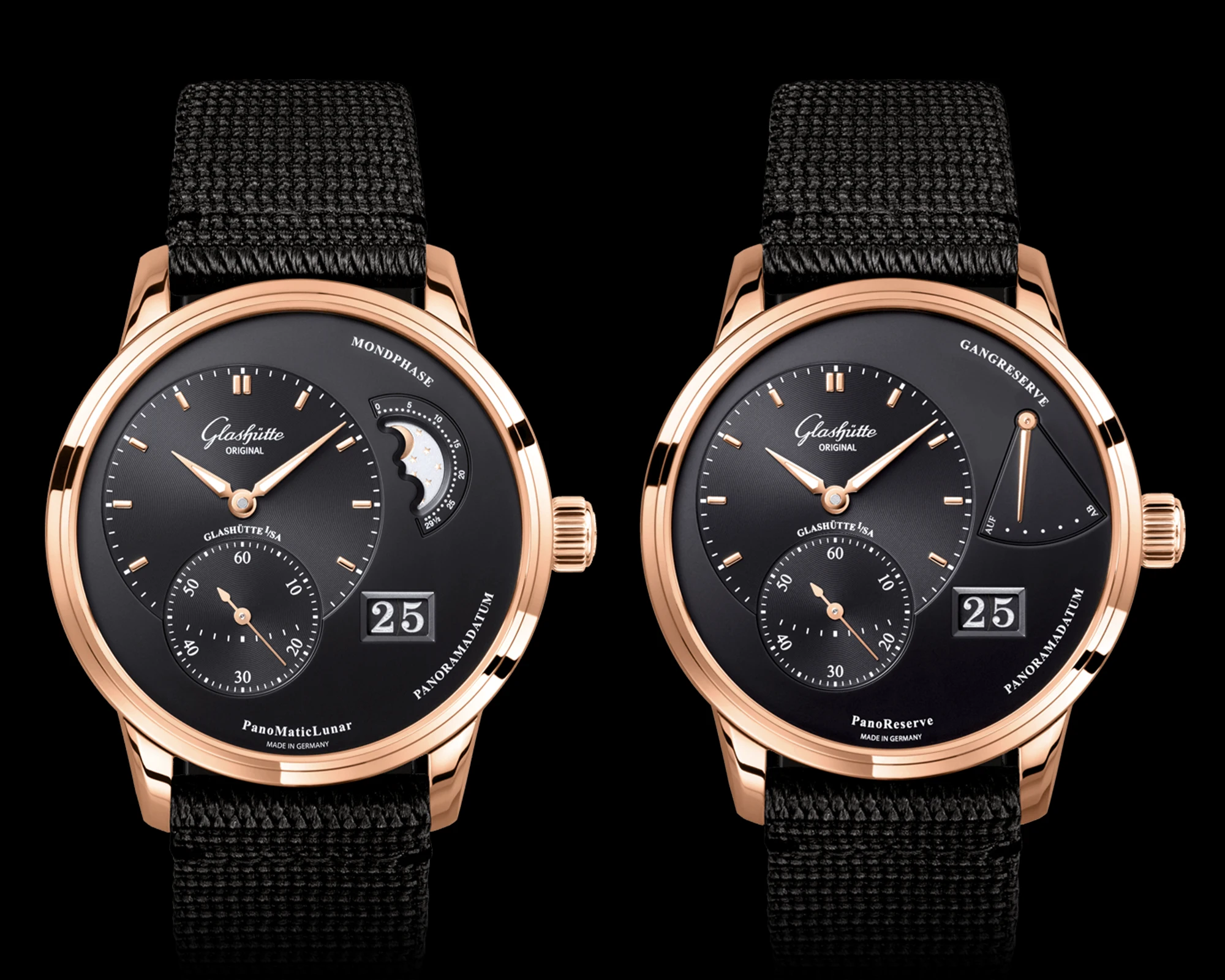
Hand-wound or automatic: both are a matter of course at Glashütte Original
The PanoReserve also has the style-defining decentralized dial of its sister with a time display at 10 o’clock and small seconds at 7 o’clock, but the model is powered by the hand-wound calibre 65-01, whose sapphire crystal back allows a view of the entire hand-finished movement without a winding rotor. But Glashütte Original also has something very special for anyone who finds it a shame to hide the elaborately finished movements on the back.
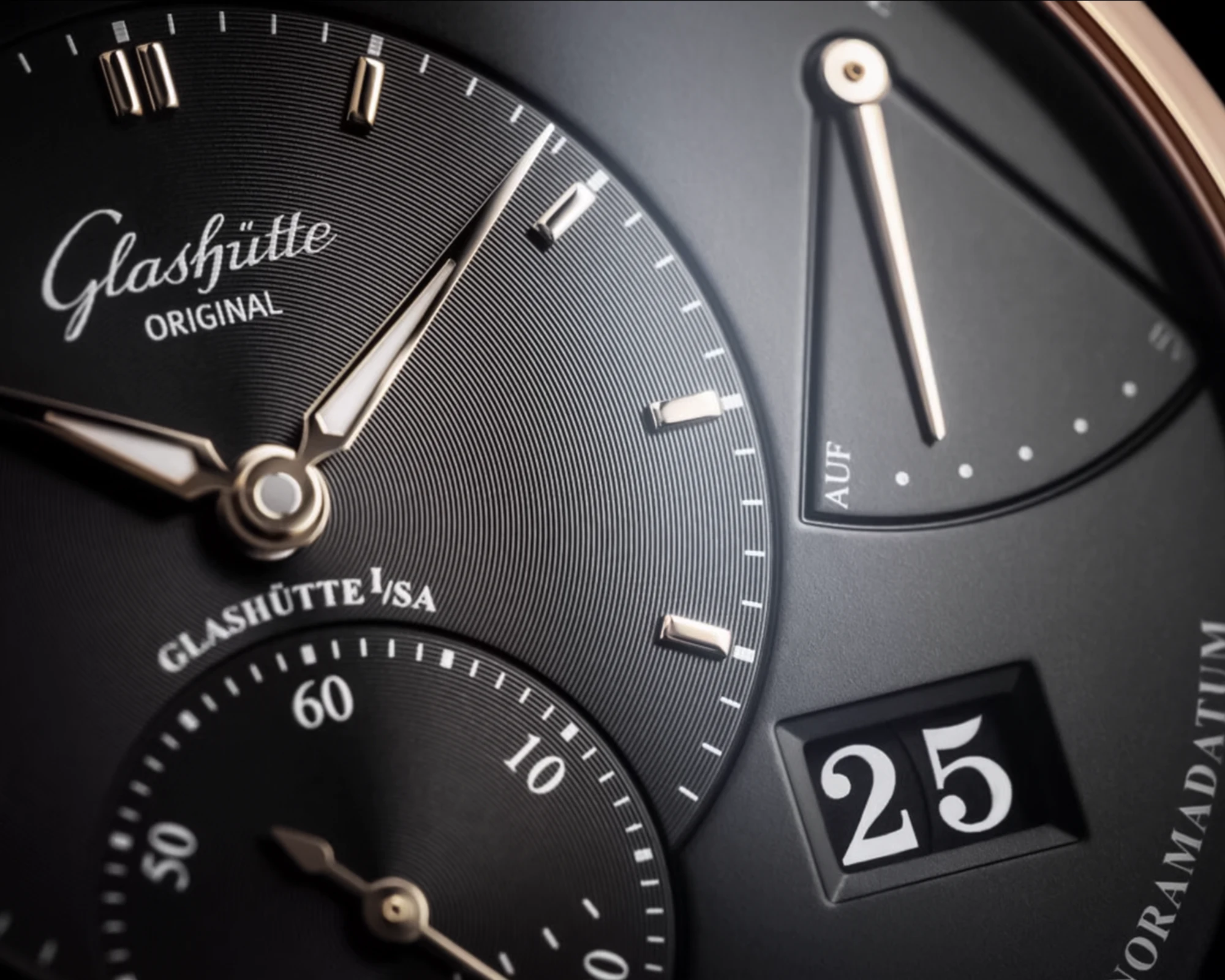
The PanoInverse collection
According to the company’s own book ‘Impressions’, which I mentioned at the beginning, the idea for this particular model was born in a casual conversation between a sales representative and a colleague from product development. According to him, customers regretted that they could not admire the beauty of the movements while reading the time. The idea took root and, as a result of this conversation, the first model of the PanoInverse was presented to the public in 2008. A watch that dispenses with a classic dial and leaves the most important elements of the mechanical movement visible on the front without compromising readability. As a result, the PanoInverse is probably the most mechanically poetic watch on offer.
PanomativInverse, the marvel is also available as an automatic model
The inverted cadrature model is now also available as an automatic model, which is currently being offered in a sensational limited edition of 25 pieces: the PanoMaticInverse Limited Edition. This time, the hand engravers at Glashütte Original have immortalised typical views of Dresden on its frame parts: the hand-engraved silhouettes of famous Dresden buildings and panoramas are created with great dexterity.
The silhouette of Dresden on the movement
On the front, the roof of the Academy of Fine Arts is immortalised with the winged Fama statue, next to the unmistakable ‘lantern’ on the dome of the Dresden Frauenkirche. Its shape is echoed on the reverse by a skeletonized rotor spinning above an idyllic view of the Elbe promenade. This scenery reveals new details at every glance. The balance bridge is decorated with baroque ornaments, and the sky above the city’s rooftops features not only birds and clouds, but also a small hot-air balloon – a sight familiar to every Dresden resident. The dial of the decentralised time display allows the engravings underneath to make a grand entrance thanks to sapphire crystal rings, which ensure maximum transparency and make it appear to float above the artfully decorated plate. In contrast to the PanoInverse model with manual-winding movement, whose calibre 66-12 has a power reserve display (please be sure to check out the PanoInverse Limited Edition Grossstadt in platinum!), its sister movement, the automatic calibre 91-03, offers an off-centre display of hours, minutes and small seconds as well as the classic Panorama Date.
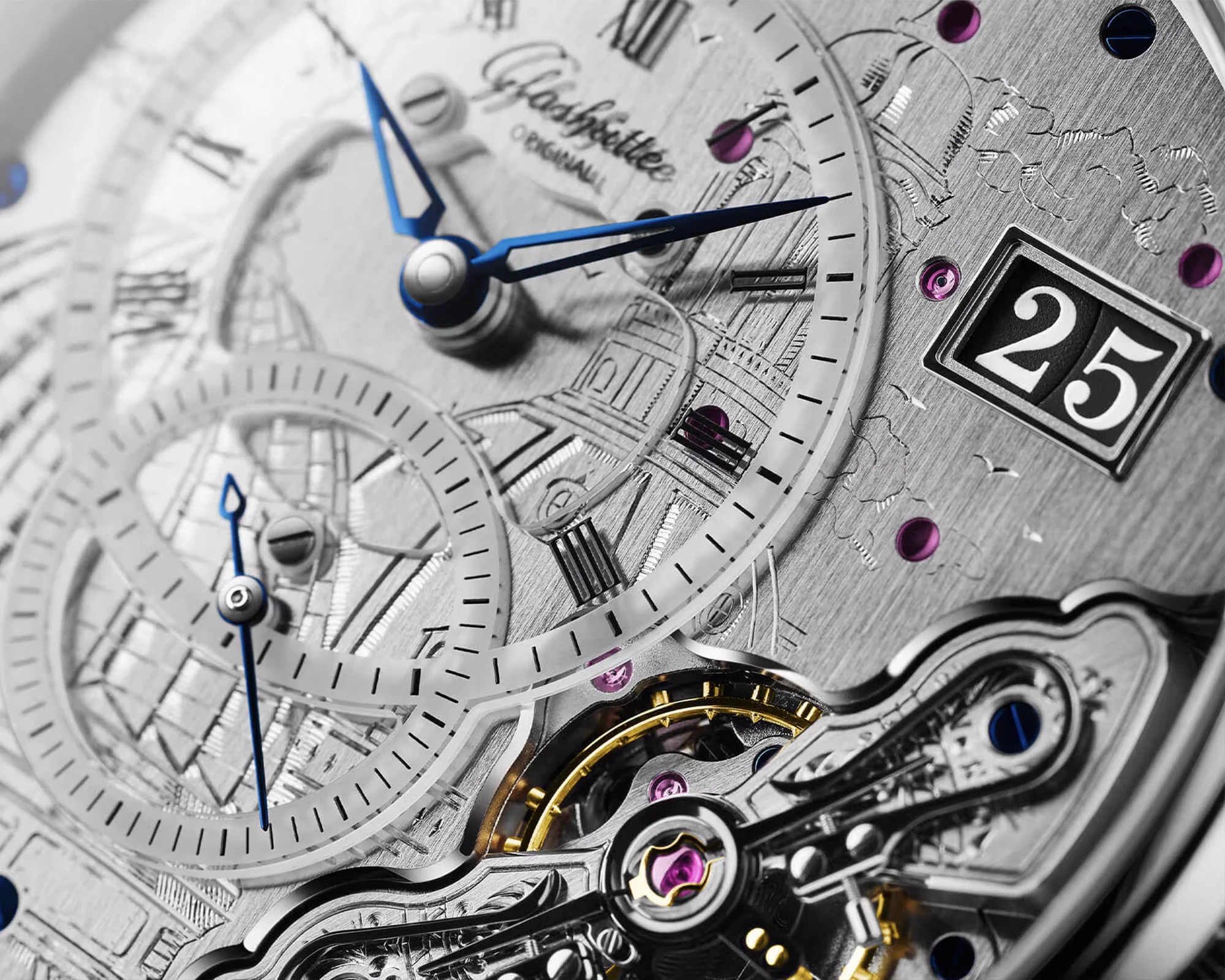
There are still two collections to go so that this overview does not get completely out of hand. But you quickly realize that the danger with this manufacture is rather to get lost in the details and its history.
A special time for special wristwatches: The Sixties and Seventies
While in Switzerland a certain Gerald Genta, probably the most famous watch designer in recent history, unmistakably left his mark on the sixties and seventies of the last century, the term ‘Vintage collection’ at Glashütte Original is not a kind of imitation of popular design trends of today, but rather a special feature of the company that is closely linked to its eventful history.
Stylistic example of East Germany
The models in the Sixties and Seventies series refer to watches and styles from the GDR era, which is special in itself, because perhaps many other manufactures would rather conceal the larger quantities in their history than emphasise them with special pieces. Not so with Glashütte Original. The vintage models are a tribute to the style of their time and the historical models were predominantly mechanical wristwatches. Their limited-edition versions in particular, with changing, expressive dials alluding to historical models from the dial manufactory in Pforzheim in western Germany that supplied them at the time, are now attracting a great deal of international attention. Today, the company is proud of this part of its history and has developed exciting colour variants of dials with the Sixties annual editions, which are only offered in one production year at a time.
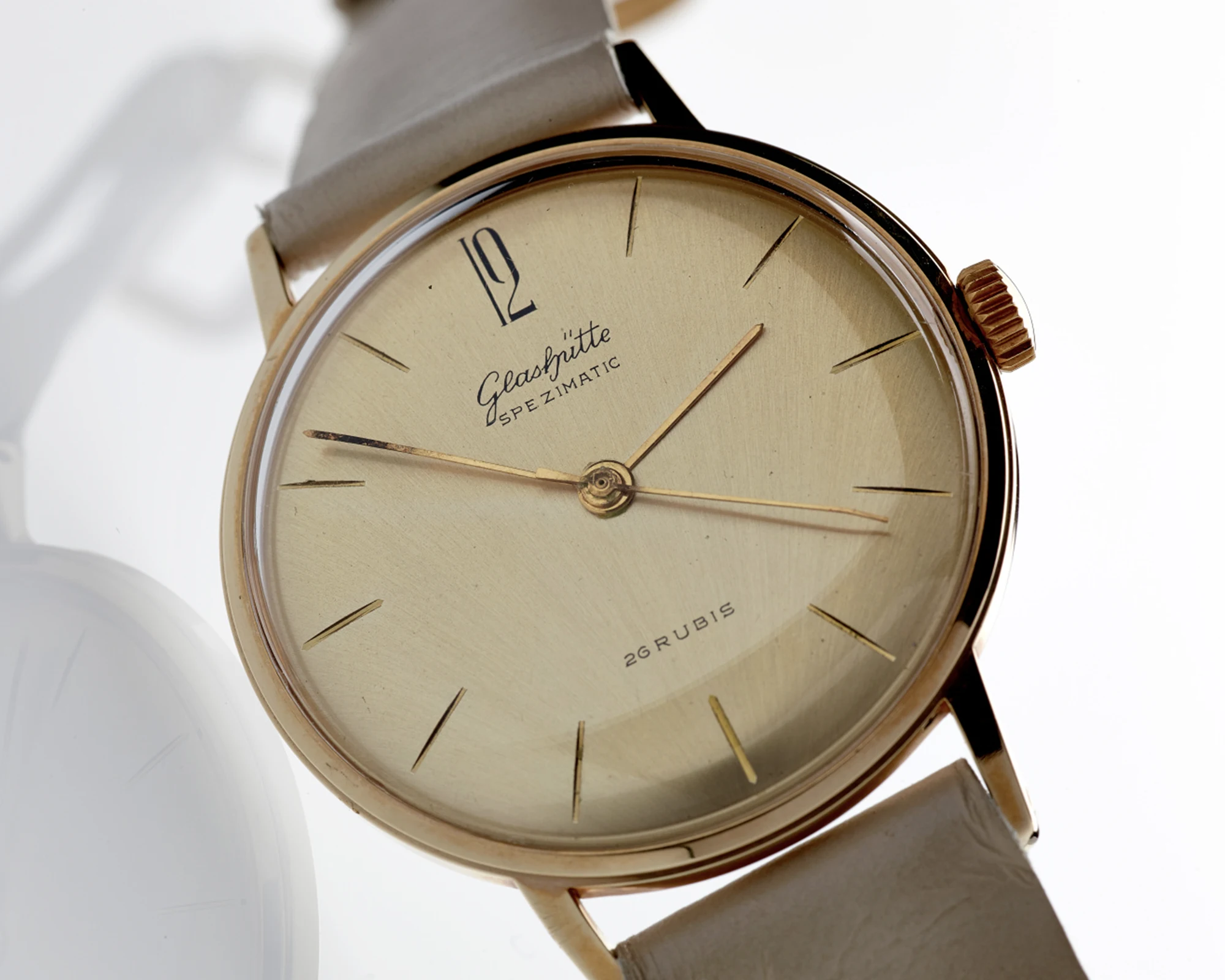
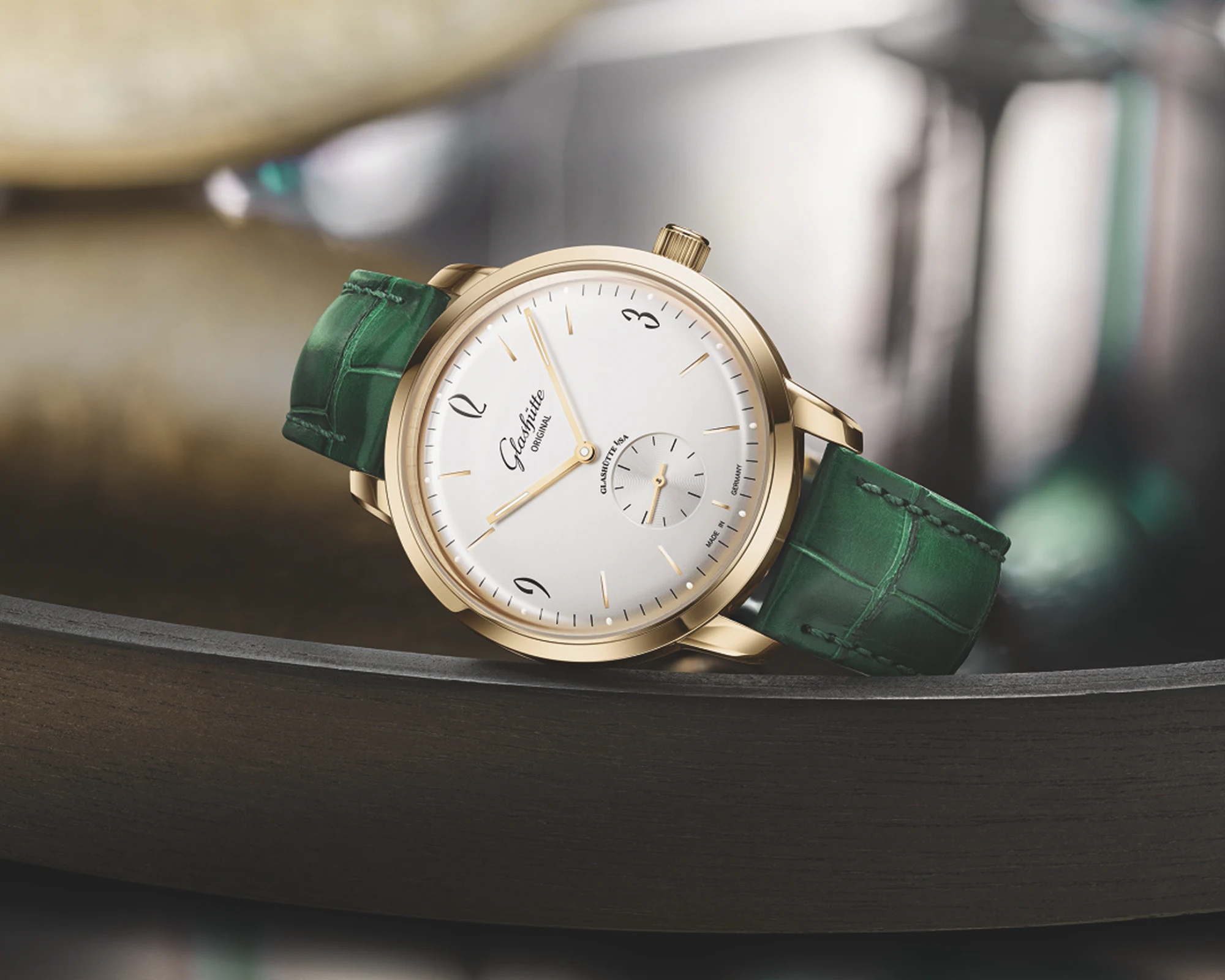
Credit © Archiv Deutsches Uhrenmuseum Glashütte
Legendary timepieces: Spezimatic and Spezichron
Today, collectors of historical models are looking for well-preserved predecessors of these models, the so-called Spezimatic and Spezichron. The best-known watch in the GDR era was the Spezimatic with calibre 74 and 75 as the basic model, of which an incredible three (!) million were built between 1964 and 1969. The second model, the Spezichron, with its characteristic TV screen design, from which the design of the current Seventies was later derived, was produced from 1978 to 1985 and featured calibre 11. It was available with a date display or with a day and date display and was also the first shock-resistant watch to be produced by GUB. Waterproof diver versions were created for combat divers in the GDR. The hand-wound calibre 09-20 – was originally developed for ladies’ watches but was later also used in men’s watches – was even produced until 1990. It was also the last mechanical movement to leave the Glashütte factory during the GDR era.
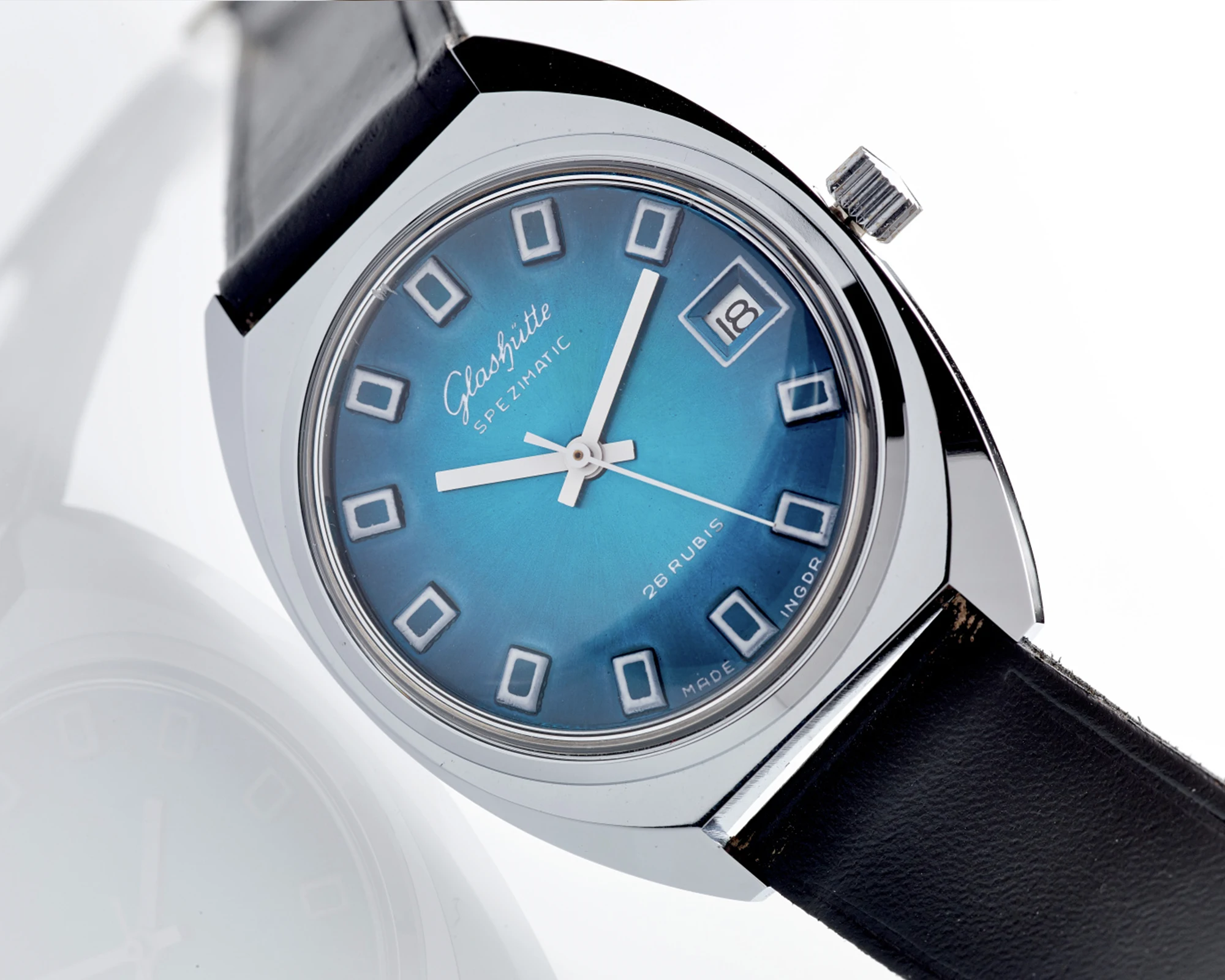
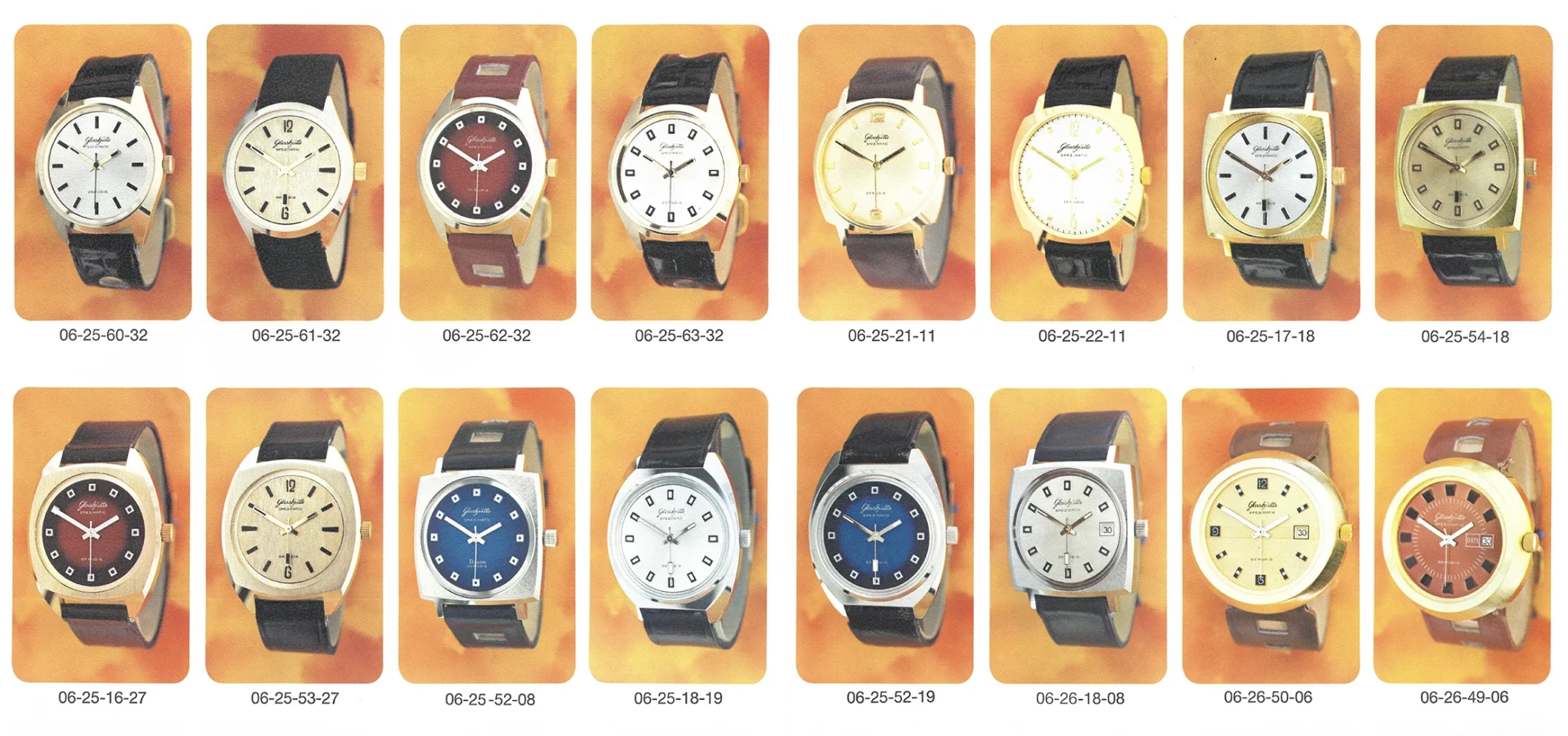
Credit © Archiv Deutsches Uhrenmuseum Glashütte
2015: The Seventies receives the in-house chronograph calibre 37-02
Since 2015, the Seventies collection has also been able to enjoy the in-house chronograph calibre 37-02 with flyback mechanism, power reserve display and panorama date. The current highlights are the two Seventies Chronograph Panorama Date models, each limited to 100 pieces with a rubber or stainless-steel bracelet in the dial variants “Golden Bay” and “Ocean Breeze”. All Seventies models are also water-resistant to 100 meters.
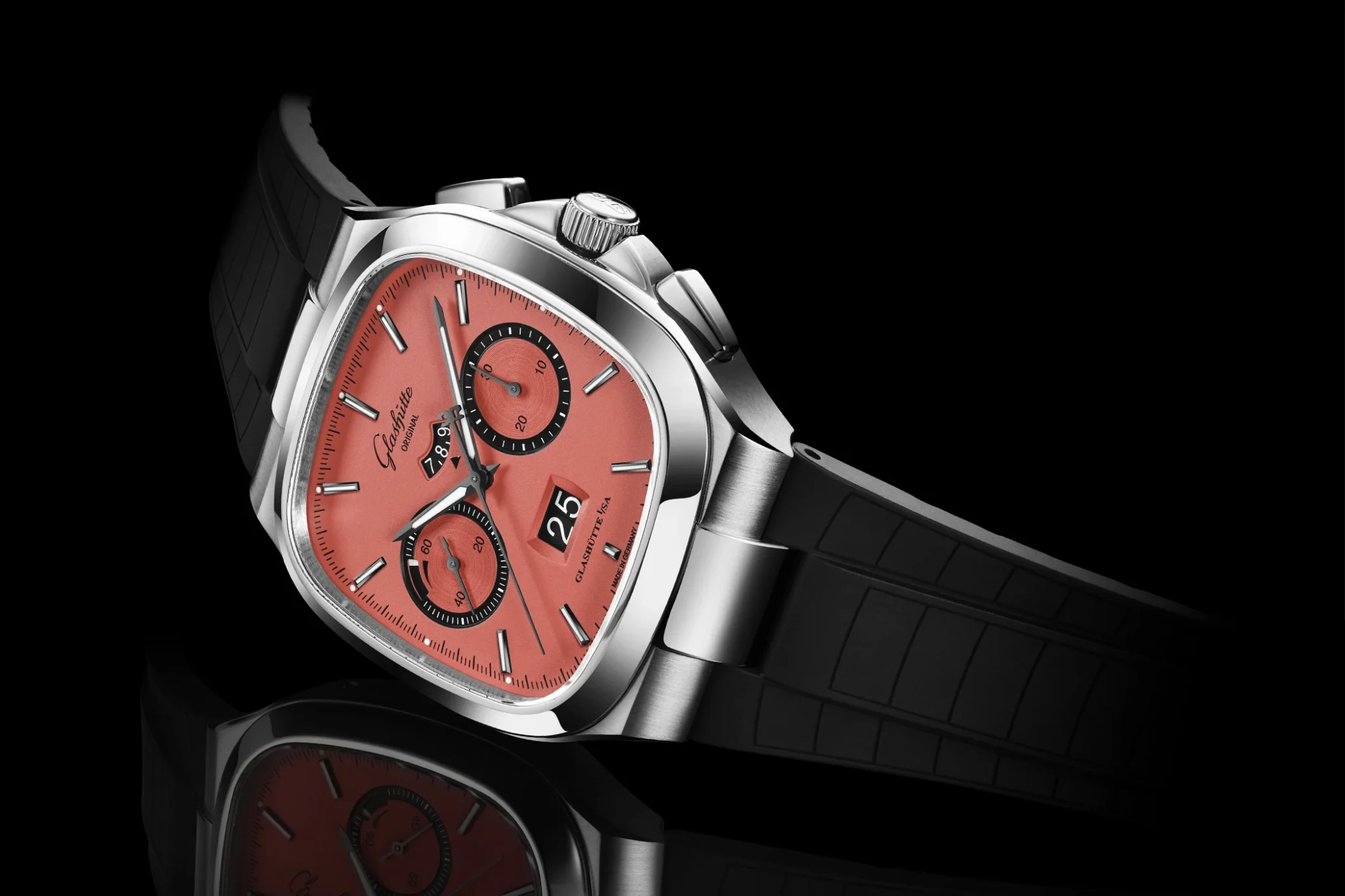
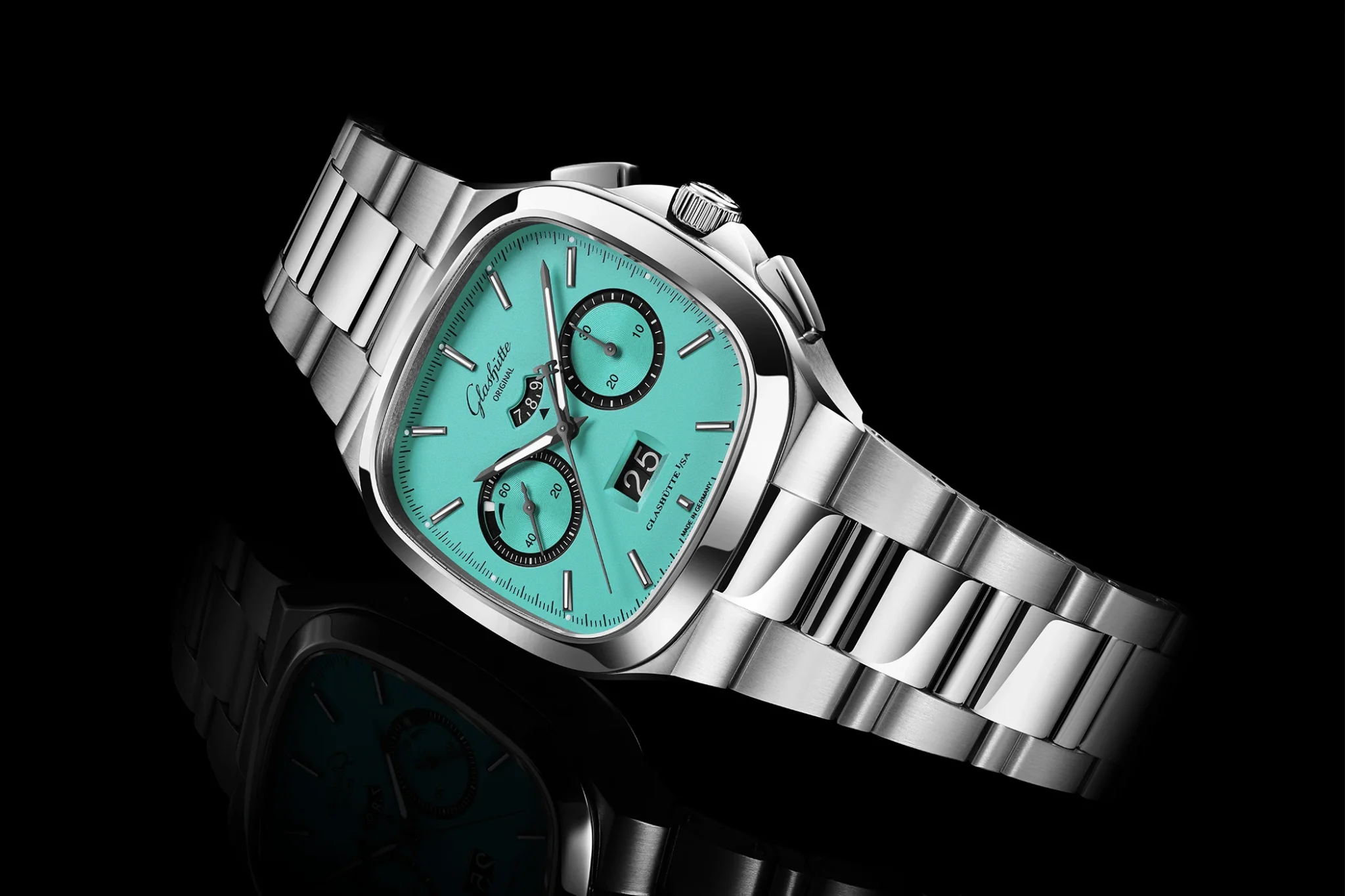
SeaQ – a new era for Glashütte Original
It is no coincidence that the DIN and ISO-certified SeaQ diver’s watch is reminiscent of classic diver’s watches from the 1960s. Specifically, it goes back to a model from the manufacture from 1969, the so-called Spezimatic RP TS 200, which was produced in small numbers for combat divers in the GDR. Sport and recreational divers were virtually non-existent in East Germany. It remains to be seen whether this was perhaps because people feared that too many citizens would try to leave the country via the Baltic Sea. And even if the Baltic Sea is pleasantly warm for swimming in summer, there were no coral reefs there during the Iron Curtain era and there probably won’t be any in the foreseeable future.
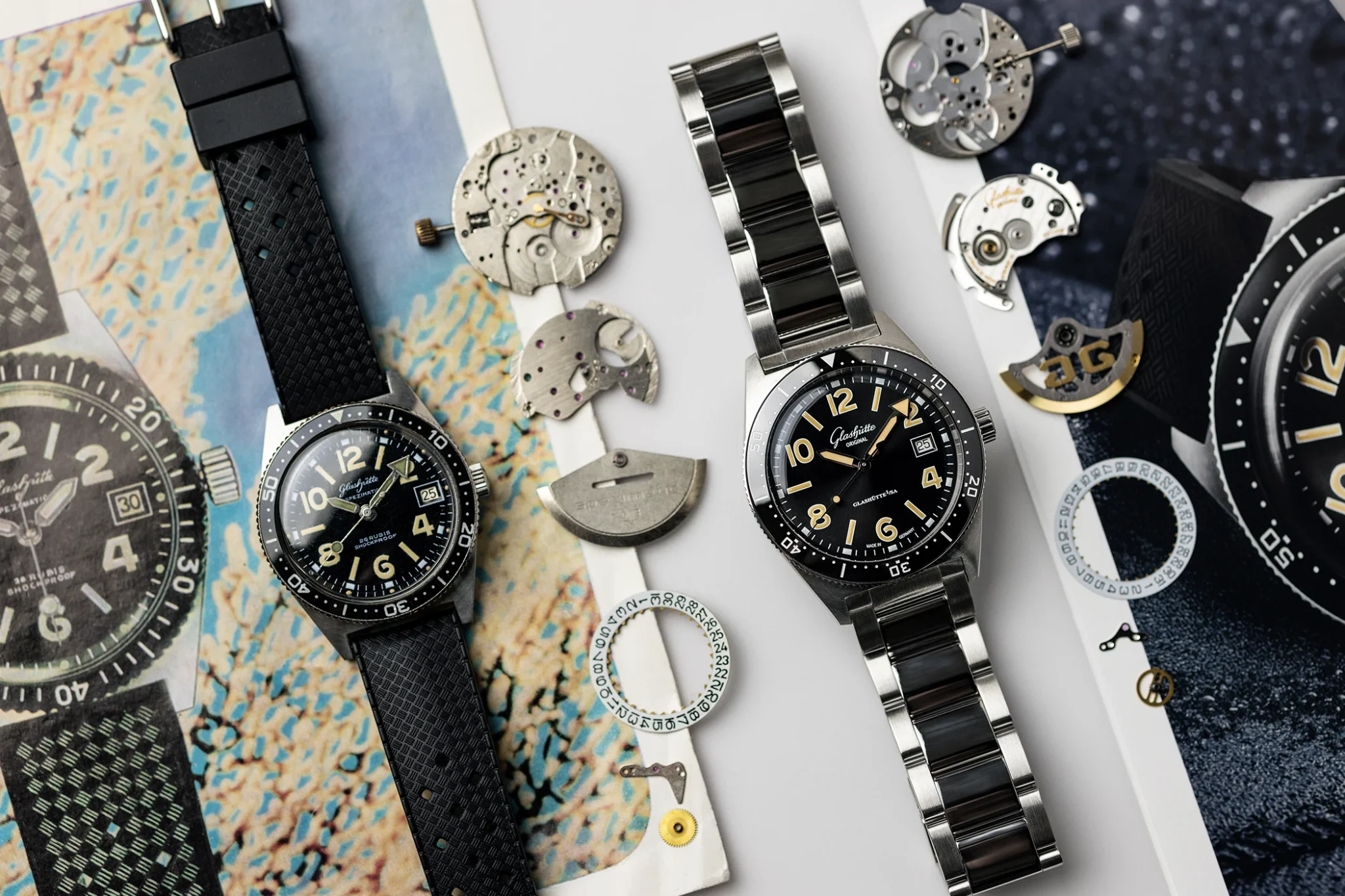
A success story at the second attempt
Today, the exact opposite is the case: demand for these exceptional watches continues unabated. The two top models are the SeaQ Panorama Date and the corresponding chronograph with a case diameter of 43.2 millimeters. The aforementioned calibre 36-13 with silicon balance spring and 100-hour power reserve and the chronograph calibre 37-23 work inside the diver’s watches, which are water-resistant to 300 meters and have a ceramic bezel and sapphire crystal caseback.
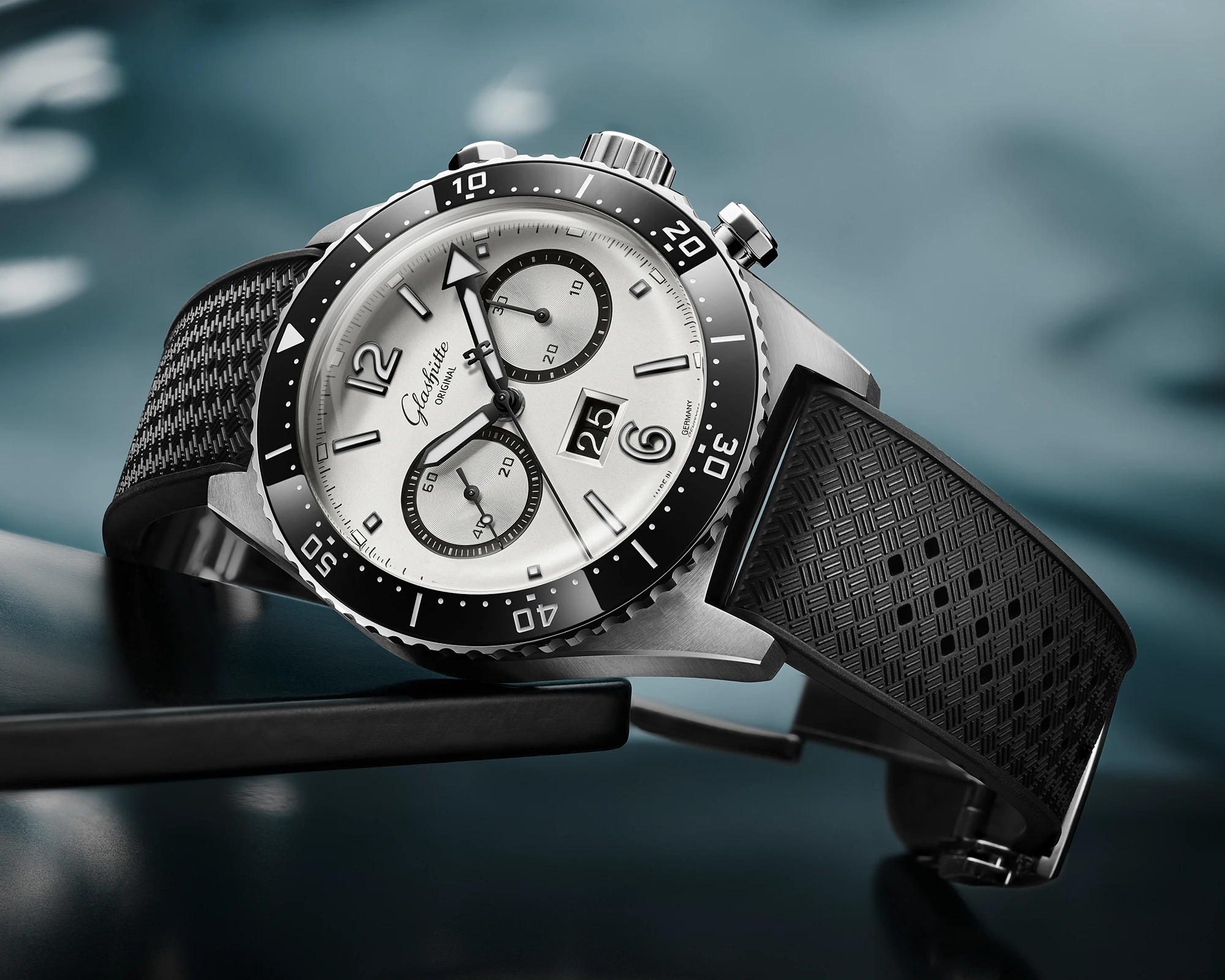
The original was quite small with a diameter of 36 millimetres
In addition to the rather large top model, there is also a classic version of this watch with a diameter of 39.5 millimetres, easily distinguishable by the indices and hands and the historicizing luminous material in the “Old Radium” style. It goes back to the historical model mentioned at the beginning, which actually only had a case diameter of 36 millimetres. These models are currently opening up completely new customer groups for the manufactory. This also demonstrates the enormous strength of Glashütte Original’s ability to gain a foothold with a certified diver’s watch without compromising the image of the manufacture’s fine watchmaking. The movements of the SeaQ are, of course, all finely finished by hand.
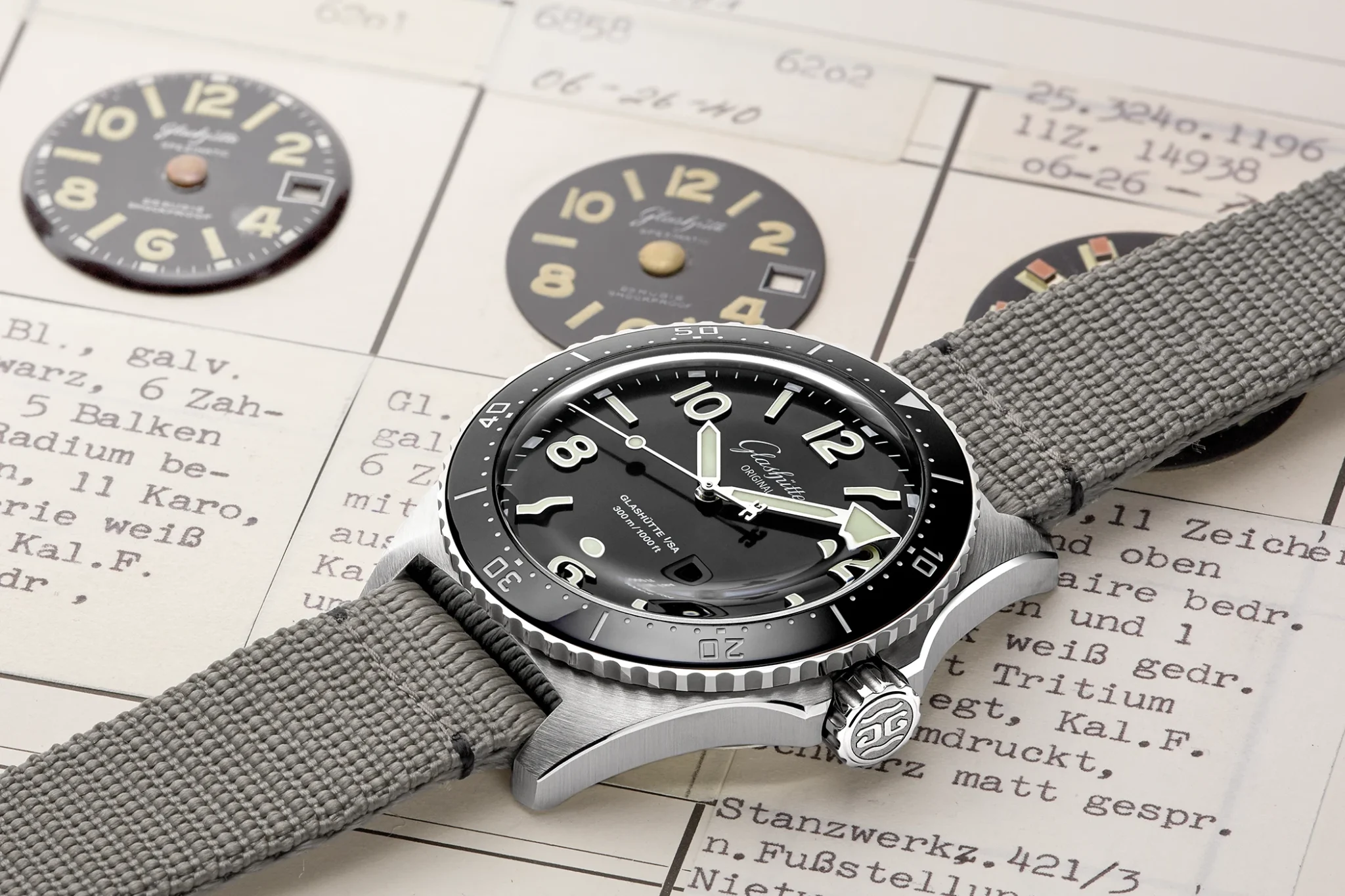
A meeting with the CEO
Before I make my way back to the exit, I meet the CEO of Glashütte Original, Roland von Keith, who, alongside his designer, who has been responsible for the design of Glashütte Original for over two decades, take some time for Swisswatches. The latter has brought along the two platinum highlights, the Senator Chronometer Tourbillon Limited with laser engraving and the PanoMaticInverse with a hand-engraved Dresden city silhouette.

Von Keith seems satisfied with the direction in which he himself has been steering the company for the past six years. Even if the company doesn’t talk about figures, the brand is internationally successful: while the Spezialist series together with the Pano collection make up the largest share of watches sold, especially in Europe and the USA, in Asia it’s more the classic Senator models and those with a Panorama Date, as he tells me.
Which rare watches from Glashütte Original should you know as a collector?
Finally, the question remains as to which outstanding watches collectors should really know. At the top of the list is the flying tourbillon, which was introduced at the company’s relaunch in 1995 and whose design was of course the brainchild of Glashütte master watchmaker Alfred Helwig. In 1995, this mechanism was realized for the first time in a mechanical wristwatch; at the time, it was the most expensive and most complicated watch made in Germany.
A mechanical wristwatch for 350,000 German marks
The Julius Assmann Tourbillon, which was presented just 374 days after the company took over, cost 350,000 German marks at the time of its presentation. Its presentation took place at Albrechtsberg Castle in Dresden, exactly 150 years after the watchmaker’s arrival in Glashütte. However, the flying tourbillon could only be admired on the back of this model. This was followed in 1996 by the “Alfred Helwig Tourbillon” with the flying tourbillon mechanism on the dial side, the first prototype of modern mechanical wristwatches, which today is so highly prized by collectors all over the world, even in Swiss models.
The world’s first mechanical chronograph with countdown
Another world first was the PanoRetrograph in 2000 with the first mechanical countdown in a chronograph, which also had an alarm signal thanks to a built-in gong. For the first time, this countdown timer was able to register and count down a set time interval. An acoustic signal sounded at the end of the process.
All 52 calendar weeks at a glance and a mechanical diary
This was followed in 2006 by another unusual wristwatch displaying the 52 calendar weeks. In 2007, Glashütte Original launched a remarkable split-seconds chronograph with the hand-wound Calibre 99, also developed in-house. The Senator Appointment Calendar presented in 2010 also had a completely new function: the reminder function can take place over the course of a month, mechanically of course.
What makes a Glashütte Original wristwatch special today?
Let’s come to perhaps the most important question: What makes a Glashütte Original watch so special? Apart from the unique history, in which the changing economic and political systems of the last almost 200 years of human history have played a formative role, the originality of the watches today can be recognized by fans with the naked eye. The watches developed in Glashütte and their movements, coupled with a unique vertical range of manufacture and an independent design that is increasingly attracting worldwide attention, stand for themselves. For us at Swisswatches, it is above all the elegant restraint that makes models from this manufacture so special, especially in times when new watches are increasingly being offered like seasonal fashion products.
Uncompromising quality standards and a bold comparison
It is no coincidence that I am reminded of the Geneva-based manufacturer Patek Philippe as I leave the gigantic atrium. The two houses have a lot in common, even if some might want to disagree, mainly because of the fundamentally different ownership structures: on the one hand the family-run manufacture, on the other, the subsidiary of a stock corporation. But this is too superficial a view: Glashütte Original enjoys the greatest possible independence within the Swatch Group and also benefits from the synergies of a group, for example in the development of an international distribution network or global reputation. And in the end, a good 44 percent of the Swatch Group is owned by the Hayek family. In other words, the very family without whose commitment the Swiss luxury watch industry would not exist today.

Many similarities with Swiss manufactures
If you look behind the scenes, there are more similarities than differences between large family-run, independent Swiss brands and Glashütte Original. The vertical integration of the houses is comparable, as is the quality of the craftsmanship and the uncompromising quality standards on site at the manufacture. The power of innovation is written into the genes of such manufactures: Glashütte Original can even claim a higher in-house value creation than many Swiss manufactures. The chronometer test, which is even higher than the standards of the German Chronometer Testing Institute and the Swiss COSC, is also considered more meaningful. And charmingly, Patek Philippe also has its own dial production, and the history of the Stern family can even be traced back directly to a dial manufacturer.


The courage to remain true to oneself
I was particularly impressed by the similarly courageous approach to tradition and innovation in very different model lines, which is maintained even when short-lived trends on the market may demand something different. But they also don’t block the latest technologies such as silicon coils.
High profile thanks to its rarity
But that is just one thought on the way back to Dresden from the small valley in the Eastern Erzgebirge with its fascinating history. After the return journey, when talking to friends in Germany, it is always noticeable: as far as rarity is concerned, as a Glashütte Original customer today, you can even still be happy to wear a Glashütte Original unrecognised at a standing reception and not be approached unpleasantly from the side because of some talking piece. The watches are still rare, and you are still in a very exclusive circle in this country. Equally pleasing is the fact that Glashütte Original offers a very wide range of case materials from stainless steel to platinum, without the price structure being completely out of touch with reality. On the contrary: when it comes to Glashütte Original’s prices, some people will be surprised at how much watch they get for their money and how much attention to detail they get compared to some of the big Swiss manufactures. Thinking back to the story of the ‘Original Glashütte’ seal of quality, I have to smile.
The term Glashütte remains protected
Incidentally, the term Glashütte has been protected in the same way as Swiss Made since 2022. That sounds obvious, but in this country, it is not at all: the so-called Glashütte Ordinance passed the German Federal Council on February 11, 2022. Anyone who wants to advertise with the name Glashütte must adhere to the strict requirements of the ordinance: at least 50 percent of a watch’s value creation must take place within the city limits. This is only the second geographical designation of origin to be protected by German law since 1938, after Solingen for Messer. For Glashütte Original, protecting the name makes no difference: the term Original has always been both an obligation and a claim. With a vertical range of manufacture of over 95%, there is no real need to worry about the originality of its products. Carrying the name of a special city in its name, which is now doubly protected in addition to its own trademark rights, only seems to spur this manufacture on to ever new heights.
